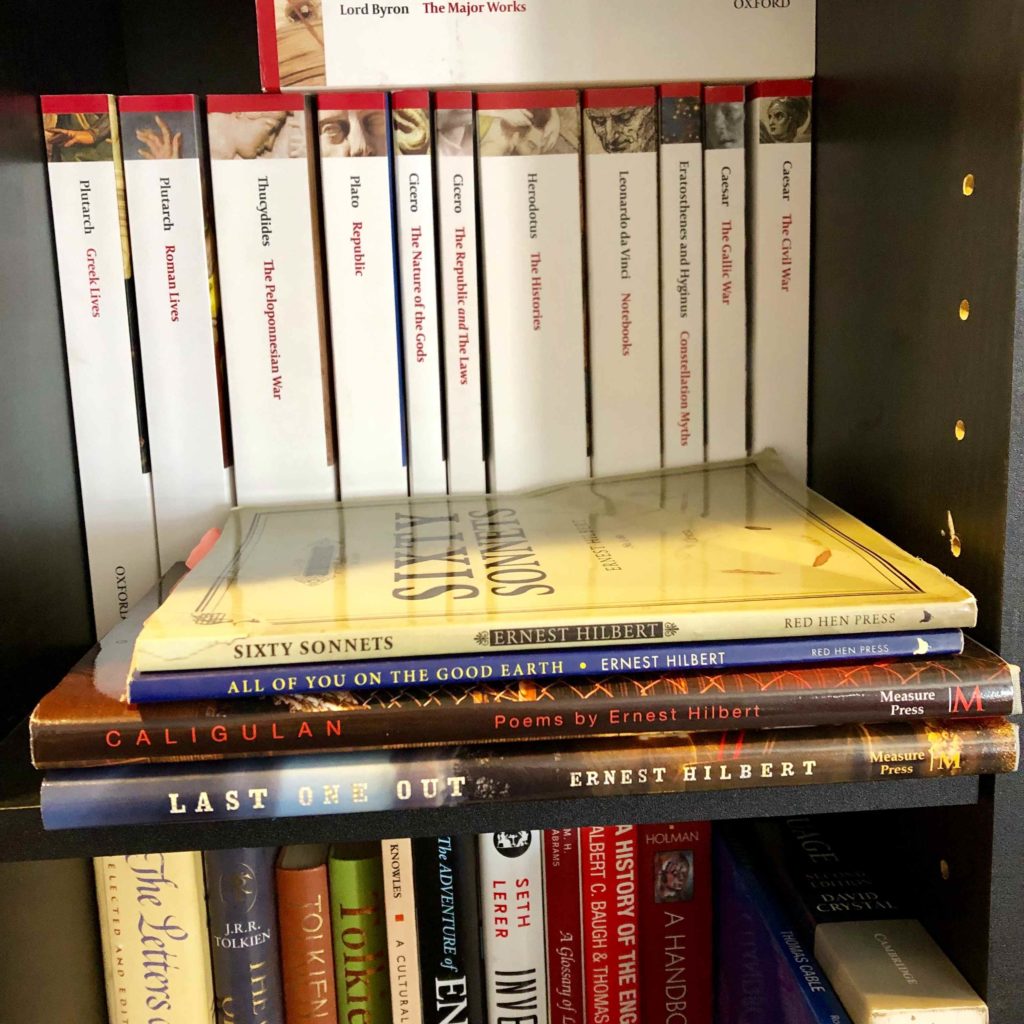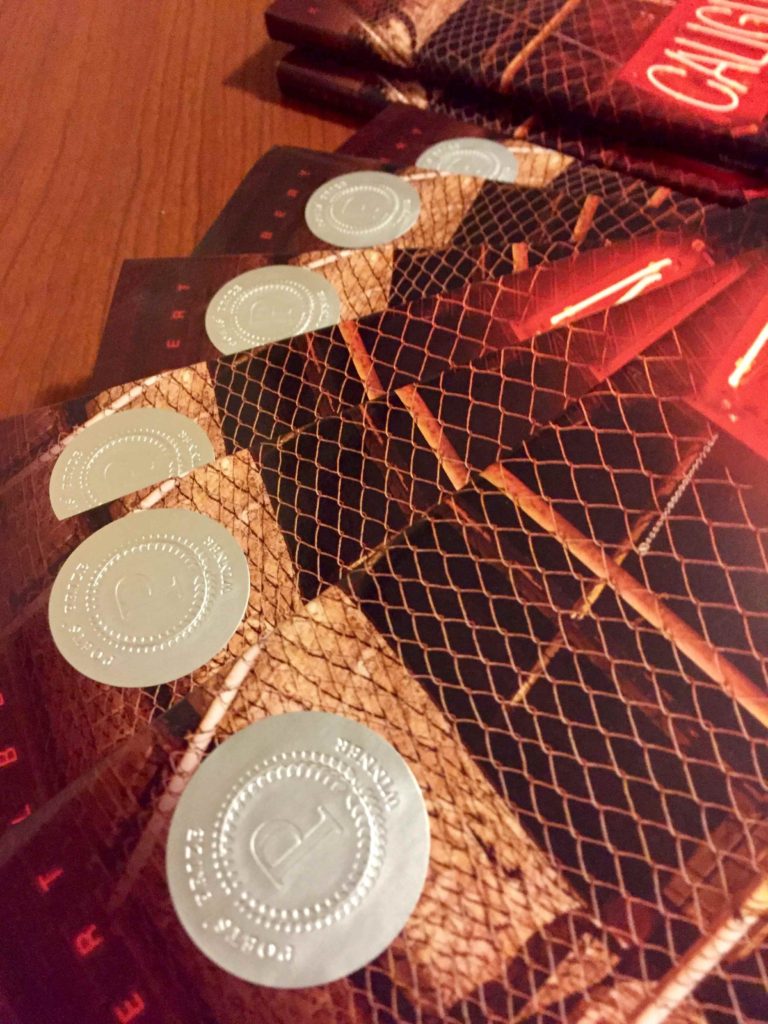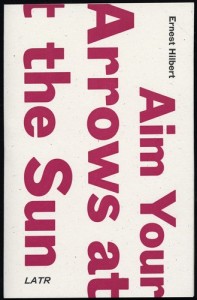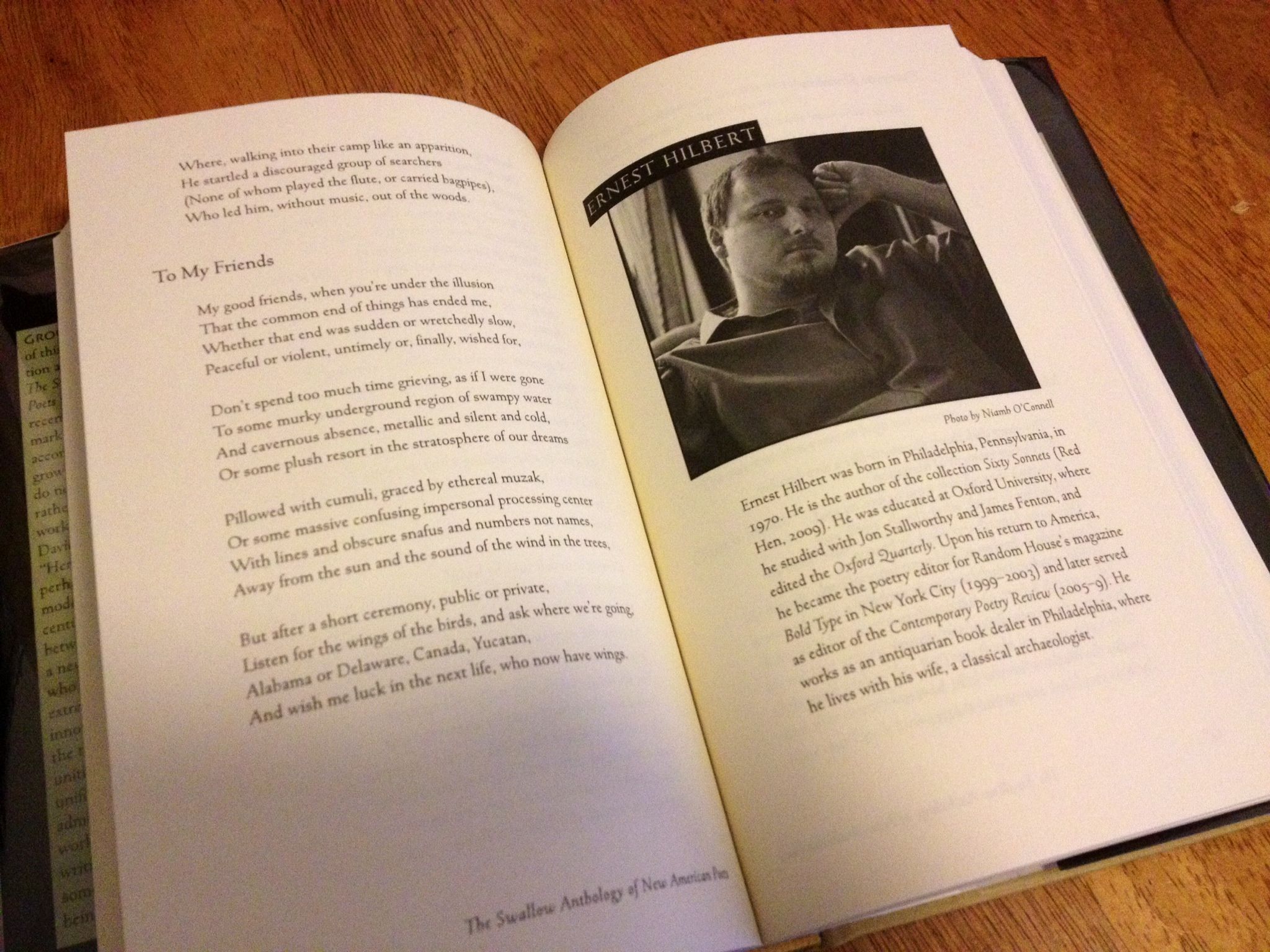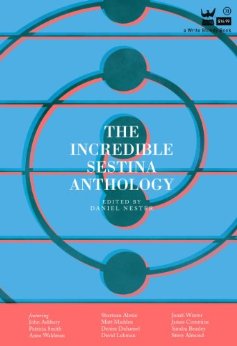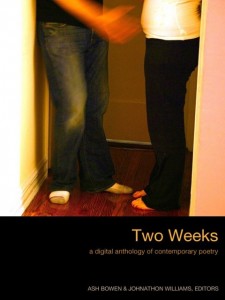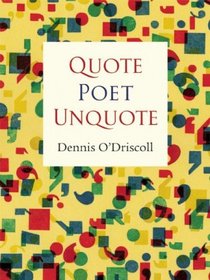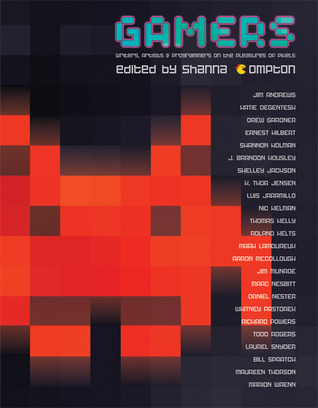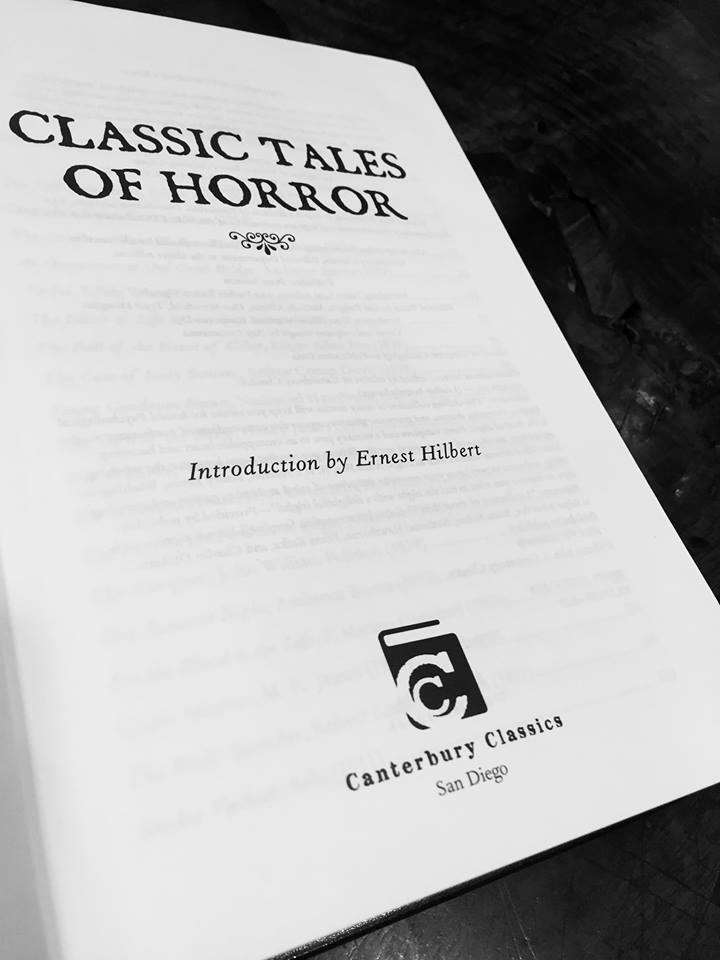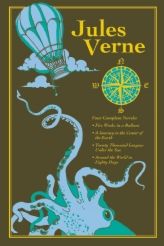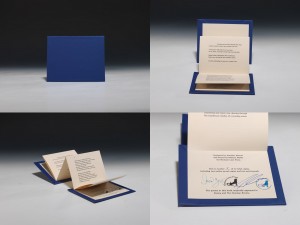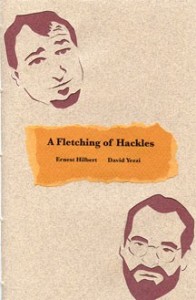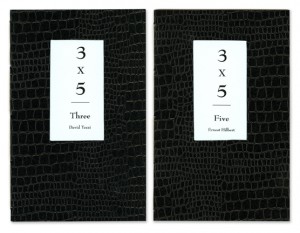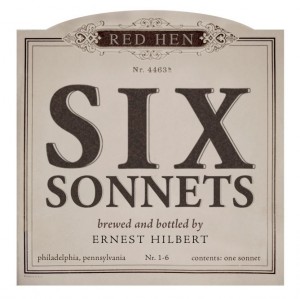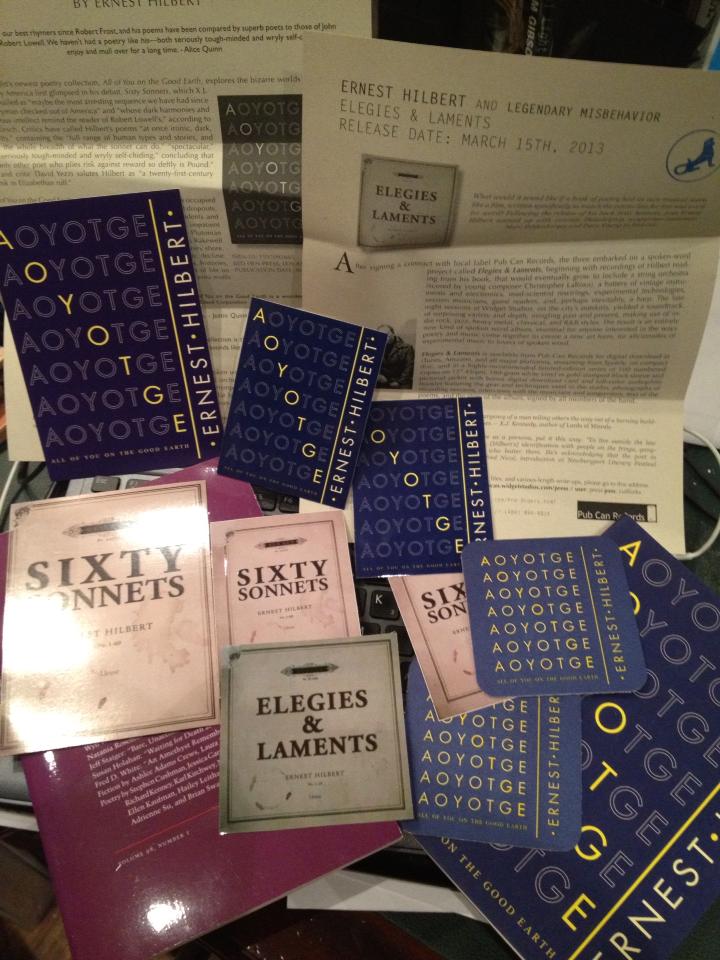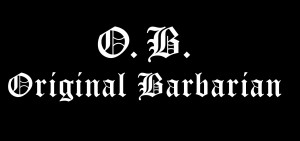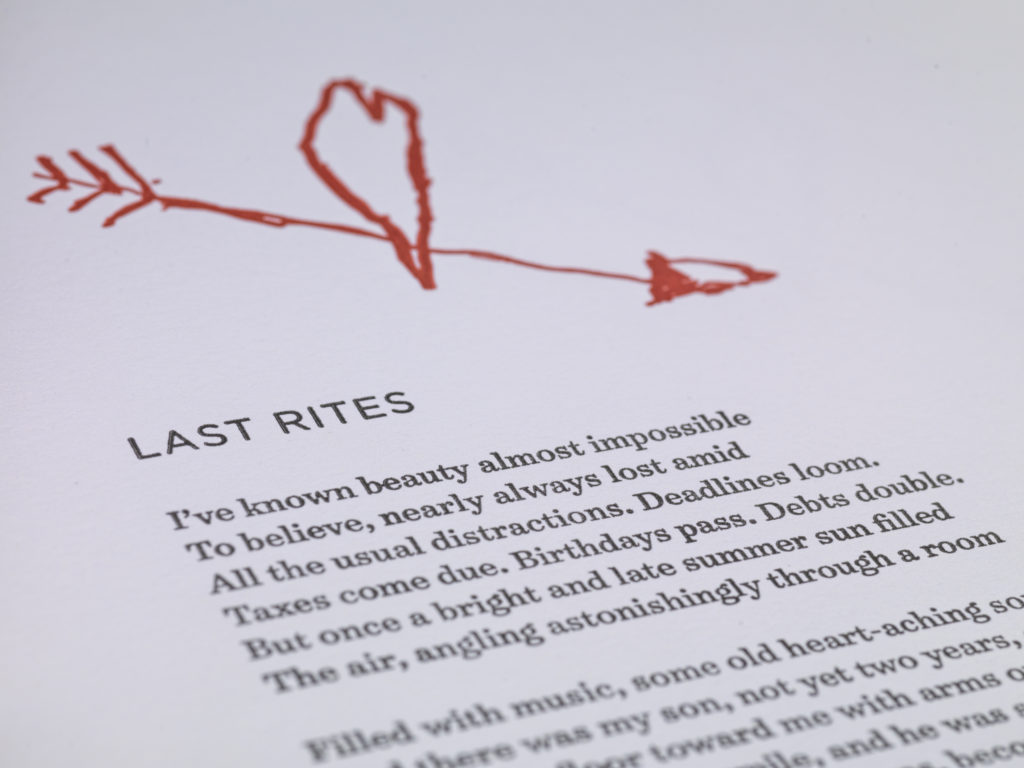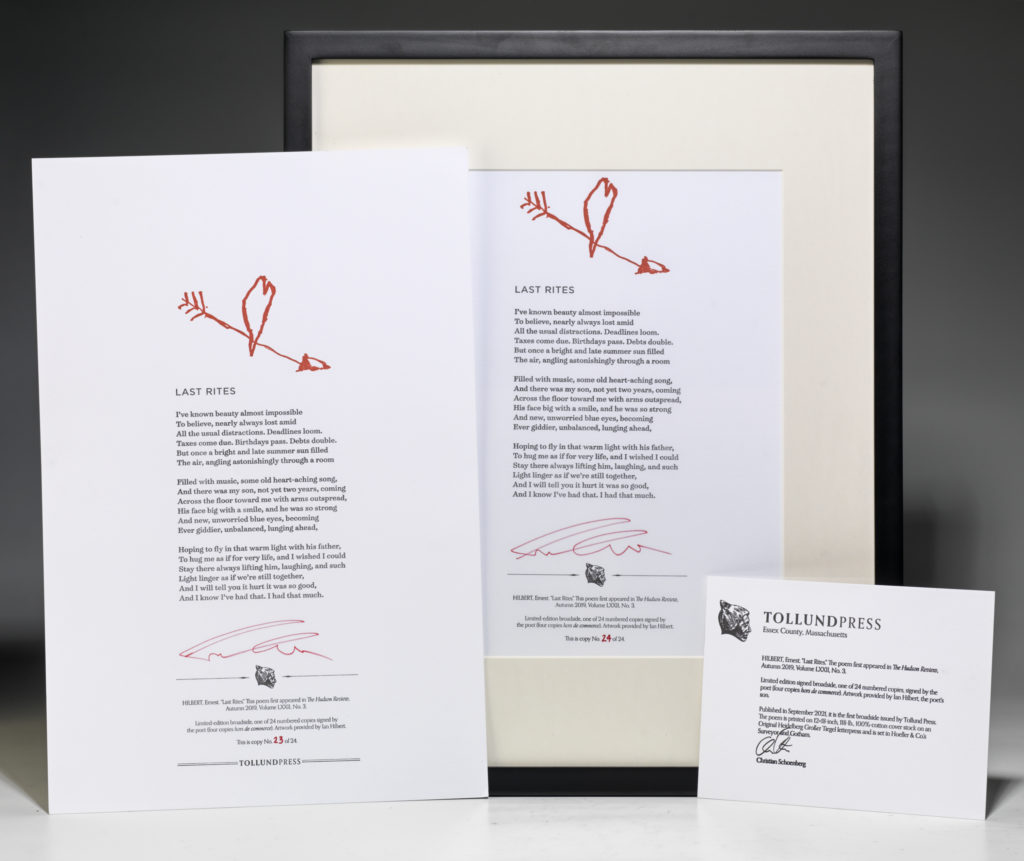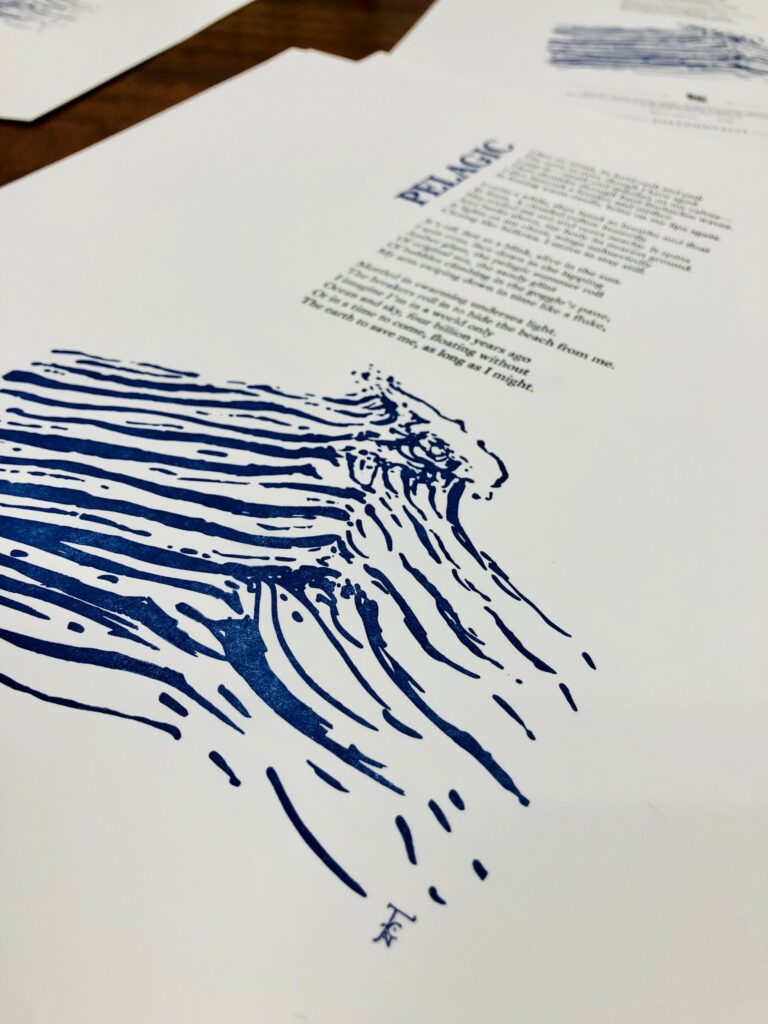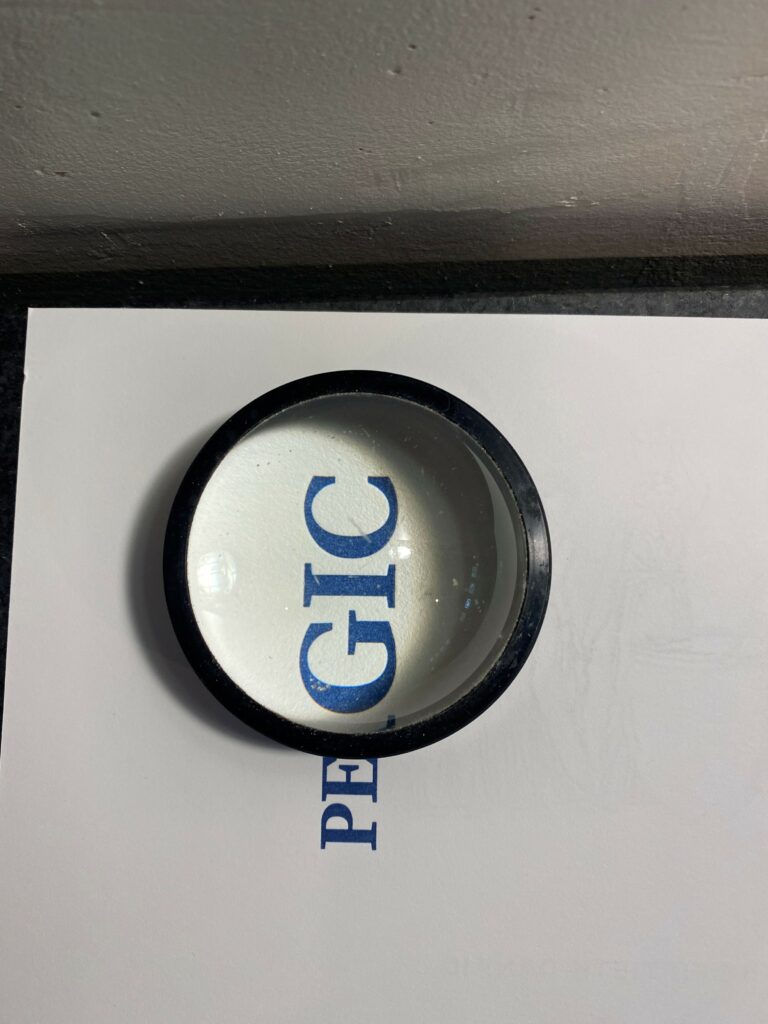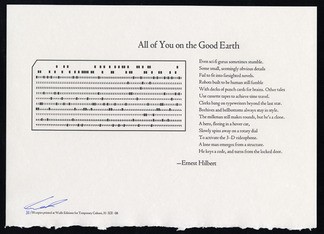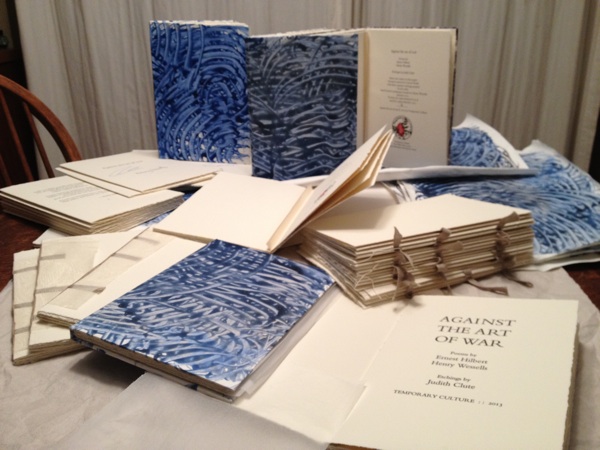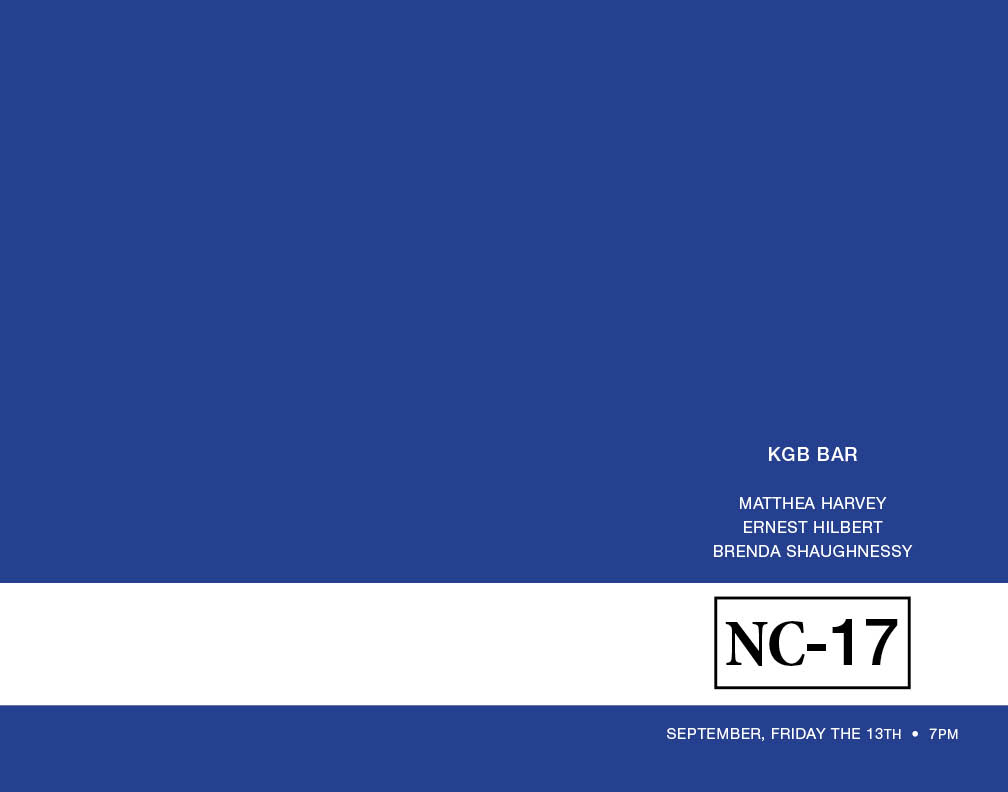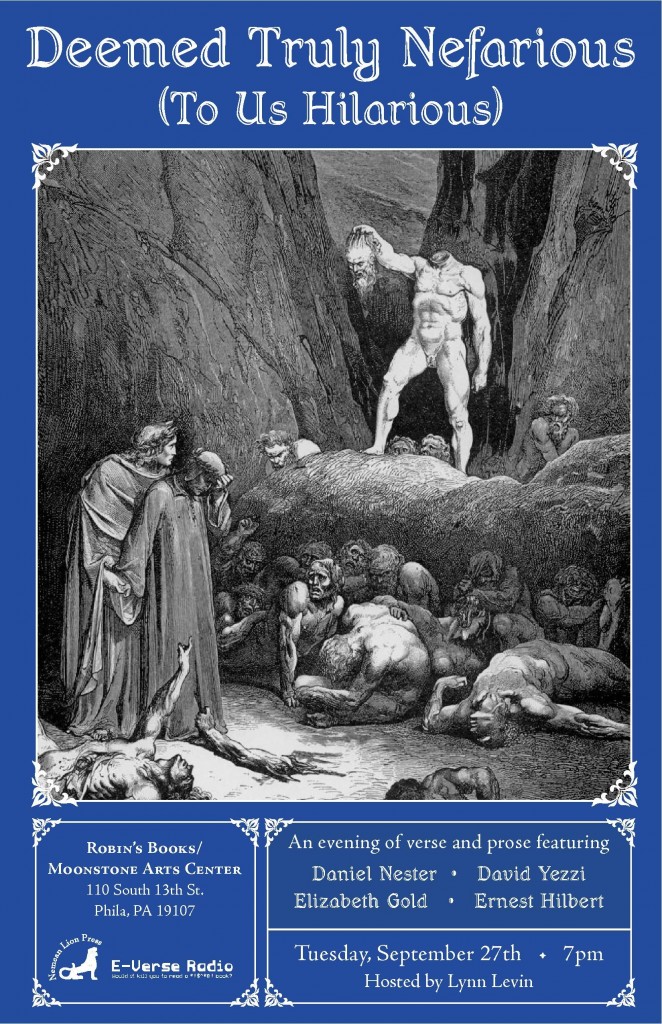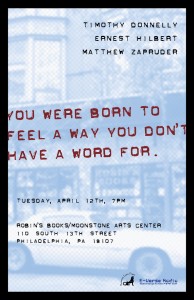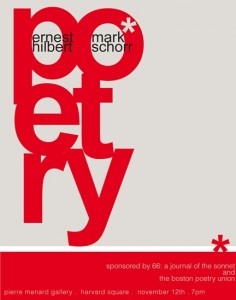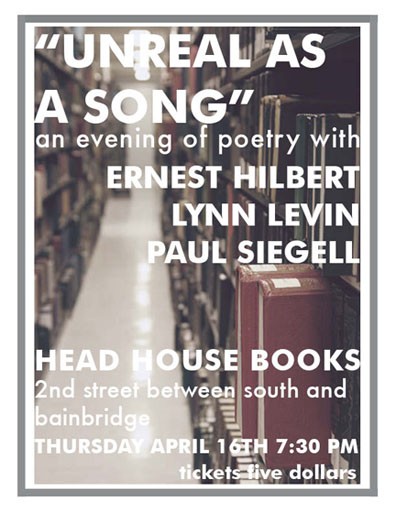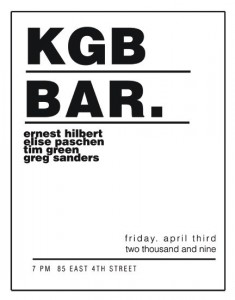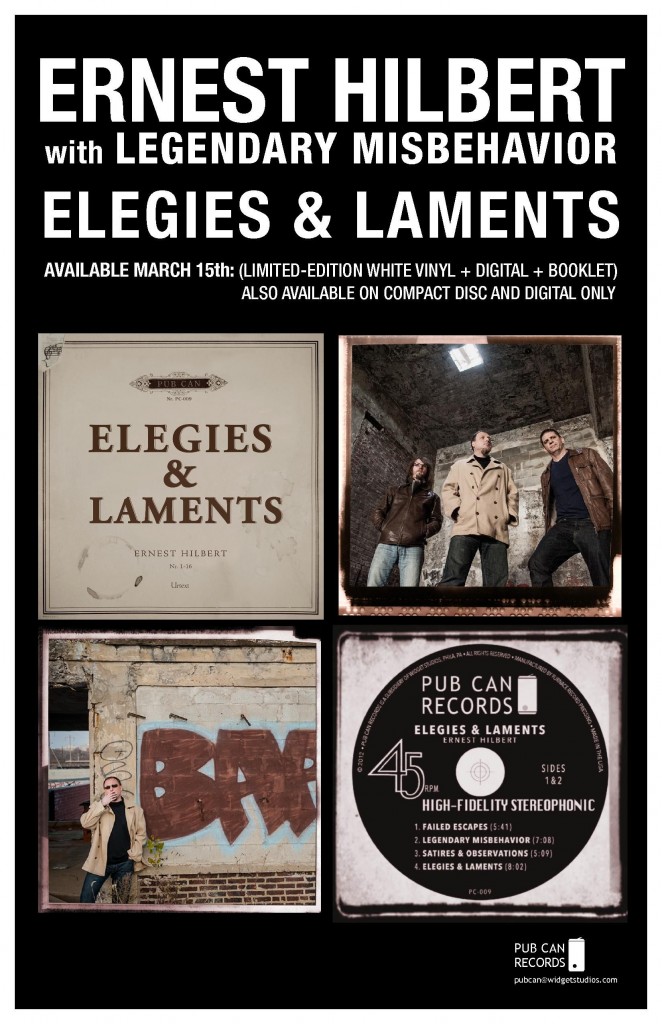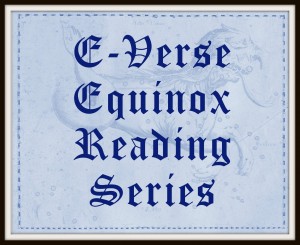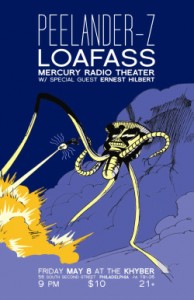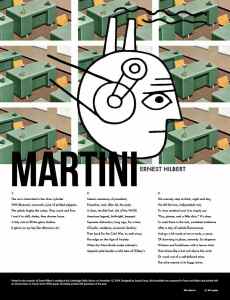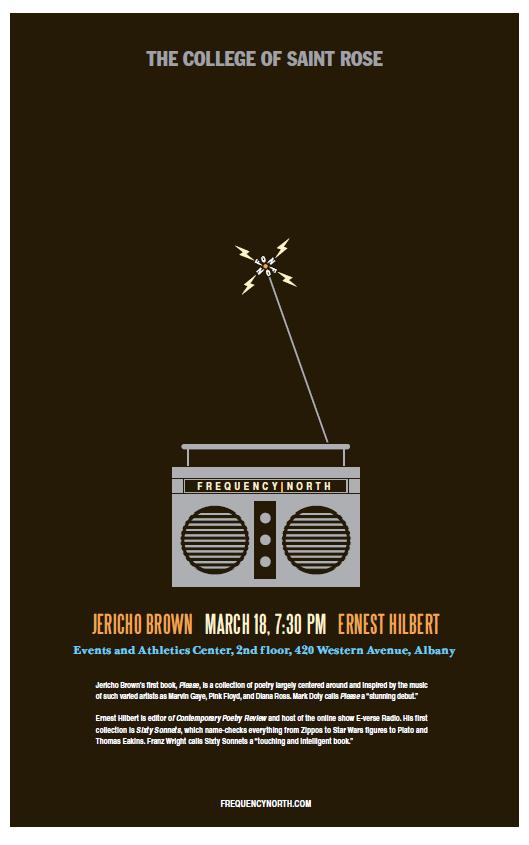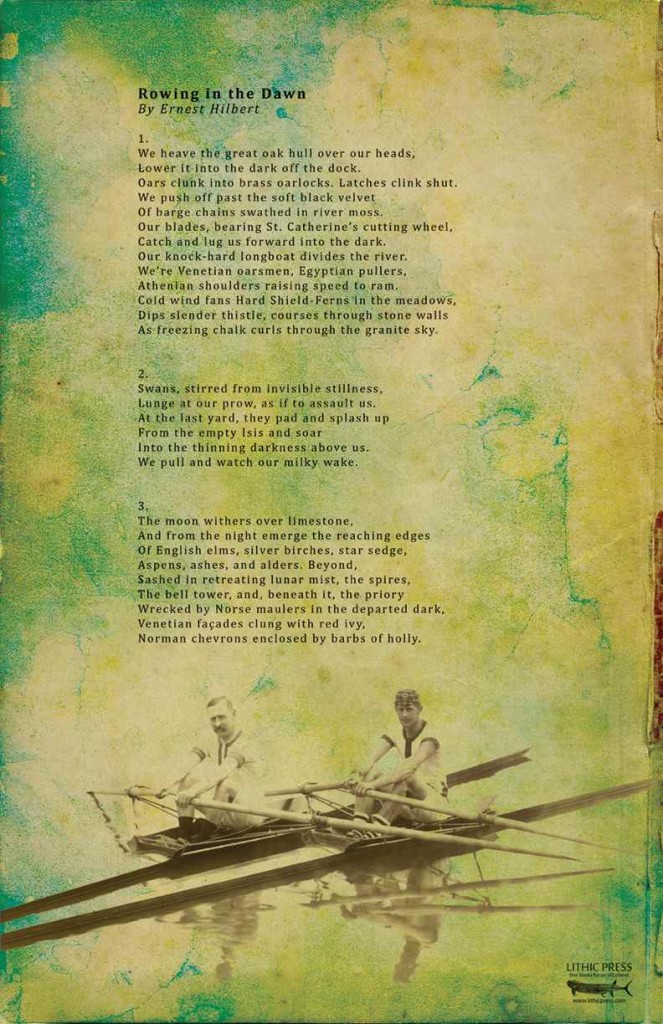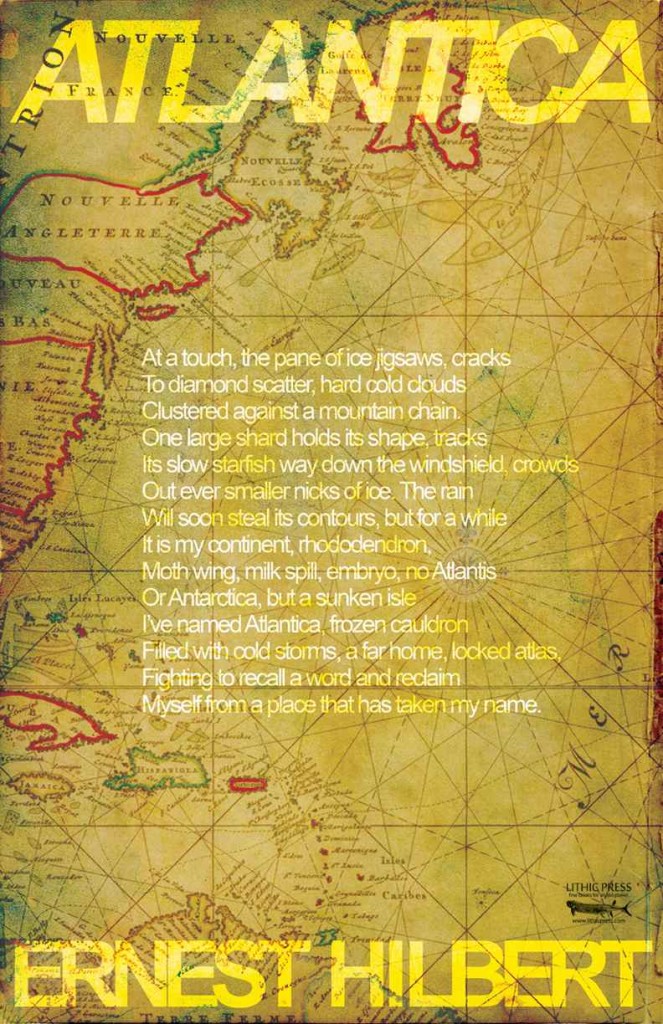“EVERYTHING IN THIS BEAUTIFUL BOOK LIVES”
HILBERT, Ernest. Storm Swimmer. Denton, TX: UNT Press, 2023. Octavo, stiff paper wrappers, 6” by 9.” $14.95. ISBN-13: 9781574418958. E-Book also available for download.
Storm Swimmer, Ernest Hilbert’s fifth collection of poetry, was selected by Rowan Ricardo Phillips as winner of the 2022 Vassar Miller Prize in Poetry. The book will be published by UNT Press on April 15th, 2023 (prepublication copies will be available at AWP in Seattle) and is available for preorder starting December 1st, 2022. Visit University of North Texas Press for review copies and examination copies.
Order from Barnes and Noble, Powell’s, Waterstones (UK), Thrift Books, Discover Books, Sandman Books, Amazon, Walmart, Amazon Canada, Bookshop.org, Book Depository, Buscalibre (Argentina, Spain, Chile, Colombia, México, Perú), Booktopia (Australia), Mighty Ape (New Zealand), Hugendubel (Germany), Libris (Netherlands), Adlibris (Sweden), Thalia (Germany, Austria, and Switzerland), Kinokuniya (Japan), Prince Books, La Feltrinelli (Italy), and Books-a-Million.
Ernest Hilbert’s fifth collection, Storm Swimmer, electrifies readers with an array of astonishing scenes, all captured in exquisitely imagined lines. Tender poems of fatherhood weigh against unsettling explorations of natural dangers and intimations of bodily harm. In poems that celebrate survival and renewal, Hilbert summons the ageless conflict between human affection and the passing of time, recognizing that all we love must eventually disappear. From porn sets to seedy gun ranges and heavy metal tribute nights in crumbling theaters, Hilbert’s eye roves over the desolation and beauty of contemporary America, all the while feeling the irresistible pull of water—what Melville called “the ungraspable phantom of life.” For Hilbert, water is “a universe that loves the dark / And bears you up as if you had no weight.” His poems return again and again to rivers, lakes, and the sea, there to find “a universe that loves the dark,” one that “bears you up as if you had no weight.” Critics have hailed Hilbert’s poems as “original and essential,” “haunted by loss,” “brutal yet beautiful,” defined by “pleasure, clarity, and discipline,” “tough-minded and precise,” “elegant and athletic,” and “human and moving.” Continuing the tradition, Storm Swimmer is a book of terrific assurance and range, a must for any lover of modern American poetry.
“I’m deeply moved by Ernest Hilbert’s new collection—his fifth—called Storm Swimmer. That title captures the harrowing action of this book perfectly. In these poems, the joys of fatherhood are hounded by the certainty of death, the undeniable delicacy of human life set against the beautiful chaos of nature. But ultimately it’s not the shadow of despair that colors these pieces; it’s the flame of his resistance. ‘I know we’re dust,’ he writes, ‘and stardust too, but more.'” – Ron Charles, Washington Post Book Club
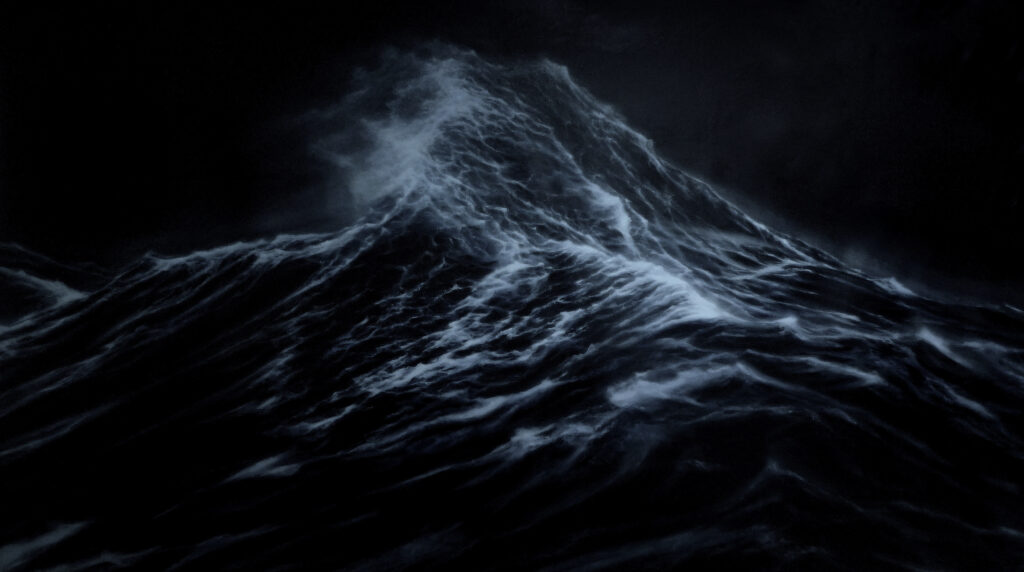
Cover art, “La Furie” by Paris-based Chilean painter Franco Salas Borquez (2016, 65 × 122 in), courtesy of the artist and M Galerie Boston, from a private collection. The book cover title is set in Trade Gothic Bold; the author’s name in Filosofia OT regular; and the prize citation in Corundum Text Book SC. The book’s logo for use t-shirts, stickers, and magnets hand-drawn by heavy metal logo designer ModBlackmoon (Irina Karotkaya).
“Riddle Me” was written specifically as NFT (nonfungible token) art, listed for sale on OpenSea, a peer-to-peer marketplace for rare digital items and crypto collectibles housed at the Hunter College MFA program in New York City. It was posted for sale on March 18, 2021, and sold to a private collector on July 2 the same year. The poem “Last Rites” appeared as a limited-edition letterpress broadside, issued by Tollund Press of Essex County, Massachusetts, in summer 2021 in an edition of twenty-four numbered copies, signed (four copies hors de commerce), with artwork provided by Ian, the author’s son. The poem “Pelagic” appeared as a limited-edition letterpress broadside from Tollund Press in summer 2022 in an edition of sixty numbered copies, six signed and sealed in bottles, three to be deposited into the gulf stream. “Appeal” was selected as a Laureates’ Choice winner in the 2021 Maria W. Faust Sonnet Contest, Great River Shakespeare Festival.
The epigram from Giacomo Carissimi (1605–1674) can be translated as “my heart is a sea of tears,” a line from the duetto “Partenza dalla sua Donna.” The poem “Remains” does not refer to any real place or history. Lancelot Andrewes described “solsitio brumali” as “the very dead of winter” or the winter solstice. The Latin term “spolia opima” translates as “rich spoils” and refers to the trophies a Roman general stripped from the corpse of an enemy slain in single combat. “Stercus Diaboli” is “the Devil’s shit.” William H. Race translates the epigraph to this book, from the Argonautica, as:
And likewise the other heroes boarded and took their seats in order and grasped the oars in their hands. Argus loosed for them the stern cables from under the sea-washed rock. Then they began striking the water mightily with their long oars. At evening, on Orpheus’ instructions, they put in at the island of Electra, Atlas’ daughter, so that by learning secret rites through gentle initiations they might sail more safely over the chilling sea. Of these things, however, I shall speak no further, but bid farewell to the island itself and to the local divinities, to whom belong those mysteries of which I am forbidden to sing.”
The epigraph to chapter seven is from book five of The Odyssey, translated by Samuel Butler as: “Thereon he floated about for two nights and two days in the water, with a heavy swell on the sea and death staring him in the face; but when the third day broke, the wind fell and there was a dead calm without so much as a breath of air stirring.”
* * *
“LAST ONE OUT IS A VERY BEAUTIFUL BOOK . . . IT SINGS”
 HILBERT, Ernest. Last One Out. Evansville, IN: Measure Press, 2019. Tall octavo, full fossil-gray cloth, pictorial dust jacket. $25. ISBN-13: 978-1939574299
HILBERT, Ernest. Last One Out. Evansville, IN: Measure Press, 2019. Tall octavo, full fossil-gray cloth, pictorial dust jacket. $25. ISBN-13: 978-1939574299
Available from Amazon, Amazon UK, Amazon France, Barnes & Noble, Powell’s, Books a Million, Waterstones (UK), Book Depository, Russell Books (Canada), Readings (Australia), Fishpond (Australia), Booktopia (Australia), Adlibris (Denmark), Kraina Ksiazek (Poland), Alibris, BOL (Netherlands, Belgium), Adlibris (Finland), Percuma Penghantaran (Malaysia), Wordery, directly from the publisher, and in better bookstores (if it is not in stock, most booksellers can have it within a day or two on request).
Ernest Hilbert’s fourth collection, Last One Out, traces the poet’s life from childhood memories of his father, both elegiac and nostalgic, to poems of celebration on the birth of his own son. Along the way, myth and history mingle with private reminiscences, drawing the reader from the haunted halls of the Chelsea Hotel to tank-littered Sinai battlefields, the tough streets of Philadelphia to the siege of Leningrad, as he dines with representatives from Vatican Museum, rows in the Oxford dawn, and scales retreating glaciers. This new volume finds Hilbert in his element, always the daring explorer, avid performer, and vexed observer of the terrors and temptations of the modern world and the troubled history from which it proceeds. Last One Out represents a decade’s effort, an astonishing achievement and essential reading.
Poet Ilya Kaminsky proclaims “Last One Out is a very beautiful book. It sings.” Jason Guriel, author of The Pigheaded Soul: Essays and Reviews on Poetry and Culture, writes “These are well-made, moving poems, designed with our pleasure in mind.” Robert Archambeau, author of Inventions of a Barbarous Age: Poetry from Conceptualism to Rhyme, calls Last One Out “a journey, taking us from images of the poet as bereaved son to a portrait of the poet as protective and loving father. Take the trip.”
The poems in the collection first appeared in Academic Questions (National Association of Scholars), American Arts Quarterly, American Journal of Poetry, American Poet (Academy of American Poets), Asheville Poetry Review, Barrow Street, Battersea Review, Boston Review, Clarion (Boston Poetry Union), Connotation Press: An Online Artifact, The Dark Horse, Drunken Boat, Edinburgh Review, Fruita Pulp, Hopkins Review, Horizon Review, Jacket, Literary Imagination, Literary Matters, Measure, Meridian, Modern Drunkard, The New Criterion, The New Republic, Oxonian Review, Parnassus, Per Contra, Philadelphia Inquirer, Pleiades, Plume, Poetry Northeast, Raintown Review, Sewanee Review, Smartish Pace, Southwest Review, Think Journal, Verse, Vocabula Review, and The Yale Review. “Mars Ultor” appeared in Best American Poetry 2018, published by Scribner, a division of Simon & Schuster. It was also included in the protest anthology Donald Trump: The Magazine of Poetry. The following poems appeared in the chapbook Aim Your Arrows at the Sun, LATR Editions, New York City, in an edition of 250 copies, hand-sewn, in letterpress wrappers: “On Passing the Remains of a T-62 in the Sinai,” “At the 100th Anniversary of the Antiquarian Booksellers Association at the Royal Geographical Society,” “Haunts,” “Aim Your Arrows at the Sun,” “Bread and Circuses,” “As the Lost Kings Uphold My Side,” “Dining with Representatives of the Vatican Museum,” “Surrender of Breda,” and “Disasters of War.” “Great White Fleet” and “In Memory of a Writer” were reprinted in The Best of The Raintown Review: 2010-2015. “The Haywain” appeared on the website Poetry Daily. “Against the Art of War” originally appeared in a letterpress edition Against the Art of War, published by Temporary Culture, with three tipped-in aquatint etchings by London-based Canadian artist Judith Clute and an additional anti-war poem by Henry Wessells, printed by David Wolfe of Portland, Maine, hand-bound in paste-paper boards, in an edition of 26 lettered copies, signed by the authors and the artist, and five numbered copies reserved for artist, authors, and printer. Institutional collections holding copies of the book include the Lilly Library (Indiana University), Rubenstein Library (Duke University), the Beinecke Library (Yale University), and Poets House in New York City. “My Father’s Dante” was selected as a Laureates’ Choice for the 2016 Maria W. Faust Sonnet Contest. “Rowing in the Dawn” appeared in 2014 as a limited-edition full-color broadside from Lithic Press in Colorado. “Martini” appeared as a signed limited-edition broadside designed by artist Jessica Tanny and issued by the Cambridge Public Library on the occasion of Ernest Hilbert’s reading there on November 13th, 2014, in an edition of 60 numbered copies, 1-10 signed by author, artist, and promoter Daniel Wuenschel, 11-25 signed by Hilbert only, 26-40 and 51-60 unsigned, and 41-50 signed by Hilbert exclusively for subscribers, including the Woodberry Poetry Room at Harvard University.
A recording of Hilbert reading “Haunts,” recorded by Danielle Fox, aired twice on WHYY FM, Philadelphia’s NPR Station, 90.9 MHz, as part of a National Poetry Month feature on Morning Edition, hosted by Jennifer Lynn, on Tuesday, April 24th, 2018. “Kingsessing Avenue” appeared as part of the City of Philadelphia Office of Arts, Culture and the Creative Economy’s “Write Your Block” project, documenting Philadelphia neighborhoods. A recording of “Walnut Street” was broadcast on Georgia State Radio, WRAS 88.5 FM, and its affiliates on May 1st, 2015 as part of the program “Locals Only: Philly.”
The epigraph to chapter three is from the Anglo-Saxon poem known as “The Wanderer,” which appears in Codex Exoniensis or The Exeter Book. It may be translated as “Where is the giver of treasure? / Where are the places at the feast? / Where are the celebrations in the hall?” Non Omnis Moriar appears in Horace’s Carmina 3/30:6 and may be translated as “I shall not wholly die.” The cover photograph by Matthew Wright was taken on Old Highway 99 South, Ashland, Oregon, 97520, latitude 42.0919, longitude -122.5896, with a Nikon D850 on a 30 second delay, f/16 24mm. The gray cloth binding places the book in the company of first editions of W.H. Auden’s Look, Stranger! and Philip Larkin’s High Windows. Publication events for the book took place at the Rosenbach Museum & Library in Philadelphia and the Grolier Club in New York City. First issue, with “motions of a ghosts” on rear dust jacket panel (later corrected to “motions of a ghost”) and “author photograph by Richard Malouf, © 2015” on copyright page (later removed because the author photograph by Malouf never appeared on the dust jacket).
* * *
“BRUTAL AND YET BEAUTIFUL”: CALIGULAN BY ERNEST HILBERT
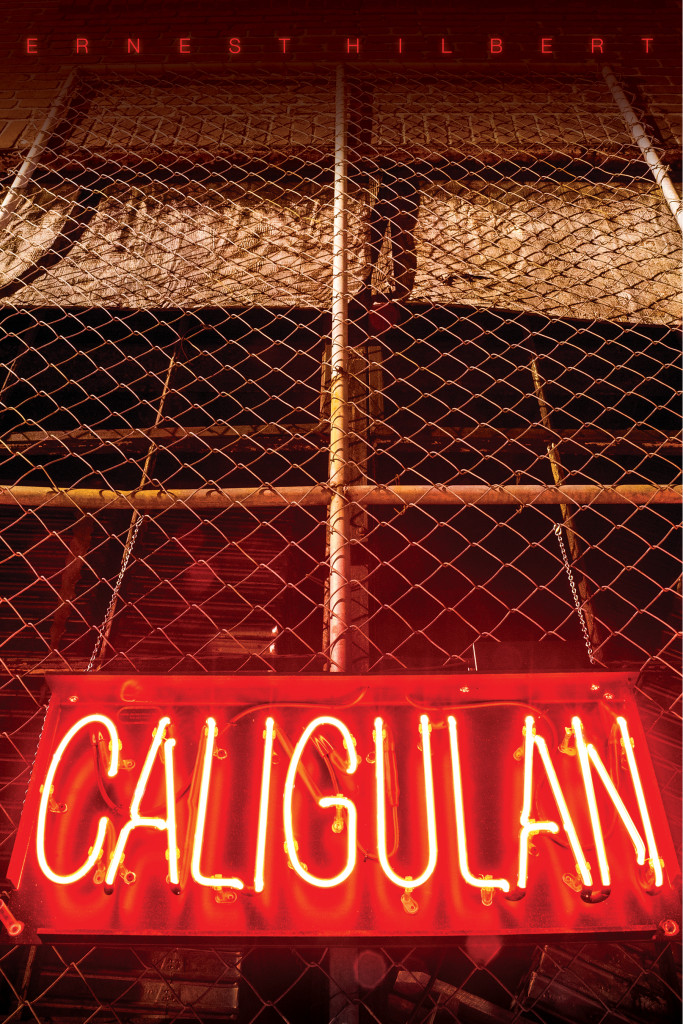 HILBERT, Ernest. Caligulan. Evansville, IN: Measure Press, 2015. Tall octavo, full fossil-gray cloth, pictorial dust jacket. $20. ISBN-13:978-1-939574-13-8
HILBERT, Ernest. Caligulan. Evansville, IN: Measure Press, 2015. Tall octavo, full fossil-gray cloth, pictorial dust jacket. $20. ISBN-13:978-1-939574-13-8
Available from Amazon, Amazon UK, Barnes & Noble, Powell’s, Books a Million, Waterstones, Amazon Spain, Book Depository, Russell Books (Canada), Booktopia (Australia), Adlibris (EU), Kraina Ksiazek (Poland),
Percuma Penghantaran (Malaysia), directly from the publisher, and in better bookstores (if it is not in stock, most booksellers can have it within a day or two on request).
Ernest Hilbert’s third collection of poems, Caligulan, is at once terrifying and touching, a book haunted by the poet’s many affections and angers, its poems animated by horror films and science-fiction novels, heavy metal and opera, remote wilderness and ruined cities. Departing from the experimental sonnet forms he pioneered in his earlier books, Hilbert delivers a chorus of poems that are conversational yet bizarre, stormy and surreal yet dexterously accomplished; brash, abrupt, and sometimes scathingly sarcastic. In four chapters of fourteen poems each, Hilbert leads the reader through modern America’s triumphs and tragedies, elusive consolations and primeval horrors, all the while telling jokes, posing questions, and sounding warnings of things to come.
Caligulan was selected as the winner of the 2017 Poets’ Prize. Finalists were Donald Hall’s Selected Poems and Joseph Harrison’s Shakespeare’s Horse. The prize, created in 1988 by Robert McDowell, Frederick Morgan, and Louis Simpson, has recognized the achievements of poets such as Miller Williams, Marilyn Hacker, Maxine Kumin, Adrienne Rich, and Marilyn Nelson. Hilbert read from the collection at a ceremony held at the The Nicholas Roerich Museum in New York City to honor the prize.
The poems in the collection first appeared in American Arts Quarterly, American Poetry Review, Asheville Poetry Review, At Length, Battersea Review, Birmingham Poetry Review, B O D Y, Boston Review, Clarion (Boston Poetry Union), Cleaver, The Dark Horse, Edinburgh Review, Hopkins Review, Hudson Review, Measure, Parnassus, Philadelphia Inquirer, Listen: Life with Classical Music, New Criterion, Smartish Pace, and Yale Review. A recording of Ernest Hilbert reading “Broad and Washington,” engineered by Peter Crimmins, was broadcast on WHYY/NPR 90.7FM as part of the News Works Tonight New Year’s program the evening of December 31, 2013. “Atlantica” appeared in autumn 2014 as a limited edition broadside poster from Lithic Press.

Ernest Hilbert reads from Caligulan at the 2017 Poets’ Prize Ceremony at the Nicholas Roerich Museum in New York City
The book is set in Baskerville. The neon “Caligulan” sign that appears on the book’s cover was commissioned by Hilbert and manufactured by Jantec Sign Group in North Carolina. Cover and author photographs are by Matthew Wright. The dust jacket was designed by Jennifer Mercer, who designed the covers for both of Hilbert’s previous collections as well as the cover of his album. On the dust jacket, Hilbert’s name appears in Helvetica Neue (T1) Regular, inspired by the title sequence to Ridley Scott’s 1979 film Alien. The film’s title sequence, which has been alternately described as a “slight variation on Futura” or “a disjointed version of Helvetica Black,” was created by Richard and Robert Greenberg of R/Greenberg Associates and was their second major film title after Superman (1978). Mercer also designed the “black metal” logo-style “Caligulan” with devil’s tail enfolding the author’s name, admitting that it taxed her to the limit of her “black-metaling skills.” The logo appears on stickers as well as tour t-shirts screen-printed by Devilfish Ink in Philadelphia. The reverse of the t-shirts features the “Sixty Nights from Sixty Sonnets to Caligulan” list of sixty Hilbert readings that comprise his tour for the first two books.
* * *
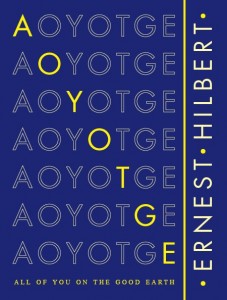 “RAW ENERGY WITH ELEGANT AND ORIGINAL LANGUAGE”: ALL OF YOU ON THE GOOD EARTH BY ERNEST HILBERT
“RAW ENERGY WITH ELEGANT AND ORIGINAL LANGUAGE”: ALL OF YOU ON THE GOOD EARTH BY ERNEST HILBERT
HILBERT, Ernest. All of You on the Good Earth. Los Angeles: Red Hen Press, 2013. Small octavo, paper wrappers. $16.95. ISBN-10: 1597092665
Available from Amazon, Amazon UK, Amazon Canada, Barnes and Noble, Powell’s Books, The Book Depository, Tower Books, BookADDA (India), URead.com (India), BiblioVault, Angus & Robertson (Australia), The Nile (Australia), Open Trolley (Signapore), Fish Pond (New Zealand), Mighty Ape (New Zealand), SuperBookShop (European Union), and Loot (South Africa). It is stocked by Barnes & Noble as well as most quality independent bookstores. It is also available directly from the press itself. Retailers may order through Chicago Distribution Center, 11030 S. Langley, Chicago, IL 60628, phone 800-621-2736, fax 800-621-8476.
All of You on the Good Earth, or AoYotGE, is the much-anticipated sequel to Ernest Hilbert’s critically-acclaimed debut Sixty Sonnets. At the end of the tumultuous year 1968, Apollo 8’s Commander Frank Borman described the earth-rise as sending “a torrent of nostalgia, of sheer homesickness, surging through me.” He signed off: “Good night, good luck, a Merry Christmas, and God bless all of you—all of you on the good Earth.” All of You on the Good Earth guides the reader through chambers occupied by visionary gravediggers, spaced-out movie stars, frenzied dropouts, sullen pirates, and unrelenting stalkers, noble war correspondents and cornered dictators, unlucky drunks and supercilious scientists, impatient goddesses and sad sea monsters, zoned-out denizens of Plutonian strip-clubs and earnest haunters of ancient ruins, the infamous Rakewell in TriBeCa and sea nymph Kalypso in a beach house at the Jersey shore, characters wandering an America demoralized by economic decline. These poems contain fasts and feasts, laments and love songs, histories, fantasies, and elegies, the amusing and heartbreaking debris of life on this world, all the while recalling Seneca’s dictum, non est ad astra mollis e terris via (“the road from the earth to the stars is not easy”). Justin Quinn observes of the collection that “Hilbert has written poems of superb lyricism. It’s hard to think of another poet with such range, and indeed with such brilliant delivery. Beauty, trash, exaltation, and humor are contained in his capacious and exacting forms. These are, quite simply, original and essential poems.” Adam Kirsch has further commented that “there is no mistaking the ‘feral’ appetite and intensity of these poems, or the bitter depths of experience they sometimes explore. What makes All of You on the Good Earth such a rare collection, however, is the way Hilbert unites that raw energy with elegant and original language, creating a style that sounds like no one else’s.” The poems in its pages first appeared in Parnassus, Harvard Review, The London Magazine, The Yale Review, Poetry East, The Oxonian Review, Georgetown Review, American Poetry Review, The New Criterion, The Dark Horse, New Ohio Review, RATTLE, Cimarron Review, and 66: The Journal of the Sonnet. The cover is designed by Jennifer Mercer, based on the cover of the first edition of Ted Hughes’ collection Lupercal, published by Faber & Faber in 1960. The book’s front panel is also an homage to the legacy of the 1970s São Paulo Brazilian Noigandres “poesia concreta / konkrete poesie / concrete poetry” movement. First issue, .75mm width (rather than .5mm), matte wraps in lighter shade of Dignity Blue, 6804 (rather than glossy wraps in the darker Honorable Blue, 6811).
* * *
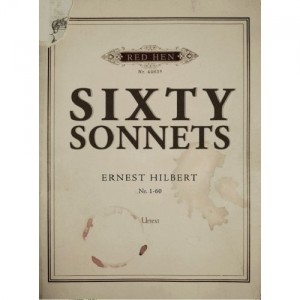 “THE MOST ARRESTING SEQUENCE WE HAVE HAD SINCE JOHN BERRYMAN”: SIXTY SONNETS BY ERNEST HILBERT
“THE MOST ARRESTING SEQUENCE WE HAVE HAD SINCE JOHN BERRYMAN”: SIXTY SONNETS BY ERNEST HILBERT
HILBERT, Ernest. Sixty Sonnets. Los Angeles: Red Hen Press, 2009. Small octavo, paper wrappers. $18.95. ISBN-10: 1597093610
Available from Alibris, Powell’s, Amazon, and Barnes & Noble. Retailers may order through Chicago Distribution Center, 11030 S. Langley, Chicago, IL 60628, phone 800-621-2736, fax 800-621-8476. It is also available for Kindle and for tablets from Sony and Apple iTunes.
“Hilbert’s sure-footed poems have the breathless urgency of a man telling others the way out of a burning building. Unafraid to startle, often winning out over recalcitrant material, they score astonishing successes. A bold explorer with few rivals, Hilbert enlarges the territory of traditional form. Sixty Sonnets may be the most arresting sequence we have had since John Berryman checked out of America” (X.J. Kennedy). “Like the minutes of the hour, these Sixty Sonnets both combine to make a whole and shine as individual moments. While groups of these sonnets occasionally suggest a narrative—refreshingly, like the fugitives and weary academics that people these pages—they work alone. The newspaper crime blotter itself, from which, perhaps, some of these incidents are torn, speaks up as a single sonnet. Here are barflies, high-school dropouts, retired literary critics, washed-up novelists and war-zone reporters, suburbanites and historians, and lyrics with a range of reference from Zippos and Star Wars figures to George Gissing and Thomas Eakins. Mostly in a decasyllabic line that allows for the roughed-up prose rhythms of speech, these sonnets tend to conclude in true iambic pentameter, the tradition that haunts rather than dominates these poems. It is the voice of a less lyrical Prufrock (‘We’ll head out, you and me, have a pint’), a voice that speaks with unsentimental affection for the failures, the ‘fuck-ups,’ the ‘Gentlemen at the Tavern’—but it is a voice that just as easily could be speaking of the gentlemen at the Mermaid Tavern, and indeed there is something of Marlowe, as well as Eliot, in this sensibility. The evasive presence in the background occasionally speaks in propria persona—the wry, worldly-wise voice of the poet himself—as much listener as talker—something like a sympathetic bartender, scrupulous in his measures, who has heard it all before, but nightly observes every hour unfold afresh from behind the counter” (A.E. Stallings). First printing contains “pad” instead of “pat” on line 10 of page 44. The book’s first issue appeared with either glossy or matte paper wrappers, priority undetermined. The cover, designed by Jennifer Mercer, is based on that of a worn edition of Bach’s Klavierubung Teil Partiten issued by Edition Peters in 1950, from the collection of poet and critic Jan Schreiber. The tear at top left corner of the front wrapper displays the digitally-inserted musical staff from an engraved first edition of Domenico Scarlatti’s sonatas, intended as a hidden reference to the composer’s famous “sixty” sonatas. First issue, 21mm tall, .75mm thick (rather than 20mm tall and 1mm thick), matte buff wraps (rather than glossy beige).
* * *
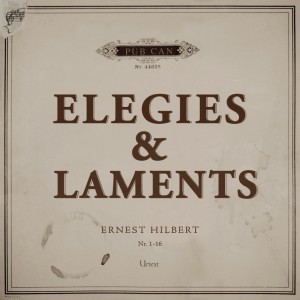 “WHAT WOULD IT SOUND LIKE IF A BOOK OF POETRY HAD ITS OWN MUSICAL SCORE, LIKE A FILM?”
“WHAT WOULD IT SOUND LIKE IF A BOOK OF POETRY HAD ITS OWN MUSICAL SCORE, LIKE A FILM?”
HILBERT, Ernest. Elegies & Laments. Philadelphia: Pub Can Records, 2013.Various analog and digital formats.
Order directly from the record label. Links to other methods of purchase appear below.
Elegies & Laments is the long-awaited spoken-word album featuring Ernest Hilbert reading selections from his book Sixty Sonnets, backed by the rock band Legendary Misbehavior as well as a string orchestra. The album is available for digital download at iTunes, Amazon, and all major platforms, streaming from Spotify and Pandora, compact disc, and in a highly recommended deluxe limited-edition series of 100 numbered copies on 12” 45rpm 180-gram white vinyl in black sleeve and gold-stamp-numbered pictorial jacket with download card and bonus full color audiophile booklet featuring the gear and techniques used in the studio, interviews with the musicians and songwriters, text of the poems, photographs from the studio, and the story of the album, signed by all members of the band. An additional 100 copies on 180-gram black vinyl will also be issued outside of the limitation in a plain sleeve with no limitation stated on insert. From the record label: “What would it sound like if a book of poetry had its own musical score, like a film, written specifically to match the poems line for line and word for word?
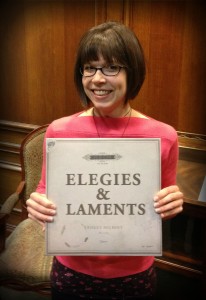
Jennifer Mercer, who designed the Elegies & Laments album (as well as all three of Ernest Hilbert’s books), poses with the finished product.
Following the release of his book Sixty Sonnets, poet Ernest Hilbert teamed up with veteran Philadelphia songwriter-musicians Marc Hildenberger and Dave Young to find out. After signing a contract with local label Pub Can Records, the three embarked on a spoken-word project called Elegies & Laments that would eventually grow to include a string orchestra (scored by young composer Christopher LaRosa), a battery of vintage instruments and electronics, mad-scientist rewirings, experimental technologies, session musicians, guest readers, and, perhaps inevitably, a harp. The grape and grain-fueled late night sessions at Widget Studios, on the city’s outskirts, yielded a soundtrack of surprising variety and depth, mingling past and present, making use of indie rock, jazz, heavy metal, classical, and R&B styles. The result is an entirely new kind of spoken word album. Feel the legendary misbehavior, the satires and observations, the failed escapes, the famous elegies and laments of Hilbert’s Sixty Sonnets in a way you have never heard poetry before. Elegies & Laments is essential for anyone interested in the ways poetry and music come together to create a new art form, for aficionados of experimental music to lovers of spoken word.” Synchronized Chaos declares it “an ingenious journey through sense and sound. A wonderful release.” PopMatters calls it “an album that defies genre . . . both in-your-face and ethereal . . . an imaginative hybrid that anyone who appreciates poetry and/or music should put their ears to.” Literary Magnet hails it as “Amazing and innovative . . . The music is variegated and fascinating, by turns vicious and lovely . . . [it does] what art should do: change things. Elegies and Laments will change you, too.” The album is available for digital download from Apple iTunes, Emusic, Amazon MP3, Last.fm, Spotify, Rdio, Muve Music, Shazam, GreatIndieMusic, MySpace Music, Simfy, CD Universe, Google Music Store, Slacker.fm, Rhapsody, MediaNet, Tradebit, 24-7, Bloom.fm, and Xbox Music.
* * *
“HILBERT IS DRAWN TO SCENES OF CARNAGE, WHERE THE TRUE FACE OF HUMANITY SEEMS TO REVEAL ITSELF”: FIRST, LIMITED EDITION OF AIM YOUR ARROWS AT THE SUN
HILBERT, Ernest. Aim Your Arrows at the Sun. New York: LATR Editions, 2009. Tall octavo, letterpress paper wrappers. $12.
First edition of Hilbert’s first chapbook of poetry, limited to 250 copies, hand-sewn covers designed and printed by Woodside Press, with a foreword by critic Adam Kirsch.
“To be haunted, for an American poet today, is a rare and enviable condition. Not by personal demons—everyone has those, and when poets write about them they are really haunting themselves. To be genuinely haunted, as Ernest Hilbert is in these outward- and backward-looking poems, one must be conscious of the past, and of the chastening contrast between the past and the present; in other words, one must have a sense of history. And history is the ‘bruising storm’ that ‘matures’ on the horizon of Hilbert’s poems, as he writes in ‘Selv’oscura,’ while the poet remains ‘swaddled’ in the untrustworthy comfort of the present. When Hilbert is visited by the past, in these poems at least, it is by grand and violent phantoms: ‘I read on about the lives and deaths of kings,’ he writes in a Lowellian phrase in ‘April Arsenal.’ Like Robert Lowell, Hilbert is drawn to scenes of carnage, where the true face of humanity seems to reveal itself. A destroyed tank in the Sinai Desert has weathered into landscape, its ‘long-ago blow and loss’ like an archeological reminder of the ways human beings, in the Middle East especially, keep returning to ancient patterns of violence: ‘proof that armies advanced this far / Before in the baffling waste,’ as Hilbert puts it in ‘On Passing the Remains of a T-62 in the Sinai.’ The most savage poems in Aim Your Arrows at the Sun use the past’s grandeur to reproach the pettiness of our world. In the Juvenalian ‘Bread and Circuses,’ Hilbert sees our TV shows and fast food as the equivalent of the largesse with which Rome’s rulers stupefied her people. After such humiliating contrasts, Hilbert and the reader can only take comfort in the truth stated in ‘Dining with Representatives of the Vatican Museum’—that it is art, including the art of poetry, that survives the past and incarnates it. Poems like the ones in Aim Your Arrows at the Sun are the ‘small remains of each man and each age’ that remind us of what is past and passing, and that will represent us in times to come” (Adam Kirsch). Adam Kirsch is the author of The Wounded Surgeon: Confession and Transformation in Six American Poets, The Modern Element: Essays on Contemporary Poetry, Why Trilling Matters, Rocket and Lightship: Essays on Literature and Ideas, The Global Novel: Writing the World in the 21st Century, The People and The Books: 18 Classics of Jewish Literature, and a biography of Benjamin Disraeli. He is on the seminar faculty of Columbia University’s Center for American Studies and is editor of the Weekend Section for The Wall Street Journal. The first issue contains “Kirsh” instead of “Kirsch” in the foreword attribution. Only copies sold at the launch reading at Melville House in Brooklyn, NY are known to be first issue. The remainder of the first issue was destroyed by the publisher, which reissued 215 corrected copies to fulfill the book’s stated limitation. The title of the collection derives from lines in the song “Take it as it Comes” by The Doors: “Time to walk / Time to run / Time to aim your arrows / At the sun.” Hand-sewn in letterpress stiff paper wraps. The first title from LATR editions. “On Passing the Remains of a T-62 in the Sinai,” “Two Portraits,” “At the 100th Anniversary of the Antiquarian Booksellers Association at the Royal Geographical Society,” “Bread and Circuses,” “Haunts,” Dining with Representatives of the Vatican Museum,” “Surrender of Breda,” and “Disasters of War” appeared again in Hilbert 2019 collection Last One Out.
Currently unobtainable. It is possible that this title may re-emerge in both of its distinct issues on the rare book market in years to come.
* * *
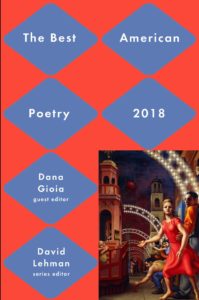 “A ‘BEST’ ANTHOLOGY THAT REALLY LIVES UP TO ITS TITLE”: BEST AMERICAN POETRY 2018
“A ‘BEST’ ANTHOLOGY THAT REALLY LIVES UP TO ITS TITLE”: BEST AMERICAN POETRY 2018
(ERNEST HILBERT) GIOIA, Dana, David Lehman, eds. Best American Poetry 2018. New York: Scribner , 2018. Octavo, issued simultaneously in color paper wrappers and hardcover with illustrated dust wrapper. $18.99 / $35. ISBN-10: 1501127802
The thirtieth edition of the important Best American Poetry series contains Ernest Hilbert’s poem “Mars Ultor,” which first appeared in the journal Academic Questions and was later included in the protest publication Donald Trump: A Magazine of Poetry.
Purchase directly from Amazon, Barnes & Noble, and Books a Million.
“Celebrating thirty years, the 2018 edition of the Best American Poetry—‘a “best” anthology that really lives up to its title” (Chicago Tribune). This anthology “collects the most significant poems of the year, chosen by Poet Laureate of California Dana Gioia” (Publisher’s Announcement). “Gioia’s instincts and insights unerringly hit the mark, and this new entry in The Best American Poetry series provides a richly rewarding compendium of styles and possibilities. In deftly channeling Auden’s ‘The Fall of Rome,’ Ernest Hilbert’s ‘Mars Ultor’ (another of my favorites in the book) observes, ‘Brutes push their way to power, / But the muddiest barbarian / Also wants the throne an hour.’ So, too, do poets, and the seventy-five assembled here have earned their hour of pageantry in this most distinguished setting” (Presence). “The Best American Poetry series has become one of the mainstays of the poetry publication world . . . [capturing] the zeitgeist of the current attitudes in American poetry” (Academy of American Poets). “The poems, ordered alphabetically by author, have a wonderful cohesion and flow, as if each contributes to a larger narrative about life today.” (The Washington Post). “The guest editor for 2018, Dana Gioia, has an unconventional poetic background. Gioia has published five volumes of poetry, served as the Chairman of the National Endowment for the Arts, and currently sits as the Poet Laureate of California, but he is also a graduate of Stanford Business School and was once a Vice President at General Foods. He has studied opera and is a published librettist, in addition to his prolific work in critical essay writing and editing literary anthologies. Having lived several lives, Gioia brings an insightful, varied, eclectic eye to this year’s Best American Poetry. With his classic essay ‘Can Poetry Matter?,’ originally run in The Atlantic in 1991, Gioia considered whether there is a place for poetry to be a part of modern American mainstream culture. Decades later, the debate continues, but Best American Poetry 2018 stands as evidence that poetry is very much present, relevant, and finding new readers” (Publisher’s Announcement). The anthology contains poems by seventy-five poets, including, besides Hilbert, Christian Wiman, Julia Alvarez, Aimee Nezhukumatathil, Paisley Rekdal, Elise Paschen, Tony Hogland, Frank Bidart, A.R. Ammons, David Barber, Stephen Kampa, Michael Robbins, Mary Jo Salter, Kay Ryan, Mary Ruefle, Natasha Trethewey, Terrance Hays, Marie Howe, Ilya Kaminsky, Sharon Olds, Joy Harjo, and others.
* * *
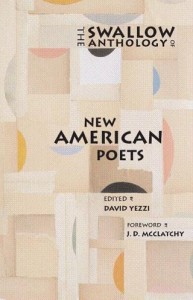 “THIS IS WHAT GOOD POEMS DO”: THE SWALLOW ANTHOLOGY OF NEW AMERICAN POETS
“THIS IS WHAT GOOD POEMS DO”: THE SWALLOW ANTHOLOGY OF NEW AMERICAN POETS
(ERNEST HILBERT) YEZZI, David, ed. Swallow Anthology of New American Poets. Ohio: Swallow Press, University of Ohio Press, 2009. Octavo, issued simultaneously in color paper wrappers and hardcover with dust wrapper. $13.75 / $49.95. ISBN-10: 0804011214
Purchase directly from Amazon or BN.com.
This landmark anthology contains nine sonnets by Ernest Hilbert, drawn from both his debut collection Sixty Sonnets and the forthcoming All of You on the Good Earth. “The Swallow Anthology of New American Poets gathers the work of thirty–five of the most compelling and talented new poets writing today. Groundbreaking anthologies of this kind come along once in a generation and, in time, define that generation. The Swallow Anthology identifies a group of poets who have recently begun to make an important mark on contemporary poetry, and their accomplishment and influence will only grow with time. The poets of The Swallow Anthology do not constitute a school or movement; rather they are a group of unique artists working at the top of their craft.” As editor David Yezzi writes in his introduction, “Here is a group of poets who have, perhaps for the first time since the modernist revolution, returned to a happy détente between warring camps. This is a new kind of poet, who, dissatisfied with the climate of extremes, has found a balance between innovation and received form, the terror beneath the classical and the order underpinning the romantic. This new unified sensibility is no watered–down admixture, no easy compromise, but, rather, the vital spirit behind the most accomplished poetry being written by America’s new poets.” J.D. McClatchy writes in his foreword, “If I were to generalize about the poets in this remarkable anthology, I would want to say something about the tone of this book. There is noticeably a common voice or approach. This is not a collection of vatic lyrics or dissociated rambles. The poems are often set at a middle distance, in a voice aware that it is speaking, pondering, puzzling, but alert as well to impulses that are unspoken or shocking. These are poets who have read, and expect their reader also to have read.” “Obviously, greatness is something conferred posthumously and by posterity, but the poets here exhibit the right aspirations and reflect how American poetry is constantly evolving in craft, range, and versatility” (PN Review). “These poets at their best evoke the freshness one hopes for but rarely finds in contemporary poetry” (The Baltimore Sun). The anthology is currently in its second printing, having sold through its first eight months after publication.
* * *
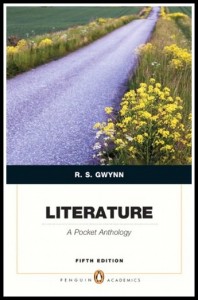 “ERNEST HILBERT . . . BRINGS POETRY INTO THE 21ST CENTURY”: PENGUIN’S LITERATURE: A POCKET ANTHOLOGY
“ERNEST HILBERT . . . BRINGS POETRY INTO THE 21ST CENTURY”: PENGUIN’S LITERATURE: A POCKET ANTHOLOGY
(ERNEST HILBERT) GWYNN, R.S. Literature: A Pocket Anthology (Penguin Academics Series), 5th edition, New York: Prentice Hall/Penguin, 2011 and 6th edition, 2015. Stout octavo, trade paperback. $50.00. ISBN: 0205032192
Purchase from Amazon, Barnes and Noble, and Alibris.
Ernest Hilbert’s poem “Domestic Situation” appears in this best-selling Penguin anthology. “A refreshing alternative to voluminous literature anthologies, this compact, inexpensive, and diverse collection of fiction, poetry, and drama provides a concise yet complete introduction to the study of literature. Short story authors new to this collection include award winners Tobias Wolff, Helen Simpson, and Susan Perabo, as well as the Pulitzer-prize winning Indian-American, Jhumpa Lahiri. The poetry collection brings new selections from classic and contemporary authors, including John Keats, e.e. cummings, Langston Hughes, Elizabeth Bishop, and Richard Wilbur, as well as fresh models from poets new to this edition including Amy Gerstler, Rebecca Foust, Craig Arnold, Ernest Hilbert, and Erica Dawson, whose work brings poetry into the 21st century. The drama section includes Yasmina Reza’s Tony-winning comedy The God of Carnage, produced on Broadway with a cast including James Gandolfini and Jeff Daniels, and reflecting the robust strength of today’s Broadway and of contemporary comedy, as well as Shakespeare’s Twelfth Night, which brings a classic comedy to this collection for the first time.”
* * *
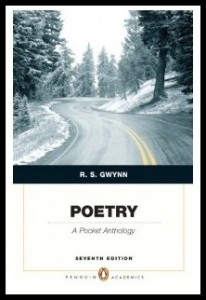 “INSPIRATION FOR ASPIRING YOUNG POETS”: PENGUIN’S POETRY: A POCKET ANTHOLOGY
“INSPIRATION FOR ASPIRING YOUNG POETS”: PENGUIN’S POETRY: A POCKET ANTHOLOGY
(ERNEST HILBERT) GWYNN, R.S., ed. Poetry: A Pocket Anthology (Penguin Academics Series), 7th Edition. New York: Prentice Hall / Penguin, 2011. Stout octavo, trade paperback. $40.00. ISBN-10: 0205101984
Purchase from Amazon, Barnes and Noble, and Alibris.
A new edition of the classic Penguin anthology of “250 poems provides a concise yet comprehensive introduction to the study of poetry. Authors new to this collection, including Amy Gerstler (named by the Los Angeles Times as ‘one of the best poets in the nation’), and award winners Rebecca Foust and Craig Arnold, provide ample evidence that poetry continues to flourish in today’s world. Young writers Ernest Hilbert and Erica Dawson bring poetry into the 21st century and provide inspiration for aspiring young poets.” “The ideal alternative to longer anthologies, this brief, affordable collection of more than 250 poems covers the full scope of the poetic tradition. Chronologically organized, this anthology includes master poets from Spenser, Sidney, and Shakespeare to contemporary artists of the 21st century, reflecting the work of the genre’s most distinguished writers as well as a wide array of diverse voices.
* * *
“AN HONEST VOLUME FOR DISHONEST TIMES”: MICAH MATTIX ON ERNEST HILBERT’S CALIGULAN
(ERNEST HILBERT) MATTIX, MICAH. The Soul Is a Stranger in This World: Essays on Poets and Poetry. Eugene, OR: Cascade Books, 2020. Octavo, hardcover in dust jacket, trade paperback, and digital. ISBN-10: 1532660162
Micah Mattix’s wide-ranging collection of essays includes analysis of poets from T. S. Eliot and E. E. Cummings to Allen Ginsberg and Basil Bunting to Reginald Shephard and Ernest Hilbert, alongside considerations of Flarf poetry, free verse, and surrealism. Chapter 31, “Ernest Hilbert’s Street Music,” is devoted to Hilbert’s book 2015 prize-winning collection, Caligulan. It originally appeared in the newspaper The Washington Free Beacon. “The Soul Is a Stranger in This World is a timely examination of some of the best modern and contemporary poets and a trenchant defense of poetry as a narrative, musical, and theological art. While it is common today to view the poet as a revolutionary, who breaks old forms in the name of aesthetic and political freedom, this volume begins with the classical view of the poet ‘as a man speaking to men,’ as Wordsworth put it. Poetry may challenge and shock, but it also consoles, probing the contours of the human soul in a broken world. Collected from essays and reviews first published in The Wall Street Journal, The New Criterion, Books and Culture, First Things, and other outlets, the volume traces these concerns in the work of modern masters such as Rilke and Eliot, avant-garde exemplars like Andre du Bouchet and Basil Bunting, and contemporary writers such as Dana Gioia and Franz Wright” (Publisher’s Announcement). Mattix writes: “Most Americans don’t like to talk about death, but Ernest Hilbert doesn’t mind. Death and decay is what he sees in Caligulan—his third volume of poems after Sixty Sonnets (2009) and All of You on the Good Earth (2013)—and he has little interest in spinning ‘Fictions fielding hopes of glory / Where none should be fulfilled.’ This is a question of temperament, as the title suggests, and reality. However we might feel, it’s relatively clear that the ‘seams’ of order, as Hilbert puts it in one poem, have been ‘unsewn.’” Mattix goes on to conclude that “as anti-pastoral as Hilbert can be, he shares Robert Frost’s commitment to describing impressions as precisely as possible” and declaring Caligulan a “volume is full of skillful surprises and insight, as well as occasional moments of humor” and “an honest volume for dishonest times.”
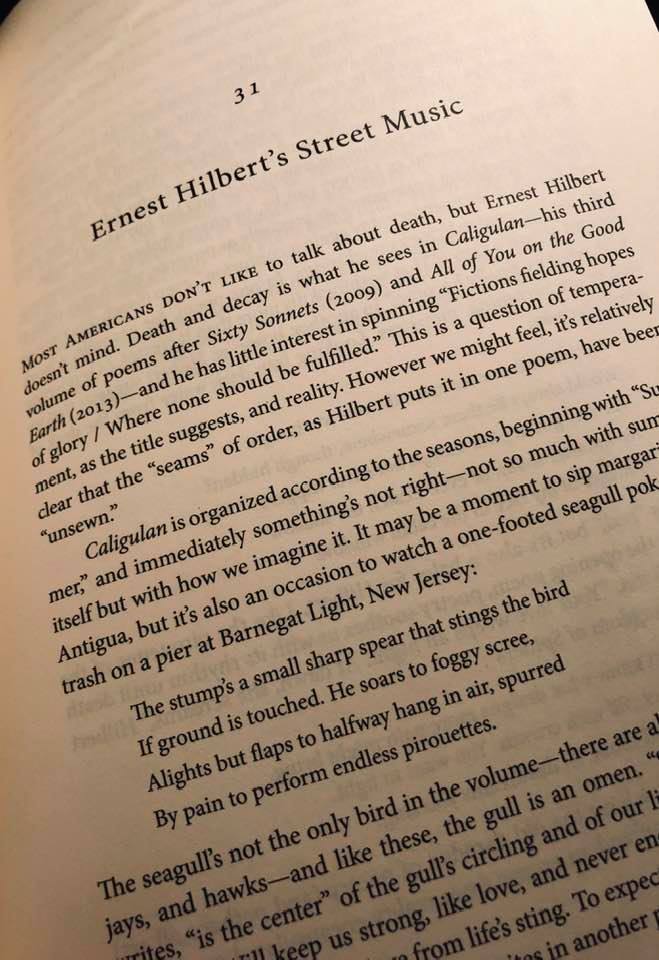
Ernest Hilbert’s Last One Out is full of a tender masculinity, fatherhood, unfathering.
– Poetry Foundation, Reading List, 2020
* * *
“MADDENINGLY COMPLICATED RULES”: ERNEST HILBERT’S “HEL[L]ICAL DOUBLE SESTINA: [METAL NUMBER ONE]” IN THE INCREDIBLE SESTINA ANTHOLOGY
HILBERT, Ernest (Daniel Nester, editor). The Incredible Sestina Anthology. Austin, TX: Write Bloody Publishing, 2013. Octavo, paper wrappers. $25. ISBN-10: 1938912365.
Purchase at Amazon, Barnes & Noble, Powell’s, Tower Books, Alibris, and Book Depository.
“More than 800 years after its invention in medieval France, the sestina survives and thrives in English. A fixed 39-line poetic form with of six stanzas of six lines each, followed by a three- line stanza known as an envoi, tornada, or tercet, the sestina is the one form of poetry that poets from all camps agree can exist in a free verse world. Formalists and avant-gardists both love sestinas for their ornate, maddeningly complicated rules of word repetition. For The Incredible Sestinas Anthology, editor Daniel Nester has gathered more than 100 writers—from John Ashbery to David Lehman to Ernest Hilbert and Patricia Smith—to show the sestina in its many incarnations: prose and comic sestinas, collaborative and double sestinas, from masters of the form to brilliant one-off attempts, all to show its evolution and the possibilities of this dynamic form.” “By collecting an exemplary, representative, and diverse array of sestinas, The Incredible Sestina Anthology does just what an anthology should: it creates both an accurate snapshot of the form throughout the twentieth and twenty-first centuries and a sense of the form’s future: the dream of a common poetry” (American Book Review). The anthology includes examples of the form from Sherman Alexie, John Ashbery, W.H. Auden, Elizabeth Bishop, Stephen Burt, Marilyn Hacker, Donald Hall, Anthony Hecht, Donald Justice, Weldon Kees, James Merrill, Paul Muldoon, Ezra Pound, Mark Strand, Louis Zukofsky, and Ernest Hilbert. This comprehensive collection of classic and new sestinas includes Ernest Hilbert’s infamous “Hel[l]ical Double Sestina: [Metal Number One],” which first appeared in a different form on McSweeney’s Internet Tendencies. The volume also includes a short interview with Hilbert about the poem in which he remarks that “the language in the poem is purposefully loud, like a heavy metal song, clanging consonants, big vowels, thrown at a very high pitch, a kind of romantic agony, which would seem out of place in most sophisticated or ‘art’ writing. This mimetic approach permitted me to really dive into the subject matter as if into a mosh pit. I cast it as an ode, addressing ‘Heavy Metal’ as if it were a monstrous ancient god and I a lone chronicler alongside the phantom brotherhood of metal-heads, acknowledging the strange communal experience that the music delivers, the grim ‘us’ and ‘we’ of the hordes.”
* * *
“CAN SO MUCH PURE FORCE EVER KNOW REVERSE?”: ERNEST HILBERT’S POEM “DREDGE” IN TWO WEEKS
(ERNEST HILBERT) BOWEN, Ash, Johnathon Williams, Eds. Two Weeks: A Digital Anthology of Contemporary Poetry. NP: Linebreak, 2011. Ebook. $2.99. ASIN: B004MYGCFM
Buy for the Kindle at Amazon.
Ernest Hilbert’s poem “Dredge” appears in this groundbreaking anthology from the editors of Linebreak magazine. The volume also includes poems by Randall Mann, Jennifer Jean, Sandy Longhorn, Oliver de la Paz, Dorianne Laux, and Matthew Zapruder. “The first of its kind, Two Weeks is collection of 58 all-new poems by established and emerging voices in contemporary poetry. Released exclusively in ebook format, the anthology was completed in only 14 days—from the online call for submissions to the design and production of the book itself. The editors and designers took special care to ensure that line breaks and other critical formatting survived the transition to digital form.”
* * *
“THE VOICES IN THIS VOLUME ARE BY TURNS PROVACATIVE, DEADPAN, HUMOROUS, AND INSPIRATIONAL”: QUOTE POET UNQUOTE
(ERNEST HILBERT) O’DRISCOLL, Dennis, ed. Quote Poet Unquote: Contemporary Quotations on Poets and Poetry. Port Townsend, Washington: Copper Canyon, 2008. Stout octavo, trade paperback. $18. ISBN-10: 1556592701.
Purchase from Amazon.
This lively collection of meditations on contemporary poetry, by such contributors as Seamus Heaney, Helen Vendler, and Michael Donaghy, was assembled by Irish critic and poet Dennis O’Driscoll from his column “Pickings and Choosings” for Poetry Ireland Review. Ernest Hilbert is represented on several controversial topics in the form of long quotations drawn from his editorials and reviews at Contemporary Poetry Review. “’One of the best-read men in the Western world’ is how Poetry Review describes Irish poet-critic Dennis O’Driscoll. Quote Poet Unquote, his compilation of contemporary quotations on all things poetry-related, proves that judgment spot on. The book grew out of O’Driscoll’s column ‘Pickings and Choosings’ for Poetry Ireland Review, and contains nearly two thousand smart sayings obsessively gleaned from six hundred sources—including powerhouse critics, prize-winning poets, world leaders, and newspaper headlines. The voices in this volume are by turns provocative, deadpan, humorous, and inspirational.”
* * *
“IT IS DIFFICULT TO EXAGGERATE THE EXULTATION, THE SHEER BLOODY RUSH”
(ERNEST HILBERT) COMPTON, Shanna, ed. Gamers: Writers, Artists, and Programmers on the Pleasures of Pixels. New York: Soft Skull Press, 2004. Stout octavo, stiff pictorial wrappers. $14.95. ISBN-10: 1932360573
Purchase directly from Amazon or BN.com.
Ernest Hilbert’s long essay “Flying Off the Screen: Observations from the Golden Age of the American Video Game Arcade” appears alongside others by “programmers, visual artists, cartoonists, game testers, and championship gamers” in this now-classic anthology of video game commentary. The publisher explains that “from the creation of ‘Spacewar!’ in 1962, through the golden age of the video game arcade in America, to the console-in-every household proliferation today, games have provided us with something books, music, the plastic arts, and even film have not. . . . In Gamers, editor Shanna Compton and twenty-three contributors . . . offer not only witty, widescreen views of how video games have become part of the cultural landscape, but also insight into where they may be headed next.” The Detroit Metro Times noted that “poet Ernest Hilbert offers the following existential observation: ‘It is difficult to exaggerate the exultation, the sheer bloody rush a 12 year-old boy can achieve by blasting Ozzy Osbourne’s “Flying High Again” through foam orange headphones while committing mass murder.’” Other contributors include Colson Whitehead, Richard Powers, Shelley Jackson, Aaron McCollough, and Daniel Nester. This edition has gone into several printings. The online reprint of Hilbert’s essay continues enjoy thousands of readers.
* * *
“THERE IS NO GREATNESS WHERE SIMPLICITY, GOODNESS, AND TRUTH ARE ABSENT”
(ERNEST HILBERT) TOLSTOY, Leo. War and Peace, translated by Aylmer and Louise Maude. San Diego: Baker and Taylor/Canterbury Classics, 2011. Stout octavo, hardcover. $24.95. ISBN-10: 1607103109
Purchase from Amazon and Barnes and Noble.
Ernest Hilbert provides a comprehensive introduction to this new popular edition of the classic Maude translation of Leo Tolstoy’s famous novel. (Click here to read his introduction.) From the publisher: “It was acclaimed author Leo Tolstoy’s finest literary achievement. War and Peace, the story of five wealthy families of the Russian aristocracy during and after Napoleon’s invasion of Russia, is also considered to be one of the finest novels of all time—a book no home library should be without.” From Hilbert’s introduction: “War and Peace is one of the most famous novels of all time, and justly so. It is certainly one of the longest. Its title, emblematic of the grand sweep of the lives chronicled within, is recognizable even to those who will never read it. It is celebrated for its dizzying cast of characters, its shrewd examinations of the demands history places on individual human lives, and, of course, its exhilarating story lines. It features nearly 600 characters, some of them authentic historical figures, others invented by their author. It is known for its narrative sweep as well its length, more than 1,000 pages in most editions. It is unlikely that Tolstoy could have successfully forged his masterpiece in a less capacious form. It is not, however, a complex novel. In fact, its straightforward nature is part of its greatness. As the narrator of the book assures us, ‘There is no greatness where simplicity, goodness, and truth are absent.’” Hilbert also supplied the introduction to the Canterbury Classics edition of four Charles Dickens novels, A Tale of Two Cities, Great Expectations, Oliver Twist, and A Christmas Carol.
* * *
“HIS CREATIVE POWERS WERE MATCHED ONLY BY HIS AMBITION”
(ERNEST HILBERT) DICKENS, Charles. Four Novels: Tale of Two Cities, Oliver Twist, Great Expectations, and A Christmas Carol. San Diego: Baker and Taylor/Canterbury Classics, 2011. Stout octavo, hardcover. $24.95. ISBN-10: 1607103125
Purchase from Amazon and Barnes and Noble.
Ernest Hilbert provides a comprehensive introduction to this new popular edition of four classic Charles Dickens novels. (Click here to read his introduction.) From the publisher: “Oliver Twist. Pip. The ghosts of Christmas past, present, and future. . . . . This Canterbury Classics edition of Charles Dickens collects some of his most famous and beloved works—The Adventures of Oliver Twist, A Christmas Carol, A Tale of Two Cities, and Great Expectations . . . . For those who’ve never read Dickens, it’s the perfect opportunity to experience his unique and compelling writing. And for those who are already Dickens devotees, an introduction by a renowned scholar will provide additional context and food for thought.” From Hilbert’s introduction: “Charles Dickens was the greatest novelist of the Victorian era, and perhaps the most famous English novelist of all time. He once went so far as to describe himself as ‘an amazing man,’ and it is true that he was exceedingly gifted. In fact, his creative powers were matched only by his ambition. He is undoubtedly the most ‘English’ of authors after William Shakespeare, meticulously capturing the lives, locales, and affairs of his native land at a time of remarkable societal change. He invented characters that seem to leap off the page. They live on in our imaginations long after the last leaf is turned. His popularity and influence were not only unmatched in his day but absolutely groundbreaking, altering the very essence of the novel. Aside from amusing his readers—something he never failed to do—Dickens had a real impact on the world around him.” Hilbert also supplied the introduction to the Canterbury Classics edition of the Maude translation of Leo Tolstoy’s War & Peace.
* * *
“OUR FEAR OF THE UNKNOWN—OF THOSE THINGS THAT GO BUMP IN THE NIGHT—IS AS OLD AS TIME ITSELF”
(ERNEST HILBERT) LOVECRAFT, H.P., Franz Kafka, Edith Wharton, et al. Classic Tales of Horror. San Diego: Baker and Taylor/Canterbury Classics, 2015. Stout octavo, hardcover, pictorial boards. $24.95. ISBN-10: 1626864659
Purchase online from Amazon , Amazon Canada, Amazon Spain, Amazon UK, Advanced Book Exchange, Walmart, Valore Books, Overstock, Kinokuniya Books (China), Book Depository, Alibris, and Barnes & Noble.
Ernest Hilbert provides a comprehensive introduction to this new popular edition of the classic horror stories, spanning the century between Polydori’s groundbreaking 1819 short novel Vampyre and early twentieth-century classics by H.P. Lovecraft and Franz Kafka. “We’ve all felt the rush of fear in the dead of night when we wake with a fright, chilled to the bone, feeling we are not alone. Our fear of the unknown—of those things that go bump in the night—is as old as time itself. Such primordial terrors take hold in the small hours, when the world sleeps, but they are captured, like génies in bottles, by the authors you will encounter in Classic Tales of Horror, authors who, above all, hope to remind us that all is not always well, that we are not always safe, nor do we fully understand the universe as much as we believe we do. In his pivotal essay ‘Supernatural Horror in Literature,’ H.P. Lovecraft, himself one of the undisputed masters of the field, began by affirming quite simply that ‘the oldest and strongest emotion of mankind is fear, and the oldest and strongest kind of fear is fear of the unknown.’ It is hard to improve upon this. A menace known, seen, and understood can never be as frightening as one that remains hidden, lurking in the shadows. This is the timeless element of these stories, and it contributes to their enduring appeal. They are as engaging today as they were when they first appeared. Stephen King, one of the most successful horror writers of all time, knows this and suggests that in horror fiction ‘we often experience that low sense of anxiety which we call “the creeps.”‘ He touches on an important point, which is that the fear of the unknown comes not only from outside phenomena but also, much more unsettlingly, sometimes from within. A recurring theme in these stories is the skeptic’s struggle to retain his faith in reason—to reassure himself that he is sane and that weird phenomena can be explained away—in the face of mounting evidence to the contrary. Even if he comes to accept the evidence as real, he may find himself unwilling or unable to talk about it with others. As Charles Dickens puts it, in ‘Trial for Murder,’ ‘I have always noticed a prevalent want of courage, even among persons of superior intelligence and culture, as to imparting their own psychological experiences when those have been of a strange sort.’ The terror arises, in part, from a character’s inability to be certain that what he experiences with his five senses is, in fact, real, that some presentiment or ‘feeling’ is actually attached to a supernatural event. The horror story, from its genesis, has always relied on a strong psychological element: Ancient, primitive forces somehow persist into the present day; subterranean energies force their way to the surface; tragedies unfolded long ago are reenacted. Characters wrestle with their own psyches in a vain effort to cling to remnants of sanity” (Hilbert’s introduction). “This chilling collection of scary stories will keep you awake for hours! Psychological horrors, disturbing dramas, and gruesome ghosts compose this compendium of confessions made in the dead of night. From vampires and a monkey paw to an unstoppable heart and haunting apparitions, anecdotes of supernatural terror will have you turning pages long past the witching hour. Allow famous authors such as Edgar Allan Poe, H. P. Lovecraft, Henry James, Washington Irving, and more to prey upon your emotions and peace of mind at slumber parties and camping trips, or anytime you want to end the night with a delightful fright!” (publisher’s announcement).
* * *
“VERNE FORESAW A WORLD OBSESSED WITH TECHNOLOGY, WHERE EVEN THOSE WHO CHOOSE TO AVOID IT CANNOT ESCAPE ITS INFLUENCE”
(ERNEST HILBERT) VERNE, Jules. Four Novels: Five Weeks in a Balloon, Journey to the Center of the Earth, Twenty Thousand Leagues Under the Sea, Around the World in Eighty Days. San Diego: Baker and Taylor/Canterbury Classics, 2012. Stout octavo, hardcover. $16.95. ISBN-10: 1607103176.
Purchase from Amazon and Barnes and Noble.
Ernest Hilbert provides a comprehensive introduction to this new popular edition of four classic Jules Verne novels in translations by William Lackland, Frederick Amadeus Malleson, and Lewis Mercier. (Click here to read his introduction.) From the publisher: “Legendary science fiction and adventure author Jules Verne is remembered for his fascinating stories of travel and excitement. With countless adaptations available, the titles of his works are familiar. But no joy can compare to reading the originals—and reading them in a deluxe classic edition is even better.” From Hilbert’s introduction: “Verne’s first novel imagined men floating almost helplessly across a largely unmapped Africa in search of the still-undiscovered sources of the Nile. By the time Around the World in Eighty Days was published, the planet had been crossed, demarcated, conquered, and exploited. The wonders Verne captured in Five Weeks in a Balloon were essentially gone by the end of his life. To this day, however, Verne challenges readers to explore new worlds while also mourning the passing of older, quieter ones, those immersed in mystery and ennobled by myth, which, like ours, are made up of stories. His novels may chart the disappearance of a world, but they also bring us the beginnings of a new one, the one we inherited from him.” Hilbert also supplied the introduction to the Canterbury Classics edition of the Maude translation of Leo Tolstoy’s War & Peace and Four Novels by Charles Dickens.
* * *
NEMEAN LION PRESS
Nemean Lion Press is Hilbert’s own small, private press. To date it has issued three books, designed and bound by Jennifer Mercer and Melissa Moffa, a novelty beer bottle, and a number of promotional posters, designed by Kara Mallon. Jennifer Mercer is a designer of considerable ingenuity and range. She designed all of the promotional products for E-Verse Radio, Hilbert’s blog, as well as its logo. Melissa Moffa is part of a movement toward hand-made books that currently flourishes in Philadelphia. She incorporates cut paper illustrations into her book design and experiments with a variety of unusual binding techniques.
The Nemean Lion was a powerful beast believed by the ancient Greeks to have fallen from the moon as the child of Zeus, king of the gods, and Selene, an archaic lunar deity born of the Titans Hyperion and Theia (though other myths suggest that the lion was the offspring of the Chimera, a creature made up of many, including a lioness, a snake, and a goat; hence our term “chimera,” something that is difficult to understand; its siblings were Cerberus and the Lernaean Hydra). The Nemean Lion is named for the city of Nemea, which it terrorized. Heracles slayed the lion as one of his twelve labors and wore the lion’s pelt, which rendered him invincible.
* * *
“EACH CLIMBER BRAND NEW IN HIS SKIN”: SIGNED LIMITED CONCERTINA EDITION OF THE THIRD COOPERATIVE FINE-ART BOOK BY DAVID YEZZI AND ERNEST HILBERT
YEZZI, David and HILBERT, Ernest [MOFFA, Melissa and MERCER, Jennifer]. Two Ranges [Vertical]. Philadelphia: Nemean Lion Press, 2013. Squat oblong quarto, cobalt blue cloth boards [two specially bound author copies in heavier, darker cloth], concertina paper column. 14pp. Measures 7 by 5 ½ inches on shelf, 36 inches fully extended.
Signed limited-edition chapbook featuring two alpine poems, one each by David Yezzi and Ernest Hilbert, on opposite facings of the vertically extendable concertina paper column, one of only sixteen total copies signed by both authors, only twelve for sale (two authors’ and two artists’ proofs, hors série).
Two Ranges [Vertical] is the third book from Nemean Lion to feature contrasting poems by David Yezzi and Ernest Hilbert. The first in the series, A Fletching of Hackles, showcased spirited dueling by way of light verse between the mutually aggrieved authors. Their second collaboration, 3 X 5, bound in dark blue snakeskin, addressed themes of freedom and obsession. Two Ranges [Vertical] displays David Yezzi’s sonnet sequence “Flatirons,” which debuted in the pages of Poetry magazine, and Ernest Hilbert’s four-decker “Glacier,” which first appeared in the Oxonian Review (Yezzi’s poem later appeared in his collection Birds of the Air in 2013, Hilbert’s in his collection Last One Out in 2019). Yezzi’s poem details the spiritual effects of a hair-raising free-climb on the infamous Flatiron rock formations near Boulder, Colorado (geomorphologically speaking, a flatiron is a precipitously sloping wedge-shaped surface formed by differential erosion of a rock layer that inclines in the same direction as but at a steeper angle than an exposed slope). Hilbert’s poem describes a brutal though considerably more gradual ascent through a summer storm to the lip of the Arapaho Glacier at 12,000 feet, also in Colorado. The two other climbers alluded to in the poem are David Yezzi and Charles Doersch (who led both ascents). The book is designed in a delightful concertina, or accordion, style that extends vertically to a full 36-inch spread in the reader’s hands, thereby suggesting the dizzying heights of the summits described in the poems. The bookmaker wrapped the cloth-bound boards and glued the concertina columns entirely by hand. Books signed by both Yezzi and Hilbert are certain to become increasingly scarce. The book is currently unobtainable, having sold out in its first week of sale.
* * *
“HILBERT, ERNIE, / SHOULD GET AN ATTORNEY . . .”: SIGNED LIMITED EDITION OF THE FIRST TROUBLED COLLABORATION BETWEEN DAVID YEZZI AND ERNEST HILBERT
YEZZI, David and HILBERT, Ernest [MOFFA, Melissa and MERCER, Jennifer]. A Fletching of Hackles, Fresh Verse by Ernest Hilbert and David Yezzi. Philadelphia: Nemean Lion Press, 2009. Small folio, hand-sewn, paper title label, grey paper wrappers. 20pp. Measures 8 ½ by 5 ½ inches.
Signed limited edition of this delightful sequence of “dueling” clerihews and limericks, one of only 24 copies signed by designer, bookmaker, and both authors.
David Yezzi and Ernest Hilbert began trading insults as early as 2003, but it was only five years later that they began to hurl abuse at each other in poetic form (Sanders, 83). Employing comic verse forms of the clerihew and limerick, they fired broadsides at each other and were even known to time their violent verbal exchanges in the style of chess matches. Long known as ferocious enemies, each remained bent on burying the other with sheer odium, and they spent nearly a full month locked in a terrible and ceaseless mêlée that shocked and puzzled onlookers. In the summer of 2008, the two “poets” agreed to a brief and, as it turned out, fragile cease-fire, during which they compiled the inventions of their mutual loathing in what would later become A Fletching of Hackles, a collection inspired by Fescennine rituals, which contained a form of Latin occasional verse, “chiefly lascivious wedding songs, of great antiquity, which perhaps originated as ribald or abusive songs sung at harvest festivals” (Princeton Encyclopedia of Poetry and Poetics, Fourth Edition.
A clerihew is a fanciful four-line poem first used by Edmund Clerihew Bentley, rhyming AABB, in irregular meter, addressing a famous historical figure. The first rhyme is traditionally given to the subject’s name, as in Bentley’s classic “John Stuart Mill, / By a mighty effort of will, / Overcame his natural bonhomie / And wrote Principles of Political Economy.” Notable clerihews have also been penned by G.K. Chesterton, Alger Hiss, and W.H. Auden, whose book Academic Graffiti is entirely devoted to the form. The limerick, a well-known comic verse form, consists of five lines rhyming AABBA in strict form, first popularized in English by Edward Lear. Because it has a long tradition of obscene subject matter, it is ideally suited for the pair’s ongoing “war of words.” By amplifying raw verbal hostility and personal abusiveness to levels “not encountered before,” Yezzi and Hilbert are thought to have “expanded the possibilities of both forms” (Kennedy, An Introduction to Poetry, 532). William Logan referred to the resulting poetry as more “akin to untreated sewage” than “anything we would call civilized poetry or discourse” when reviewing it for the Washington Post Book World.
The book was computer typeset by figure skater Jennifer Mercer when she probably should have been working on something important and hand-sewn by Elven bookmaker Melissa Moffa when she would rather have been out having fun. The portraits of the authors Mercer created for the cover may actually be more physically attractive than the men themselves. The type is set in Bernhard Modern, a serif typeface produced by Lucian Bernhard for the American Type Founders in 1937 in return for a half bottle of whiskey. It is known for its wide serifs, elongated ascenders, and big bottoms (it is sometimes embarrassed by its short descenders). For those incapable of using a dictionary, a “fletching” is the arrangement of feathers on an arrow and “hackles” the long narrow feathers on the neck of a fowl that are “raised” when the bird is irritated or threatened. The two selected the title in part because Yezzi has reported that “Hilbert looks remarkably like a turkey vulture chewing a length of intestine” to which Hilbert replied “yeah, well, you look like a sick pigeon that stayed up all night drinking cheap vodka.” A Fletching of Hackles is twice cited in David Sanders’ Rare and Irrelevant (22a and 22aa) and also in the third and least-significant appendix to Adam Kirsch’s Why Did They Bother? Poetic Feuds, 1928-2009 (16d.II-iv). This series is preceded by four artists’ and authors’ proofs, not intended for distribution, which include hand-die-cut portraits on gray paper over maroon wrappers. The book is currently unobtainable, having sold out in its first week of sale.
* * *
“SUCH ROOT SATISFACTION . . .”
SIGNED LIMITED TÊTE-BÊCHE EDITION
OF THE SECOND BOOK BY DAVID YEZZI AND ERNEST HILBERT
YEZZI, David and HILBERT, Ernest [MOFFA, Melissa and MERCER, Jennifer]. 3 X 5 [Three by David Yezzi, Five by Ernest Hilbert]. Philadelphia: Nemean Lion Press, 2010. Small tête-bêche folio, hand-sewn, Prussian-blue, faux-snakeskin binding, cutaway title windows, stiff eggshell-blue wrappers. 16pp. Measures 8 ½ by 5 ½ inches.
Signed limited-edition chapbook featuring two sequences of poems, one each by David Yezzi and Ernest Hilbert, approaching from two directions as separate books, one of only 12 copies signed by designer, bookmaker, and both authors, only eight for sale (two authors’ and two artists’ proofs).
This sleek “snakeskin” tête-bêche (from the French “head-to-toe”) volume consists of two separate books, rotated 180° relative to each other, that may be read with equal satisfaction from either direction, as Yezzi’s “Three” or Hilbert’s “Five,” meeting at the book’s center, which features inverted mirror-facing limitation pages. Yezzi’s three contributions are the poems “Itchy,” “The Ballade of In-between,” and “Free Period.” Hilbert’s five are “Drift,” “Ashore,” “Panthera,” “4AM Cab Ride,” and “While You Were Out.” The poems originally appeared in Antioch Review, LineBreak, New Ohio Review, Parnassus, Poetry, Think Journal, Vocabula Review, and Yale Review. Both limitation pages are signed by bookmaker Melissa Moffa, designer Jennifer Mercer, and authors David Yezzi and Ernest Hilbert, accompanied by the press’s official blue Nemean Lion chop stamp; thus all books in the series are double-signed by all four creators. Books signed by both Yezzi and Hilbert are destined to become increasingly scarce. All copies were sold two weeks before publication.
* * *
“WE’LL HEAD OUT, YOU AND ME, HAVE A PINT, OR / MAYBE THREE, A COOL THIN ALE, LIKE SUNLIGHT”: SIX PACK POEMS BY ERNEST HILBERT
(HILBERT, Ernest) MERCER, Jennifer and MOFFA, Melissa. Six Pack Poems. Philadelphia: Nemean Lion Press, 2009. Six brown glass 12 oz. beer bottles, original paper labels, aluminum caps, poems on hand-made paper scrolled and tied with blue silk, in white cardboard carrying container. 50¢ deposit CT, DE, HI, CA, IA, ME, MA, MI, NY, OR, VT
Signed editions of Hilbert’s promotional “six pack poems,” six beer bottles with custom labels, “brewed by Ernest Hilbert,” “contents: one sonnet,” containing six poems about beer, each signed by Hilbert, designer Jennifer Mercer, and bottler Melissa Moffa.
Jennifer Mercer’s custom beer label for Hilbert’s promotional six packs is based on her own design for Sixty Sonnets as well as vintage beer labels such as Ortlieb’s, Pabst, and Genesee. Each bottle contains a poem from Sixty Sonnets that references beer: “Church Street,” “A Few Drinks and We’re All Poets,” “Cautionary Tale; or, What Comes Up Must Come Down,” “Up Late on a Work Night: A Lament,” “Improprieties,” A Sad Last Number for the Gentlemen at the Tavern.” The six packs are periodically available at Hilbert’s readings in bars such as KGB and Bowery Poetry Club in New York City. The first six pack was numbered, though bottles were distributed to different recipients. Later editions are not limited, and there is no intention of limiting the series in the future.
* * *
“SCARCEST OF ALL HILBERTIANA”
(RED HEN PRESS) HILBERT, Ernest. Sixty Sonnets Chocolate Bar. Los Angeles: Red Hen Press, 2009. Chocolate bar (sugar, chocolate, cocoa butter, cocoa processed with alkali, milk fat, lactose, soy lecithin, PGPR, vanilla, artificial flavor, milk) housed in beige pictorial paper wrapper over folded silver foil. Measures 7 by 2 1/2 inches, 1 inch thick.
One of an unknown quantity manufactured by Hilbert’s publisher Red Hen Press for promotional use at the launch and signing event for Hilbert’s first book Sixty Sonnets (Associated Writing Programs conference, Chicago, February 2009).
It is assumed most copies were consumed by book fair browsers over the three days of the conference. The only known remaining copy (pictured) resides in the personal collection of the author and is considered the scarcest of all Hilbertiana. A charming piece of publishing ephemera and a glimpse into the increasingly bizarre world of author promotion.
* * *
“KEEPING WITH THE TRADITION”
(RED HEN PRESS) HILBERT, Ernest. AoYotGE [All of You on the Good Earth] Beer Coaster. Los Angeles: Red Hen Press, 2013. Square Pulpboard Coaster, 3.375 inches square.
250 beer coasters manufactured as promotional giveaways with a design adapted by Jennifer Mercer from the cover of Ernest Hilbert’s second full-length commercial poetry collection, All of You on the Good Earth.
In keeping with the tradition of beer-related items (see Six Pack Sonnets) used to promote Ernest Hilbert’s books, the coasters were distributed by the publisher and at public readings given by the author, many of which occurred in drinking establishments, beginning with the publication party and record release [Elegies & Laments] upstairs at Fergie’s Pub in Philadelphia. One of the more unusual items of Hilbert ephemera. Increasingly scarce.
* * *
Publisher’s merchandise associated with Hilbert’s books and album includes (clockwise from top left) Sixty Sonnets refrigerator magnet, AOYOTGE post card, AOYOTGE vinyl sticker, AOYOTGE beer coaster, Elegies & Laments vinyl sticker, and Sixty Sonnets vinyl sticker. Collect all seven!
* * *
Caligulan Beer Koozies. All of You on the Good Earth boasted its own shot glass. Caligulan continues the tradition with a series of 30 black Caligulan beer koozies. Beyond the 30 black copies issued is one out-of-series red koozie from a test run. The koozies were produced by DevilFish Ink Graphic Design, housed in the Philadelphia Brewery Building in Philadelphia’s Kensington neighborhood. The series sold out, and the single red test pressing resides in the private collection of Stephen Lang, the Lyons Keeper of Collections for the Asian Section of the University of Pennsylvania Museum of Archaeology and Anthropology.
* * *
“OB / Original Barbarian.” T-shirt, black, four sizes with one toddler size, limited to 24 silk-screened and one out of series. Designed by Jennifer Mercer after Hilbert’s idea for aging metal heads assuming a variant on “OG’s” or Original Gangsters. Shirts were distributed to regular attendees of Hilbert’s semi-annual “Metal Nights.”
* * *
“CAL.” T-shirt, black, 100% cotton. This is a unique item, commissioned by Ernest Hilbert and designed by Jennifer Mercer. It depicts American poet Robert Lowell alongside his nickname “Cal,” which was given to him by classmates as a boy. His rough and imperious behavior earned him the epithet which refers either to Caliban, the wild man “not honour’d with a human shape” of William Shakespeare’s late play The Tempest, or the Julio-Claudian Roman emperor Caligula, infamous for his brutal and capricious reign (Gaius Julius Caesar Augustus Germanicus earned the nickname Caligula, which is the diminutive of caliga, or “small soldier’s boot,” while campaigning with his father in Germania). Diantha Parker recalls in an essay how her father remembered young Lowell as “someone other boys seemed instinctively to shun,” going on to add that her father believed that “there was a darkness wherever [Lowell] went.” There is only one shirt. No copies will be made.
* * *
“I’VE KNOWN BEAUTY ALMOST IMPOSSIBLE / TO BELIEVE”: LIMITED-EDITION SIGNED LETTERPRESS BROADSIDE OF ERNEST HILBERT’S POEM “LAST RITES” WITH ARTWORK BY HIS SON
HILBERT, Ernest (Ian Hilbert). “Last Rites.” Broadside signed. Essex County, MA: Tollund Press, 2021. Measures 12 by 18 inches. Letterpress printed in two colors on 12″ x 18″, 118-lb. 100%-cotton cover stock.
Limited edition letterpress broadside of Ernest Hilbert’s fatherhood poem “Last Rites,” including “Ian’s Arrow,” an artwork created by the poet’s son, Ian, 24 numbered and signed copies (four copies hors de commerce).
In 2020, Christian Schoenberg, the founder of Tollund Press, obtained a 5,950-pound Original Heidelberg Platen Press and refurbished it over the course of a year, having missing parts machined locally or sent from as far away as China. While visiting the press in Essex County, Massachusetts, the author’s son was asked by the publisher to “draw anything” that came to his mind. The resulting artwork, known as “Ian’s Arrow,” was first accomplished in pencil, then inked over with ballpoint pen and then further widened with marker by the young artist, who was 5 years old at the time. The image was then transferred to a photopolymer plate for printing.
The poem and artwork are printed on 12″ x 18″, 118-lb. 100%-cotton cover stock on an Original Heidelberg Platen Press manufactured in Germany by the fabled Heidelberger Druckmaschinen. The poem is set in Hoefler & Co’s Surveyor (designed by Tobias Frere-Jones in homage to the characteristic form of lettering on engraved maps) and Gotham (a sans-serif with geometric structure designed by Tobias Frere-Jones with Jesse Ragan and inspired by mid-twentieth-century architectural signs). The numbering in felt-tip pen was performed by Ann Drourr. The broadside features the official red-ink Nemean Lion chop stamp on the reverse, dated in Hilbert’s hand. The poem first appeared in The Hudson Review, Autumn 2019, Volume LXXII, No. 3.
It is the first broadside issued by the press.
* * *
“I FACE AN OCEAN, ITS LURID RUSH AND PULL”: LIMITED-EDITION SIGNED BROADSIDE FROM TOLLUND PRESS
HILBERT, Ernest. Franco Salas-Borquez. “Pelagic.” Broadside signed. Essex County, MA: Tollund Press, 2022. Letterpress printed in two colors on 17” x 7” 100% cotton text stock (bottles) or 100% cotton 1-ply (unbottled).
Limited-edition letterpress broadside of Ernest Hilbert’s swimming poem “Pelagic,” including artwork created by Chilean artist Franco Salas-Borquez, signed by the poet, sixty total copies, six on smaller paper bottled—three released into the Gulf Stream in the spring of 2022—fifty-four larger format unbottled, six copies hors de commerce. Three sealed “poems in a bottle” were stowed aboard The Charlotte, a J120, 40-foot sloop, and borne along the course of the 2022 June Newport-Bermuda Race, known as the “Thrash to the Onion Patch,” which takes places largely in the Gulf Stream, where the bottles were set loose from the vessel.
The cresting wave art was created by Franco Salas-Borquez, a Paris-based Chilean painter and sculptor born into a seafaring family on the island of Chiloé. Borquez’s dramatic large-scale seascapes capture primordial sense of elemental terror in the chaos of storms and fierce currents. The line-drawing was commissioned and created for this broadside. It was digitized and then transferred to a photopolymer plate for printing.
The six broadsides in bottles are printed on 100% cotton text stock (118 gsm, 8 pt) and the fifty-four unbottled broadsides on 100% cotton 1-ply cover stock (318 gsm, 20 pt). All sheets printed on a 5,950-pound Original Heidelberg GT. The poem and its title are set in Mathew Butterick’s font Equity, an elegant variation of Times, originally designed for clarity and legal use. The colophon is set in Orpheus, designed by Kevin King and Patrick Griffin after “late 1920s designs by Walter Tiemann, who had an impressive talent for combining classic Roman proportions and Art Deco sensibilities.”
The broadside features the official blue-ink Nemean Lion chop stamp on the reverse, dated in Hilbert’s hand. The numbering in felt-tip pen on the limitation was accomplished by Ann Drourr. The poem first appeared in The Hopkins Review, Volume 13, Number 2, Spring 2020 and again in the book Storm Swimmer, UNT Press, 2023. The broadside includes a description card printed on the Heidelberg. Grains of sand collected by the poet in the Florida Keys was added by the printer to the six bottles. Grains of Himalayan salt were also added in order to absorb humidity and moisture from the corks. The bottles were corked using a Grifo Italian Floor Corker. The bottles were sealed with navy blue sealing wax manufactured by Blended Waxes, Inc. Vice Commodore Richard L. West of the Stamford Yacht Club released the bottled poems into the gulf stream during the June 2022 Newport-Bermuda Yacht Race. Two earlier strikes of the broadside on different paper were destroyed as the inking was deemed insufficiently even.
It is the second broadside issued by the press.
* * *
“BEEHIVES AND BELLBOTTOMS ALWAYS STAY IN STYLE”: FINE LIMITED EDITION LETTERPRESS BROADSIDE
HILBERT, Ernest and ALGEO, Robert James. “All of You on the Good Earth.” Upper Montclair, NJ: Printed by Wolfe Editions for Temporary Culture, 2008. Oblong broadside. Measures 15 by 11 inches.
Signed limited edition broadside featuring the sonnet “All of You on the Good Earth” by Ernest Hilbert illustrated with a punch-card created by artist Robert James Algeo, and printed by David Wolfe at Wolfe Editions, Portland, Maine, in an edition of 50 numbered copies signed by the author with a smaller number additionally signed by the artist (2 copies, hors série, signed by publisher and author).
Science fiction publisher Temporary Culture commissioned poet Ernest Hilbert to compose a sonnet for its 2008/2009 New Year’s greeting. “All of You on the Good Earth” pays tribute to the heroic far-sightedness of the best science fiction writers, while also serving as a useful reminder of the short-sightedness that limits all human endeavor. Hilbert jokingly refers to “3-D videophones” operated with the now obsolete “rotary dial” once common to telephones in the last century. Bellbottoms and beehives, fads and fashions, are assumed to be permanent while science carries humanity forward. Clerks in the furthest reaches of the galaxy continue to file reports using now ancient typewriters. Milk is no longer delivered to our doorsteps, but a science fiction novelist might have once imagined clones on their appointed rounds. The poem is both homage and cautionary reminder, issued at a time of year when readers are urged to take stock of the past while cautiously planning for the future.
The title of the poem is drawn from the historic broadcast of the Apollo 8 space mission. At the end of the annus horribilis 1968, a year that saw many tragedies and civil unrest around the globe, Apollo 8 successfully circumnavigated earth’s moon, “the first human voyage to another world” according to the Boston Globe. On Christmas Eve, the crew observed the earth rising for the first time over the moon’s horizon. Commander Frank Borman later described the earth-rise as “the most beautiful, heart-catching sight of my life, one that sent a torrent of nostalgia, of sheer homesickness, surging through me.” He then signed off: “Good night, good luck, a Merry Christmas, and God bless all of you—all of you on the good Earth.”
The punch-card provided by Algeo was created with online software and delivered as a digital file to the printer, David Wolfe, who used it to create a photopolymer plate for the press. This ironic technological regression—from contemporary software to digital image of early computer punch-card to plate for inking—intrigued and delighted both printer and publisher. The card printed here is characteristic of those used with IBM card processing equipment from the 1930’s onward. If processed, this punch-card will reveal a line from the Bob Dylan song “Abandoned Love”: “Won’t you let me in your room one time ’fore I finally disappear?” The song was originally penned for the 1976 album Desire but was only released to the public in 1985 on the compilation album Biograph. The type is set in the rare font Jenson Eusebius, designed by Richard Beatty and Nicolas Jenson. A lovely example of the letterpress print-maker’s art, on fine paper, bottom edge untrimmed.
Copies are now in the collections of singer Patti Smith, David G. Hartwell (editor, New York Review of Science Fiction), Michael Swanwick, Don Webb, John Crowley, the Lilly Library, the science fiction collection of Texas A&M, The New Criterion, Parnassus, Jonathan Galassi, Poetry Society of America, The Academy of American Poets, Poets House New York, Joe Haldeman, Concord Poetry Center, and the libraries of several private collectors. The last copy on the market sold before the end of 2009, and the broadside is currently unobtainable.
* * *
“AS IF WE’RE BORN FOR WAR AND IT FOR US”: FINE PRESS LIMITED EDITION OF “AGAINST THE ART OF WAR”
HILBERT, Ernest, Henry Wessells (contributor), Judith Clute (artist). Against the Art of War. San Francisco, London, Upper Montclair: Temporary Culture, 2013. Tall octavo, hand-made paste-paper boards, 16pp.
Fine press limited edition of Ernest Hilbert’s poem “Against the Art of War” and Henry Wessell’s poem “Wars End,” with three tipped-in aquatint etchings created and printed by London-based Canadian artist Judith Clute, letterpress printed by David Wolfe of Portland, Maine, hand-bound in paste paper boards, in an edition of 26 lettered copies, signed by the authors and the artist, and five numbered copies reserved for artist, authors, and printer.
Purchase directly from the press.
In the summer of 2012, author and fine-press impresario Henry Wessells commissioned Ernest Hilbert to write an anti-war poem for a still-untitled fine-press art book to be issued as the second in a series by Temporary Culture, Wessell’s own press, which specializes in collectible science fiction and art books. The resulting poem, “Against the Art of War,” appeared first in this limited edition and was later included in Hilbert’s 2019 collection, Last One Out. The artwork for the edition was provided by Judith Clute, a Canadian artist resident in London. In 2008, Temporary Culture published Clute’s etchings along with the poem “Forever Peace. To Stop War” by Joe Haldeman, author of the science-fiction classic The Forever War (1974). Clute apprenticed to Francoise Andre and Charles Stegeman in the early 1960s, and her work has been shown internationally. David Wolfe has worked as a master letterpress printer since 1979 and renowned printmaker since 1998. He teaches at Harvard, Dartmouth, Wellesley, and elsewhere. Text and etchings are printed on 300 fsm Somerset, 100% cotton, pH neutral, mouldmade in England by St. Cuthberts Mill, internal and surface sized, 2 natural deckles. Somerset is known for its excellent quality for printmaking. The aquatint etchings are tipped to supports of Fabriano Ingres laid paper. Temporary Culture Press derives its name from a phrase that came to founder Henry Wessells in a dream while an undergraduate at Princeton. He has remarked that “upon examination, it contains a critique of the marble academy and any pretensions to cultural permanence.” Within a month of the book’s publication, all 26 lettered copies sold to private collectors as well as special collections libraries at Duke University, Yale University, the Lily Library, and Poets House in New York City. The series is sold out.
“THERE’S ONLY ONE OF ME / (IT’S NOT THE ONE YOU SEE)”
NFT OF ERNEST HILBERT’S POEM “RIDDLE ME”
HILBERT, Ernest. “Riddle Me.” New York: Opensea, 2021. Non-fungible token.
NFT edition of Ernest Hilbert’s NFT-themed poem “Riddle Me,” the first poem using rhyme and meter to be minted and sold in an encrypted digital form.
Ernest Hilbert’s poem “Riddle Me,” written specifically for use as NFT art (non-fungible token art, a form of financial security made up of digital data deposited in a blockchain, a distributed ledger), was made available for sale using the cryptocurrency Bitcoin through OpenSea, a peer-to-peer marketplace for rare digital items and crypto-collectibles housed at the Hunter College MFA program in New York City. It was posted for sale March 18, 2021 with the aid of Alexander Szymanik. Although “Riddle Me” cannot lay claim to being the first poem (or item described as a poem) issued on the crypto market as an NFT, it is the first to use meter, rhyme, and repetition, which are ancient techniques essential to many uses of the art form throughout history. While it may be charitably classed as a novelty or occasional poem, it signals the dawn of a new range of possibilities for poets and collectors of poetry first editions.
The New York Times explains that “An NFT is a piece of artwork stamped with a unique string of code and stored on a virtual ledger called a blockchain . . . when an artist uploads a piece of art and clicks a button to ‘mint’ it [it] starts a process known as mining, which involves complex puzzles, awesome computing power and a huge load of energy. That’s because Ethereum, the platform of choice for NFTs, uses a method called proof of work to create digital assets like nonfungible tokens. To successfully add an asset to the blockchain’s master ledger, miners must compete to solve a cryptographic puzzle, their computers rapidly generating numbers in a frenzied race of trial and error . . . The miner who arrives at the right answer first is the winner, and gets . . . his asset added to the blockchain.”
While crypto art may confuse some readers and pose aesthetic difficulties for others, possibly some older users, it is likely that younger ones will feel increasingly comfortable with the basic concept, as they tend to be with crypto currencies. When Walter Benjamin, in his important 1936 essay “The Work of Art in the Age of Mechanical Reproduction,” envisioned an original painting possessing an aura—”its unique existence at the place where it happens to be”—that cannot be communicated by copies, could he have imagined an NFT, and what would he have thought of it? Where would one locate the “aura” of a poem, in the handwritten manuscript, a recording of the poet reading it aloud, a first printed edition, a first appearance on social media? Can or should poetry be assigned monetary value? Do poets deserve to be paid for their poems? If so, how?
Hilbert’s fascination with the subject of currency and workings of monetary systems began while he was enrolled at Oxford University in the 1990s working on his doctorate in the department of English Language and Literature (completed in 2000). On a whim, he acquired US dollar bills from the Royal Bank of Scotland and used a laser printer in the Middle Common Room computer facility at St. Catherine’s College to print his poem “Dollar”—a short meditation on the nature of money—directly onto the bills. The bills were then released into circulation in the United States through payment at stores and in machines that accept paper money. His more recent effort, “Riddle Me,” is a poem in the ancient tradition of the riddle, essentially a playful attempt to describe NFT art. The title hints at the solution (“Riddle Me” rhymes with “NFT”) while also working as a gruesome double entendre, as when one is “riddled” with bullets (itself a play on the sarcastic idiomatic phrase “great, just shoot me,” a sardonic quality exhibited in his poems beginning with his first commercially published books, Sixty Sonnets, 2009).
Since the sale of a single NFT work of art for nearly $70 million at Christie’s in early 2021—a digital collage titled “Everydays: The First 5000 Days,” created by artist Mike Winkelmann, known as Beeple, over 13-and-a-half years—interest in the possibilities of crypto art has quickened, leading many aspiring artists, and now a poet, to contribute to the field. This revolution in artistic production and distribution raises many questions, some as old as art itself, and opens many new opportunities for artists and, perhaps, with poets as well. “Riddle Me” may be remembered as an early foray into the realm of NFT poetry. It is the only example of Hilbert working in this medium.
* * *
LIMITED EDITION POSTERS
Kara Mallon and Jennifer Mercer are part of an emerging group of exciting young designers in Philadelphia. They work in various media and have served as the exclusive designers of promotional posters for Ernest Hilbert’s appearances since 2008. Posters are issued from Hilbert’s own Nemean Lion Press for sale at specific readings. They are all currently unobtainable.
* * *
Posters of various kinds have existed for hundreds of years, but the modern poster dates to 1870, when color lithography made mass production possible. “In little more than a hundred years,” writes poster expert John Barnicoat, “it has come to be recognized as a vital art form, attracting artists at every level, from painters like Toulouse-Lautrec and [Alphonse] Mucha to theatrical and commercial designers.” Concert posters have ranged in styles from Art Nouveau, Symbolism, Cubism, and Art Deco to the more formal Bauhaus and the often garish hippie posters of the 1960s. Posters advertising poetry readings have become popular collectors’ items on the rare book market, the most famous among them being the “Six Poets at Six Gallery,” a poster for an evening organized by Kenneth Rexroth for poets Philip Lamantia, Michael McClure, Allen Ginsberg, Gary Snyder, Phil Whalen, Kenneth Rexroth, and Jack Kerouac—“[a] remarkable collection of angels on one stage”—on October 7, 1955 in San Francisco, though it should be noted that the poster is memorable more for the event it advertised than its impromptu design. With the advent of digital production and printing technology, a new generation of poster artists has begun to expand the field of the concert poster while building upon earlier traditions. Kara and Jennifer stand out as two of the most interesting graphic artists working in this field today.
* * *
“STRONG GRAPHIC NON-STOP LANGUAGE [SIC]”: LIMITED EDITION POSTER ADVERTISING RED HEN IN NYC, AUTUMN 2013
MERCER, Jennifer. “NC-17 ON FRIDAY THE 13TH.” Poster Signed. Philadelphia: Nemean Lion Press, September 2013. Measures 11 by 14 inches.
Limited edition poster for the Friday September 13th Red Hen reading at KGB Bar in New York City, featuring poets Ernest Hilbert, Matthea Harvey, and Brenda Shaughnessy, hosted by Kate Gale, one of 12 numbered copies, some possibly signed by authors (and two proof copies, hors série), featuring the official Nemean Lion chop stamp on reverse.
The Motion Picture Association of America first used the rating “NC-17” (“No Children Under 17 Admitted”) in 1990 for the literary biopic Henry & June, which had initially been given an “X” rating. The “NC-17” rating has since been used to designate films of artist merit that contain “extreme emotional intensity, strong graphic non-stop language [sic], disturbing/startling images, and/or aberrational behavior” inappropriate for younger viewers but which do not necessarily constitute pornography. In addition to Helvetica Neue 65 Medium, Mercer deployed 55 Roman for variety. It is the eighth poster issued by Nemean Lion Press and is currently unobtainable.
* * *
“(TO US HILARIOUS)”: LIMITED EDITION SIGNED POSTER ANNOUNCING ERNEST HILBERT, DAVID YEZZI, ELIZABETH GOLD, AND DANIEL NESTER’S READING AT ROBIN’S BOOKS, PHILADELPHIA, SEPTEMBER 2011
MERCER, Jennifer. “DEEMED TRULY NEFARIOUS (TO US HILARIOUS)”. Poster Signed. Philadelphia: Nemean Lion Press, September 2011. Measures 11 by 17 inches.
Limited edition poster for the September 27th, 2011, reading at Robin’s Books/Moonstone Arts Center, featuring authors Ernest Hilbert, Elizabeth Gold, Daniel Nester, and David Yezzi, one of 12 numbered copies, signed by the designer, all four authors, and host Lynn Levin (as well as two proof copies, hors série), featuring the official Nemean Lion chop stamp on reverse.
Designer Jennifer Mercer printed “DEEMED TRULY NEFARIOUS (TO US HILARIOUS)” using the unusual Hamlet Handtooled typeface on 60lb polar matte paper. “DEEMED TRULY NEFARIOUS (TO US HILARIOUS)” is taken from Ernest Hilbert’s poem “In-School Suspension” and was selected by David Yezzi for the event’s name. The poem originally appeared in The New Criterion, which Yezzi edits. The illustration, by French engraver Gustave Doré, depicts twelfth-century Occitan troubadour Bertran de Born as consigned by Dante Alighieri to the eighth circle of Hell (Canto XXVIII, Inferno), where he was punished as a sower of discord (Henry II of England believed Bertran instigated the uprising of his son Henry the Young King). In Longfellow’s translation, de Born explains: “Because I parted persons so united, / Parted do I now bear my brain, alas!” Doré’s are among the most celebrated of illustrations for Dante; they won him the cross of the Legion of Honor (see Malan, 57-58). “The varied torments of the dwellers in Hell are shown [by Doré] with minute and sometimes shocking fidelity” (Ray, The Art of the French Illustrated Book, 327-28). L’Enfer de Dante Alighieri avec les Dessins de Gustave Dore, Traduction Française de Pier-Angelo Fiorentino Accompagné du Texte Italien first appeared in Paris, published by Hachette, 1860. The plate was selected because Dante appears to be doing a “face-palm” in exasperation at the sight of de Born parading, nude, with his head held above his torso, a scene that harmonizes agreeably with the substance of the poem “In-School Suspension.” It is the seventh poster issued by Nemean Lion Press and is currently unobtainable.
* * *
LIMITED EDITION SIGNED POSTER ANNOUNCING ERNEST HILBERT, TIMOTHY DONNELLY, AND MATTHEW ZAPRUDER’S READING AT ROBIN’S BOOKS, PHILADELPHIA, APRIL 2011
MERCER, Jennifer. “YOU WERE BORN TO FEEL A WAY YOU DON’T HAVE A WORD FOR.” Poster Signed. Philadelphia: Nemean Lion Press, March 2011. Measures 11 by 17 inches.
Limited edition poster for the April 12th, 2011, reading at Robin’s Books/Moonstone Arts Center to celebrate National Poetry Month, featuring poets Ernest Hilbert, Timothy Donnelly, and Matthew Zapruder, one of 12 numbered copies, signed by the designer, all three authors, and emcee, Quincy Lehr (and two proof copies, hors série), featuring the official Nemean Lion chop stamp on reverse.
Designer Jennifer Mercer printed “YOU WERE BORN TO FEEL A WAY YOU DON’T HAVE A WORD FOR” on 60lb polar matte paper. She selected the unusual GF Ordner Inverted typeface because it reminded her of plastic labels produced by portable handheld labelers produced by Dymo and other small manufacturers, common in the early 1980s before the widespread use of computer printers and the late-model Brother P-touch®. The event borrows its name from the last two lines of Matthew Zapruder’s poem “For Hannah,” which first appeared on March 31st, 2009, in the online magazine Slate and later in his collection Come on All You Ghosts (Copper Canyon, 2010). Based on studies of chrome and body construction, automobile aficionados have identified the car parked in front of the bookstore in the background image as a 1975 Chevy Camaro, inspiration for the song “Bitchin’ Camaro” by the Dead Milkmen (though some have insisted it is a Pontiac Firebird 1973-74). It is the sixth poster issued by Nemean Lion Press and is currently unobtainable.
* * *
“RAGING PASSIONS AND CLASHING SWORDS!” LIMITED EDITION SIGNED POSTER ADVERTISING ERNEST HILBERT AND TIM GREEN’S READING AT THE RUSKIN ARTS CLUB, APRIL 2010
MALLON, Kara. “HOLLYWOOD BABYLON.” Poster Signed. Philadelphia: Nemean Lion Press, 2010. Measures 10 ¼ by 12 ¾ inches.
Limited edition poster for the April 11th, 2010 Red Hen Press reading at the Ruskin Arts Club in Los Angeles, featuring poets Ernest Hilbert and Tim Green, introduced by Kate Gale, one 12 numbered copies, signed by both authors (and two proof copies, hors série), featuring the Nemean Lion chop stamp on reverse.
Designer Kara Mallon’s poster makes use of several sources relating to golden-age Hollywood. A film still from D.W. Griffith’s monumental 1916 film Intolerance—which called for over 3,000 extras and covered 2,500 years of history—serves as the background for the poster. “Hollywood Babylon” refers to avant-garde filmmaker Kenneth Anger’s classic account of scandal and misbehavior in pre-WWII Hollywood. Banned ten days after its first publication in 1965, the book remained unavailable until its second issue in 1975. “Raging passions and clashing swords / in the pitiless desert wastes” is the tag line for the fictitious 1951 movie (really a movie-within-a-movie) Sand Pirates of the Sahara, which appeared in 2001’s The Majestic. This event was supported by Poets & Writers, Inc. through a grant it received from The James Irvine Foundation. The Ruskin Art Club, founded in 1888, is Los Angeles’ oldest cultural association. Its 1922 clubhouse was declared a Los Angeles Historical Monument in 1997. It is the fifth poster issued by Nemean Lion Press and is currently unobtainable.
* * *
“I WOULDN’T WORRY ABOUT IT . . . IT’S NOT A BIG COLLEGE TOWN”: LIMITED EDITION SIGNED POSTER ADVERTISING ERNEST HILBERT AND MARK SCHORR’S READING AT PIERRE MENARD GALLERY, NOVEMBER 2009
MALLON, Kara. “BOSTON POETRY UNION READING.” Poster Signed. Philadelphia: Nemean Lion Press, March 2009. Measures 11 by 14 inches.
Limited edition poster for the November 12th, 2009 Boston Poetry Union reading at Pierre Menard Gallery on Harvard Square to celebrate the release of the second issue of 66: A Journal of the Sonnet, featuring poets Ernest Hilbert and Mark Shorr, one 12 numbered copies, signed by the designer, both authors, and three promoters (and two proof copies, hors série), featuring the official Nemean Lion chop stamp on reverse.
Cutting-edge designer Kara Mallon’s poster is part of the recent wave of minimalist, sans-serif designs that follow in the wake of the popular documentary Helvetica (2007). Helvetica, among the most common of sans-serif typefaces, was developed in 1957 by Swiss designer Max Miedinger. Advertising columnist Leslie Savan has remarked that “Helvetica has almost . . . a perfect balance of push and pull in its letters.” Mallon additionally used the Ariel font for the PO/ET/RY column design. The headline quote is taken from the rockumentary Spinal Tap. It is band manager Ian’s cagey response to the news that the Boston concert has been canceled due to lack of interest. It is the fourth poster issued by Nemean Lion Press and is currently unobtainable.
* * *
“UNREAL AS A SONG”: LIMITED EDITION SIGNED POSTER ADVERTISING NATIONAL POETRY MONTH READING AT HEAD HOUSE BOOKS, APRIL 2009
MALLON, Kara. “Unreal as a Song.” Poster Signed. Philadelphia: Nemean Lion Press, April 2009. Measures 8 ½ by 11 inches on cougar uncoated white card stock.
Limited edition poster for the April 16th, 2009 “National Poetry Month” reading at Head House Books in Philadelphia, featuring Ernest Hilbert, Lynn Levin, and Paul Siegell, one 24 numbered copies, signed by all three authors and designer (an additional two proof copies, hors série, are unsigned).
“Unreal as a Song” was inspired in part by the title cards of Wes Anderson’s movies. The type is set in Futura Bold, a font preferred by Anderson both in his movies and their supporting materials. A geometric sans-serif type developed between 1924 and 1926 by Paul Renner, Futura owes much to geometric elements associated with Bauhaus design style. The type is arranged over a photograph taken by Mallon in Temple University’s Paley Library in 2007. Mallon has also designed posters for a September 2008 Bowery Poetry Club reading and an April 2009 KGB Red Room reading. This is the third in her ongoing series. “Unreal as a Song” references Hilbert’s poem “Mirage,” from his collection Sixty Sonnets. It is the third poster issued by Nemean Lion Press and is currently unobtainable.
* * *
“BOOKS MATTER!”: LIMITED EDITION SIGNED POSTER ADVERTISING RED HEN READING AT KGB BAR, APRIL 2009
MALLON, Kara. “KGB BAR.” Poster Signed. Philadelphia: Nemean Lion Press, March 2009. Measures 11 by 14 inches.
Limited edition poster for the April 3rd, 2009 “Red Hen in New York” Reading Series at KGB Bar in Manhattan, featuring Ernest Hilbert, Elise Paschen, Timothy Green, and Greg Sanders, one 24 numbered copies, signed by all four authors and designer (and two proof copies, hors série).
Kara Mallon’s poster is part of the recent wave of minimalist, sans-serif designs that follow in the wake of the popular documentary Helvetica (2007). Helvetica, among the most common of sans-serif typefaces, was developed in 1957 by Swiss designer Max Miedinger. Advertising columnist Leslie Savan has remarked that “Helvetica has almost . . . a perfect balance of push and pull in its letters.” “Books Matter!” is the slogan for Red Hen Press and appears on their promotional merchandise. An unspecified number of copies were additionally signed by Kate Gale, publisher of Red Hen Press. It is the second poster issued by Nemean Lion Press and is currently unobtainable.
* * *
“THREE ON THE BOWERY”: LIMITED EDITION SIGNED POSTER ADVERTISING RED HEN READING AT BOWERY POETRY CLUB, SEPTEMBER 2008
MALLON, Kara. “POETRY & PROSE.” Poster Signed. Philadelphia: Nemean Lion Press, September 2008. Measures 10 by 14 inches.
Limited edition poster designed to promote the September 14th, 2008 Red Hen Reading Series at the Bowery Poetry Club in New York City, featuring Ernest Hilbert, Michael Quadland, and Adam Kirsch, limited to 10 copies signed by all three authors and host Kate Gale.
Kara Mallon’s poster is an example of appropriation or recycling of popular images in an attempt to not only repurpose their practical elements but also to breathe new life into the art form. “These days, the few non-video visuals that remain part of the music experience usually get shrunk down to fit on an iPod screen, if they show up at all. One holdout that’s not only still alive, but thriving, however, is the custom designed concert poster” (Billboard). Based on an early concert poster for the popular British band The Police, Mallon’s poster honors the DIY elements of rock music, as well as both the collage techniques of Richard Hamilton and the parody icons of British graffiti artist Bansky. Three copies of the ten printed for the event were signed by the three authors, host, and designer. The remaining seven in the series were signed by the three authors and host only. It is the first poster issued by Nemean Lion Press and is currently unobtainable.
* * *
LIMITED-EDITION POSTER ADVERTISING
RELEASE OF THE ALBUM ELEGIES & LAMENTS
ON THE IDES OF MARCH, 2013
MERCER, Jennifer (designer) and Matthew Wright (photographer). “Ernest Hilbert with Legendary Misbehavior Record Release.” Poster. Philadelphia: Nemean Lion Press, March 2013. Measures 11 by 17 inches.
Limited-edition poster for the March 15th (“Ides of March”) release of Ernest Hilbert’s avant-garde spoken-word album Elegies & Laments, limited to twelve unnumbered copies (and one reduced proof copy).
Despite the dismal history of attempts by rock artists and poets from the 1950s to the present to make a legitimately entertaining spoken word album, local Philadelphia rock veterans Marc Hildenberger and Dave Young remained optimistic and recorded poet Ernest Hilbert reading sixteen poems they selected from his first book, Sixty Sonnets. They then composed and performed music around the recorded poems as a “score,” as one would for a film. It soon became an untitled Pub Can Records project, with no release date and an ambiguous budget and remained that way for several years. The album that would eventually be titled Elegies & Laments grew over time to include a string orchestra (scored by young composer Christopher LaRosa), a battery of vintage instruments and electronics, mad-scientist rewirings, experimental technologies, session musicians, guest readers, and a harp.
Hilbert’s record release poster is modeled on a similar poster for lo-fi-Psychedelic rock musician Kurt Vile’s Smoke Ring for My Halo, his fourth studio album, which was released on March 8, 2011 on Matador Records. Hilbert encountered and photographed the poster during a visit to famous Philadelphia record shop A.K.A. Records on 2nd Street. For Hilbert’s poster, Jennifer Mercer used Helvetica Neue (T1) 77 Bold Condensed and 67 Medium Condensed fonts. The band and author photographs in the lower left and upper right of the poster were taken by photographer Matthew Wright in an abandoned warehouse in southwest Philadelphia, several blocks from Hilbert’s home, in the first week of December 2012. The album cover on the upper right was designed by Jennifer Mercer as a complement to the cover of Hilbert’s first commercially-published book, Sixty Sonnets (which also benefited from a cover designed by Mercer). The final image, of the compact disc itself, in the lower right, was designed in-house by Furnace Records, who manufactured both the compact disc (domestically) and the 180-gram white and black vinyl records (in Holland). Because Hilbert’s record release party on March 16th, 2013 (the Saturday evening before St. Patrick’s Day) was so rowdy and oversubscribed, relatively few copies of the poster were issued to the public that night (the label neglected to offer them until the end of the night, long after the live performance of the album by Ernest Hilbert with his five-piece electric band Legendary Misbehavior). Remaining copies were retained by the record label, which issued them piecemeal to members of the project and musicians who performed either on the album or live with Hilbert. The poster is now unobtainable by members of the public.
* * *
MERCER, Jennifer. “E-VERSE EQUINOX READING SERIES.” Poster. Philadelphia: Nemean Lion Press, March 2012. Measures 14.5 by 18 inches.
Poster designed by Jennifer Mercer to promote the new E-Verse Equinox Reading Series, inaugurated in March 2012 and hosted by Ernest Hilbert at Robin’s Books, Philadelphia, on the spring and autumn equinoxes annually, featuring both local and national poets.
The poster’s background image is the Cetus constellation as it appeared in the celestial map plate from Firmamentum Sobiescianum sive Uranographia by Johannes Hevelius, 1690. “In ancient Greek, the word ketos (Ancient Greek: Κῆτος, Kētos, plural cetea Ancient Greek: κήτεα), Latinized as cetus, denotes a large fish, a whale, a shark, or a sea monster (Liddell, Henry and Robert Scott. 19406. A Greek-English Lexicon, revised by H.S. Jones and R. McKenzie, Oxford: Clarendon Press). The sea monsters slain by Perseus and Heracles were each referred to as a cetus by ancient sources. The term cetacean originates from cetus. In Greek art, cetea were depicted as serpentine fish. The name of the mythological figure Ceto is derived from ketos. The name of the constellation Cetus also derives from this word” (WP). “The Hevelius Firmamentum was the first star atlas to rival Bayer’s Uranometria in accuracy, utility, innovation, and influence. Hevelius was perhaps the most active observational astronomer of the last half of the seventeenth century. His star atlas is notable for many reasons. It contains fifty-six large, exquisite, double-page engraved star maps, each based upon drawings by the famous Polish artist Andreas Stech, who was also living and working in Dantzig at the end of the 17th century. The star positions for the charts were derived from Hevelius’s own star catalog, based on his own observations, which was first published along with the atlas. It is unique among the Grand Atlases in choosing to depict the constellations as they would appear on a globe, that is, from the outside looking in, rather than from a geocentric point of view, as Bayer and most others adopted. So Aquila and Antinous swoop down to the right, rather than to the left as in Bayer” (Linda Hall Library of Science, Engineering, and Technology). Readers for the series include Matthew Zapruder, Timothy Donnelly, Elizabeth Gold, Daniel Nester, Afaa Michael Weaver, George Green, Bojan Louis, Michael Dickman, Jehanne Dubrow, Catie Rosemurgy, Thomas Devaney, and David Yezzi.
* * *
Jennifer Mercer also designs a selection of products for the E-Verse website, including key chain bottle openers, coffee mugs, shot glasses, pens, temporary tattoos, vinyl stickers, magnets, and guitar picks.
* * *
Ernest Hilbert performance with Mercury Radio Theater
Poster designed by Greg Lytle for Ernest Hilbert’s guest appearance with conceptual post-punk band Mercury Radio Theater at the legendary Khyber Pass rock club in Philadelphia on May 8th, 2009. Lytle is a celebrated illustrator and animator based in Brooklyn, NY. The strutting robot depicted on the poster alludes to those described by H.G. Wells in his 1898 novel The War of the Worlds: “I did not dare to go back towards the pit, but I felt a passionate longing to peer into it. I began walking, therefore, in a big curve, seeking some point of vantage and continually looking at the sand heaps that hid these newcomers to our earth. Once a leash of thin black whips, like the arms of an octopus, flashed across the sunset and was immediately withdrawn, and afterwards a thin rod rose up, joint by joint, bearing at its apex a circular disk that spun with a wobbling motion. What could be going on there?” The radio broadcast of Orson Welles’ adaptation by his Mercury Radio Theater players (as part of “The Mercury Theatre on the Air”) October 30th, 1938 was so convincing that it caused widespread panic among listeners. Welles’s theater company lends its name to the band Mercury Radio Theater. Ernest Hilbert performed live spoken segments of a short sequence called the “Lewis” episodes about a young boy who befriends a monster that avenges him upon his bullies. Learn more about Lytle’s work at www.gregorylytle.com.
* * *
“SOLEMN CERMONY OF PRESIDENT,
EXECUTIVE, AND, AFTER ALL, THE POET”: FINE LIMITED-EDITION BROADSIDE
(HILBERT, Ernest) TANNY, Jessica. “Martini.” Cambridge, MA: Cambridge Public Library, 2014. Broadside. Measures 9 by 11 inches.
Signed limited edition broadside featuring the poem “Martini” by Ernest Hilbert, designed by artist Jessica Tanny and published by the Cambridge Public Library on the occasion of Ernest Hilbert’s reading there on November 13th, 2014, in an edition of 60 numbered copies, 1-10 signed by author, artist, and promoter Daniel Wuenschel, 11-25 signed by Hilbert only, and 41-50 signed by Hilbert for subscribers, including the Woodberry Poetry Room at Harvard University. All signed copies in the series include Hilbert’s Nemean Lion chop stamp.
After reading Barnaby Conrad III’s 1995 book The Martini: An Illustrated History of an American Classic in 2010, Ernest Hilbert, a known aficionado of the martini, was inspired to compose a poem bringing together the ceremonial, historical, and what might be termed alchemical properties of the cocktail. Artist Jessica Tanny described her creative process, explaining “I initially explored various ways to express some of the themes I saw in the poem, especially the martini as a link to a different era. In the end, it was Hilbert’s explanation [in correspondence] of ‘the martini as inoculation against the disease of modernity, an embalming after a day’s battle, and, of course, a form of ritual communion’ that struck the balance for me in the chosen design. The day’s battle: the monotony of the office as represented by repeating institutional green desks. The disease of modernity: man as industry as represented by the Charles Anderson illustration. The martini as inoculation: the martinis on the desk look like permanent fixtures as they are the only thing on those desks other than the telephones.” Bluecoat is an American dry gin, introduced in 2006 by Philadelphia Distilling, described as an “‘American-style’ gin that emphasizes citrus over juniper berries.” The poem first appeared in Poetry Northeast, issue 2, fall 2012, a publication of the Boston Poetry Union, and later reprinted in the summer 2014 issue of Modern Drunkard magazine. The text is set in Futura and Bebas and printed with ink jet printer on French Smart White 100lb cover paper, hand numbered in silver pencil by Tanny.
* * *
“REACHES FOR, AND FINDS, THE SUBLIME”: POSTER FOR ERNEST HILBERT AND DAVID BLAIR’S HASTINGS ROOM READING
(HILBERT, Ernest) FERRARO, Paul. Cambridge, MA: First Congregational Church of Cambridge, 2015. Poster. Measures 9 by 11 inches.
Poster created for Ernest Hilbert and David Blair’s appearance for the Hastings Room Reading Series at the First Congregational Church of Cambridge, MA, on November 12th, 2015, twelve copies total, six signed by the poets as well as hosts Michael Steffen and Daniel Wuenschel and designer Paul Ferraro, distributed the evening of the reading.
At the well-attended event, David Blair read poems from his 2007 book Ascension Days as well as his then-forthcoming volumes Friends with Dogs and Arsonville. Hilbert read exclusively from his third book, Caligulan, which had been published that September. Michael Steffen introduced the poets, remarking about Hilbert “the poems in Caligulan have a wonderful resonance. These new poems have something very ‘Cal’ [Robert Lowell] about them, the very personal tone and settings combined with extraordinary perceptions. The fishing boats in ‘Barnegat Light’ returning ‘as silhouettes’ is a haunting, beautiful image. At unexpected moments, Hilbert reaches for, and finds, the sublime.” Ferraro, who graduated from the New England Institute of Art, is known for the “pulse of color” and “awareness of space” in his work. The original run of posters, printed on high-quality paper and intended as a signed-limited series, mysteriously went missing the day before the reading and remain at large. Host Daniel Wuenschel hastily printed twelve copies of the present posters on lightweight paper at the Cambridge Public Library in order to hand them out the night of the reading. Six copies are known to contain the signatures of the two authors, two hosts, and designer. Other copies were posted around Cambridge that evening. A charming and scarce item of ephemera.
* * *
“NAME CHECKS EVERYTHING FROM ZIPPOS TO STAR WARS FIGURES TO PLATO AND THOMAS EAKINS”: POSTER FOR ERNEST HILBERT AND JERICHO BROWN’S READING FOR FREQUENCY NORTH
(HILBERT, Ernest) HAMILTON, Mark and Chris Parody. Albany, NY, 2010. Poster. Measures 11 by 17 inches.
Poster created for Ernest Hilbert and Jericho Brown’s appearance at the Frequency North Reading Series at the College of St. Rose in Albany, New York, printed in an unknown number of copies, distributed the week of the reading.
On March 18th, 2010, poets Ernest Hilbert and Jericho Brown met with students at the College of St. Rose to discuss the role of the poet in America. That evening, the two delivered a reading to a full room at the college’s Events and Athletics Center, hosted by Daniel Nester, the series founder. Brown, a former speech writer for the mayor of New Orleans and professor at Emory University, read from his first book, Please (2008), which won an American Book Award. Hilbert read from his first book, Sixty Sonnets (2009), which the poster explains “name checks everything from Zippos to Star Wars figures to Plato and Thomas Eakins.” Hilbert read for half an hour despite a furious hangover acquired the night before, when he had attended a performance of David Yezzi’s verse drama On the Rocks at the Bowery Poetry Club in New York City. The two went drinking in area bars and ended in the small hours at the Chelsea Hotel, where Hilbert was staying with his wife. Mark Hamilton and Chris Parody, who designed the poster, are recipients of local awards for the series, including gold and silver ADDY® awards.
Critically-acclaimed poet, essayist, and memoirist Daniel Nester launched the Frequency North Reading Series in 2005. Its featured authors have included Rick Moody, Sharon Mesmer, Eduardo C. Corral, Darin Strauss, and Melissa Broder. “In creating the series . . . Nester set about to plug what he perceived as a large gap in the literary events offered in the Capital Region. He purposely designed the series to be ‘aggressively eclectic.’” Nester and a team of his assistants distributed copies of the poster to both college students and local citizens the week of the reading. The same image was issued as postcards and distributed digitally. A charming and scarce item of ephemera.
* * *
“WE’RE VENETIAN OARSMEN, EGYPTIAN PULLERS”: FULL-COLOR LITHIC PRESS BROADSIDE
HILBERT, Ernest and HARVEY, Kyle. “Rowing in the Dawn.” Fruita, CO: Lithic Press, 2014. Broadside. Measures 11 by 17 inches.
Full-color broadside featuring the poem “Rowing in the Dawn” by Ernest Hilbert designed by Kyle Harvey and published by Lithic Press, in an unstated limitation.
In 1994, Ernest Hilbert, recently arrived as a graduate student in the department of English Language and Literature at Oxford University, joined one of the “eights” rowing teams for his Oxford college, St. Catherine’s. The team acquitted itself soundly in that year’s Christ Church Regatta, held in the seventh week of Michaelmas term, winning two races though ultimately bested by the unrivaled Oriel squad. Years later, while living in Philadelphia, a city known for its boathouses and university rowing teams as well as Thomas Eakins’ iconic paintings of rowers such as the champion Biglin Brothers, Hilbert revisited his mornings on the Isis River in the poem “Rowing in the Dawn.” The poem first appeared in the Oxonian Review and is slated for inclusion in the collection Last One Out.
Designer Kyle Harvey remarked that “the words ‘oak,’ ‘dark,’ ‘dock,’ ‘clunk,’ ‘oarlocks,’ ‘clink’ are all vividly replicative of the sounds that wood, metal and water make. The combination of these words with the title led me to think of light in the morning, the air on the water, these sounds before the sounds of day dull them to our listening. Dawn is a magical time on the water. The primary image is a photo of courtesy of the National Rowing Foundation’s Hall of Fame. I collaged and overlaid a handful of layers to try and compliment the color and sounds of the water and sky at dawn.” Lithic Press was found by Danny Rosen in 2006. Formerly an astronomer and geologist, Rosen now devotes his energies “all manner of fine poetry presentations” with Lithic Press, which specializes in chapbooks, full-length poetry collections, and broadsides. Copies are available from Lithic Press or directly from the author while supplies last.
* * *
“A SUNKEN ISLE / I’VE NAMED ATLANTICA”: FINE COLOR BROADSIDE
HILBERT, Ernest and HARVEY, Kyle. “Atlantica.” Fruita, CO: Lithic Press, 2014. Broadside. Measures 11 by 17 inches.
Full-color broadside featuring the poem “Atlantica” by Ernest Hilbert designed by Kyle Harvey and published by Lithic Press, in an unstated limitation.
Though the “Atlantica” of the poem is purely an invention of the poet’s imagination, the term does, in fact, refer to an oceanographic formation. “Atlantica (Greek: Ατλαντικα; Atlantika) is the name given to an ancient continent that formed during the Proterozoic about 2,000 million years ago (two billion years ago, Ga) from various 2 Ga cratons located in what is now West Africa and eastern South America. The name, introduced by John Rogers 1996 (‘A History of Continents in the Past Three Billion Years,’ The Journal of Geology), was chosen because the continent opened up to form the South Atlantic Ocean” (Wikipedia). The poem appears in Hilbert’s 2015 collection Caligulan.
Designer Harvey Kyles explains that the poem’s “words all lend themselves to geometric mapping lines. There is a sense of nostalgia and mystery to the poem that reminded me of a treasure map or exotic local. I Googled antique maps, which are a favorite of mine in collaging anyway, and once again layered the image.” Copies are available from Lithic Press or directly from the author while supplies last.
* * *
“A FEW DRINKS AND WE’RE ALL POETS”
(HILBERT, Ernest) LANG, Stephen. “A Few Drinks and We’re All Poets.” Philadelphia: NP, 2013. Fan poster. Measures 7 ½ by 7 ½ inches.
Full-color fan art by Stephen Lang, using the title of Hilbert’s poem “A Few Drinks and We’re All Poets” from the “Legendary Misbehavior” chapter of his debut collection, Sixty Sonnets, limited to three copies, located in the homes of Lang and Hilbert and also in the kitchen at the Philadelphia office of Bauman Rare Books. A charming example of fan art.
We’ll head out, you and me, have a pint, or
Maybe three, a cool thin ale, like sunlight,
Or a lager, toke the dregs of the day.
We’ll catch up, slide down, the barmaid will pour
And we’ll lean back from the compulsory fight
Over a highborn lady or new play.
A few shots, icy beaker of thinned gin,
Warm welcome of a good whiskey, and not
One moment to spare, as the bell will have rung.
They will pat you for guns on the way in,
And you’ll have a fine time, if you don’t get shot.
This is our last stark, sad chance to feel young.
What else to say of our faint star-fall town,
But we’ve sunk so low, we might as well drown.
* * *
ON THE POETRY OF ERNEST HILBERT
These sixty new sonnets [All of You on the Good Earth] find Ernest Hilbert, “an earnest / Pilgrim of some kind,” charging up to the ruins of a shared and personal past as well into the ether of his own (mostly) earthbound head. Part shaman, part showman, he reaches his hand in, winks, and with a flourish, produces one little marvel after another. Like Lowell before him, Hilbert has found in the sonnet a form of confinement that excites and accommodates a liberality of temperaments, rhetorics, bad thoughts and big ideas, but where Lowell favored blank verse, Hilbert surprises with rhymes he unwinds with preternatural finesse. His material ranges from the all too familiar to visionary moments in which our debauchery brings us to “fall apart like ancient stars” or to witness a vaseful of stargazer lilies “unfastening like a vast nebula” with a “long pour of poisonous gas.” Retrospective, forward-looking, tonic and toxic, All of You on the Good Earth is a wonder of a book, and Hilbert’s best yet.
– Timothy Donnelly, author of The Cloud Corporation, winner of the Kingsley Tufts Poetry Award
* * *
Ernest Hilbert’s sure-footed poems have the breathless urgency of a man telling others the way out of a burning building. Unafraid to startle, often winning out over recalcitrant material, they score astonishing successes. A bold explorer with few rivals, Hilbert enlarges the territory of traditional form. Sixty Sonnets may be the most arresting sequence we have had since John Berryman checked out of America.
– X.J. Kennedy, author of Lords of Misrule and editor of Literature: An Introduction to Fiction, Poetry, and Drama
* * *
Hilbert unerringly assumes the burdens of clarity. He knows the thing and has no lack of means to tell you about it, ravishingly. He pummels the sonnet-form back to life, breathing into it the whiskey-breath of the here-and-now. Hilbert has a gift for simile, metaphor, and phrasing. I can picture Hilbert in a drunken brawl with Christopher Marlowe. I mean this as a compliment. Hilbert holds his own.
– The New Criterion
* * *
Ernest Hilbert’s Storm Swimmer is a gleaming cornucopia of dreams, nightmares, tenderness, and grace. In Hilbert we encounter the poet as allegorical realist: a seer who has “known beauty almost impossible / To believe, nearly always lost amid / All the usual distractions.” This is a rare book, both willing and able to capture the wide and relentless range of the human condition in its varying lights and shadows, and in settings spanning the mundane, the tawdry, and the sublime. Storm Swimmer is a book of great feeling and of great technical skill. Everything in it is sacrificed for poetry, which is why everything in this beautiful book lives.
– Rowan Ricardo Phillips, author of Living Weapon
* * *
In Storm Swimmer, fatherhood is neither one-dimensional nor short-sighted; instead, fatherhood is a nexus, rigged with grace and curiosity—an enduring gift for a son and for readers. Toggling between the natural world and the relentless spectacle of contemporary life, acutely aware of the passage of time, Ernest Hilbert’s poems are marvelously built, resonant.
– Eduardo C. Corral, author of Guillotine: Poems
* * *
Ernest Hilbert’s Storm Swimmer is a book of light and darkness enacted on scales personal (particular and intimate in its rendering of the bonds of fatherhood) and sweeping (societal, environmental)—often simultaneously. Throughout, the ocean’s push and pull is literal—littoral—and figurative—metaphorical, yes, but also “representing forms that are recognizably derived from life”—all definitional italics mine, of course, though the emphasis is all Hilbert’s, a patterning of attentive sound, sight, and specificity that calls to mind Gerard Manley Hopkins’s instress, inscape. While the sublime of the natural world carries its own beauty and terror in Storm Swimmer, the booty and error of the Anthropocene, freighted with consumer stuff and consuming violence, pulls the reader in (and under) as well. As the book tips past its midpoint, we see ourselves in the storm (the repetition of “We’ve never seen a storm like this before” in “Visitation”); we see ourself in the oceanic depths (activated in “Range” by a gun’s report “Surging on the seafloor of my skull”). In Hilbert’s poems, the internal and external blur, while the language lights a way forward through the fog.
– Dora Malech, author of Flourish
* * *
Ernest Hilbert’s ambitious book Storm Swimmer—it includes epigraphs in Greek from Homer and Apollonius of Rhodes—is a meditation on fatherhood and on the human legacy bequeathed to a young son, culminating in a poem appropriately indebted to Coleridge’s “Frost at Midnight.” But this tender domesticity also achieves a pelagic reach, as the collection begins and ends with ocean swimming. The fact that one of its maritime settings is Corson’s Inlet on the New Jersey shore, where poet A. R. Ammons revolutionized the relation between thought and poetic line in a way that sparked Projectivism, is indicative too of the verbal and formal resourcefulness of this collection. And its cultural range is no less wide—from Mozart’s K. 265 or Fauré’s Requiem to a Heavy Metal tribute night.
– Karl Kirchwey, author of The Engrafted Word
* * *
Ernest Hilbert has always written from the ragged edge between tradition and the present moment, and now he goes for a deeper immersion, a swimmer in life, aware of its most desperate and beautiful currents. Here we have the consolations of family life, but also the desolation and waste of pornography and the art world—even rhymed couplets on a semi-automatic pistol. The sea has taught him to ride out the detritus of existence, to see it but not be consumed by it, and his forms give spine to his vision. Storm Swimmer is his strongest book so far, urgent and real.
– David Mason, author of Pacific Light
* * *
Hilbert has an appetite for life equal to his taste in literature: a rare combination in an age of dissociated sensibility. In these sonnets, whose dark harmonies and omnivorous intellect remind the reader of Robert Lowell’s, Hilbert is alternately fugitive and connoisseur, hard drinker and high thinker. But he is always a true poet, proud to belong to the company of those who still feel “The last, noble pull of old ways restored, / Valued and unwanted, admired and ignored.”
– Adam Kirsch, senior editor for The New Republic and author of The Modern Element: Essays on Contemporary Poetry
* * *
Both in title and subject matter of the many of the poems, Ernest Hilbert’s Storm Swimmer, winner of the 2022 Vassar Miller Prize in Poetry, engages with natural forces in a way relatively unique in the modern world, one in which he is truly encompassed by them. Poems like “Storm Swimmer” come alive in moments of true immersion in waters alive in seldom perceived ways.
– North of Oxford
* * *
Last One Out is pitch perfect, both in tone and musicality. One is stopped often by the sonority, the stunning lines and phrases embedded in the seemingly straightforward approach of the language. The insight, the intersection with the world, rings true poem after poem after poem. What a good book.
– David Sanders, author of Compass & Clock
* * *
Ernest Hilbert has written some of the most elegant poems in American literature since the loss of Anthony Hecht. A fascinating blend of the Augustan and romantic (an Augustanism that flirts with the sweaty Rochester as much as the marmoreal Johnson, and a romanticism charged with as much street grit as lyricism and longing), with a cadence that can be as wickedly eloquent as Lowell or compressed, as an elegantly held fist, as Bishop, Hilbert holds tight to an understanding of poetry and the role of the poet—proud without complacency, authentic without cheapness, self-respecting and self-mocking—that is (thank God) not particularly popular in poetic circles today. . . He, or his poetic persona, moves across the world, an “earnest pilgrim,” from the necropolis at Vulci to Iwo Jima, to the bars of TriBeCa and the back alleys of Queens, to Senecan Rome, “from Grub Street to the Brill Building,” to the “dark suburbs” (“The insatiable sprawl thieves as it gives,” as he says in a memorable line in a book packed, jammed, and o’erbrimming with lines you will want to linger over, savor, like the wines of Helicon), to New Jersey’s Mullica River, to a graveyard in Philadelphia . . . Any page you open to contains, not a gem, but a treasury, a manuscript of illuminations, lapis lazuli and gold, even when the poet is watching his key chain spatter down a toilet bowl in a late New York club night. He describes, like a Milton cast away in the alleys, what he sees on a bleak night in the slums of a great, wounded city, or in the hungover misery of a bus ride down the east coast’s suburban sprawled flank, in a poverty-stricken childhood home life among “the peculiar clan at cul-de-sac’s end,” in the fissile fossilizing of a convention of archaeologists, in a list (far from incomplete) of America’s robust negatives, in a pixilated Oscar acceptance speech and a rancid envy’s tongue lashing of revenge—all without missing a beat or a foot.
– Christopher Bernard, Synchronized Chaos
* * *
The poems of All of You on the Good Earth are tighter and brighter than those of Sixty Sonnets. It’s clear that Hilbert’s verse is not “sentenced to stay still.” The book “rolls and glows” through another sixty sonnets (an appellation one should not utter in Mr. Hilbert’s presence unless you’re buying a copy of the book from him and a drink for him) with an ear that has developed beyond what A.E. Stallings called “the roughed-up prose rhythms of speech” in Hilbert’s first collection. Far more than his previous work or the work of most other poets today, Hilbert in All of You on the Good Earth lets his poems live within the sound of words, meaning not subordinated to sound like in a Stein poem but enhanced and enlivened by it as in the best words of Eliot or Plath. This is a fine collection.
– Literary Magnet
* * *
Ernest Hilbert [possesses] a wealth of imagination wedded to honesty of insight, integrity of vision, respect for form, and delight in the harmonies of language (including a strong appreciation for the Anglo-Saxon roots of English prosody that subtly inflects his own practices) that is second to none. His latest book, his fourth major collection, establishes him, I believe, as one of our leading poets. I always expect rich, fine gifts from Hilbert, and always get more than I expected. Last One Out is elegant and athletic, eloquent and brave, deeply thought and felt; the work of someone who, if we survive, may well become one of our classics. Poems like these helped make me fall in love with poetry when I was a teenager. May they have the same effect on some young reader today. – Synchronized Chaos
* * *
“Hilbert’s poems are good enough to choose virtues that run somewhat against the grain of present society. He portrays a remarkably witty and cool character on the downhill slide thrust upon our humanity by heartbreak and grief. At the same time, the presence of mind demonstrated by the composition of the poems and of Hilbert’s physical presence as a reader, affable and measured, reassure us of his survival, aplomb and fruition from that time of fire and rain.” – Boston Area Small Press and Poetry
* * *
Hilbert arrives before us by devious routes. Having received a doctorate from Oxford, we would expect him to show up in a faculty lounge, sporting tweeds—but the next chapter of his life begins in New York, on the punk rock scene. But just as we get used to the idea of Hilbert as raffish outsider, he shows up working for Random House and curating readings at the Whitney. Aha! We say. A Manhattanite creature of publishing and art! But just as we think we have him pegged again, he’s off to Philadelphia, to take up a position with America’s foremost dealer in rare books. And all the while he’s writing, writing, writing . . . – 2017 Poets’ Prize Citation
* * *
Just as all life once sprang from the sea, so too do the subjects and strengths of these poems. The work of an experienced poet approaching the height of his powers, Storm Swimmer truly is a collection—to modify a phrase from Norman Maclean—both haunted and nurtured by waters. – The Spectator
* * *
Just as the work of the modernists showed that the best free verse usually has something masterfully formal about it, Hilbert’s fine collection might serve to remind us that the best formal poetry has about it a marvelous colloquial freshness and inventiveness, and the ring of an actual human voice. It is a touching and intelligent book.
– Franz Wright, recipient of the Pulitzer Prize for poetry
* * *
Ernest Hilbert has dared to wear the mantle of the public poet. Critics often compare Hilbert to Robert Lowell, not only because he allows his personal demons a say in his poetry, but also because, in many of his poems, his intended audience is not one reader or a small group of aficionados, but our nation, these hardly-united States—whether or not our nation is willing to listen.
– Newburyport Literary Festival 2020, “Public Poems and Private Songs: The Poetry of Ernest Hilbert”
* * *
Sixty Sonnets delights in a decidedly badass bravura. Hilbert’s red-blooded diction and febrile subjects put paid to any lingering suspicions about traditional verse’s chronic anemia. His erudition is salted with humor, his romantic flights with a rage for order. He is a twenty-first century beatnik in Elizabethan ruff. A smashing debut!
– David Yezzi, author of Azores and The Hidden Model
* * *
There’s much pleasure, clarity, and discipline to the way Ernest Hilbert looks around him in Caligulan, at the complicated textures of city and landscape, and at all the stuff, the materials, the detritus, that make up a place, a time, and a life. In these easily formal, easily idiomatic poems you’ll read about a dishwasher—his “arsenal of cutlery, / The spider-eggy fluff / That clings like mold to crockery”—and you’ll also meet the stuffed moose at a science museum: “You still startle, filling half the false sky . . . . // You tower / In the same black forests I’ve traveled lately.” Hilbert gets the details right, and he also gets the emotions right. “The smoke alarm fails, and your computer crashes” while an ATM is “pitiless, displays a message for / Insufficient Funds.” But there’s also this: “You want to fight. / You spit and shout. In daydreams you sing.” This is a book full of the real, and also full of heart.
– Daisy Fried, author of Women’s Poetry: Poems and Advice
* * *
Though a constant trembling of anguish informs many of these poems, like a quiet ostinato rumbling constantly in the bass, what is most notable is how the poet’s anxieties are, in the main, transmuted from personal spasms of what sometimes feels like merely neurotic terror into objects of great beauty, a beauty that transforms the anguish that generated them into victories, however temporary, of grace.
– Synchronized Chaos
* * *
The American lyric rendered in these poems follows Coleridge’s description of the sonnet as “adapted to the state of a man violently agitated by a real passion.” Hilbert’s passion here is to contain, precious piece by precious piece, the unordinary quotidian of the American poetic. Sixty Sonnets is a gift to all of us from an exceptional ear and a fine consciousness.
– Afaa Michael Weaver, author of Multitudes
* * *
“Caligulan delivers on all of its title’s promise. Every poem evokes the world we live in: we know something is wrong and, in a minute, will likely be worse; but there’s beauty in the portent and in the self-awareness we need to see it. Hilbert’s remarkable ability to draw a scene so clear you immediately make yourself at home, and so suggestive you want to get out because you know you can’t settle in, makes this collection a page-turner in a way most poetry books can never be.”
– Erica Dawson, author of Big-Eyed Afraid
* * *
For scale alone, the project at first seems improbable. But then you read, and it’s clear that Hilbert’s sensibility, bright-hued and gothic, sentimental, precise and ambitious, could be contained by no less. These wry and lovely poems are for anyone whose curiosity ranges from Petrarch to improv, and the result is a complex portrait of the America of our current era—composed in singing verse!
– Dave King, Rome-prize winning author of the novel The Ha-Ha
* * *
Like the minutes of the hour, these Sixty Sonnets both combine to make a whole and shine as individual moments. While groups of these sonnets occasionally suggest a narrative—refreshingly, like the fugitives and weary academics that people these pages—they work alone. The newspaper crime blotter itself, from which, perhaps, some of these incidents are torn, speaks up as a single sonnet. Here are barflies, high-school dropouts, retired literary critics, washed-up novelists and war-zone reporters, suburbanites and historians, and lyrics with a range of reference from Zippos and Star Wars figures to George Gissing and Thomas Eakins. Mostly in a decasyllabic line that allows for the roughed-up prose rhythms of speech, these sonnets tend to conclude in true iambic pentameter, the tradition that haunts rather than dominates these poems. It is the voice of a less lyrical Prufrock (“We’ll head out, you and me, have a pint”), a voice that speaks with unsentimental affection for the failures, the “fuck-ups,” the “Gentlemen at the Tavern”—but it is a voice that just as easily could be speaking of the gentlemen at the Mermaid Tavern, and indeed there is something of Marlowe, as well as Eliot, in this sensibility. The evasive presence in the background occasionally speaks in propria persona—the wry, worldly-wise voice of the poet himself—as much listener as talker—something like a sympathetic bartender, scrupulous in his measures, who has heard it all before, but nightly observes every hour unfold afresh from behind the counter.
– A.E. Stallings, poet and translator of Lucretius’s Nature of Things for Penguin Classics
* * *
Hilbert is one of our best rhymers since Robert Frost, and his poems have been compared by superb poets to those of John Berryman and Robert Lowell. We haven’t had a poetry like his—both seriously tough-minded and wryly self-chiding—to enjoy and mull over for a long time.
– Alice Quinn, Executive Director of the Poetry Society of America
* * *
Hilbert, one of our greatest contemporary poets, writes of psycho-mythical rapture as easily as garbage and urban decay, oftentimes in the same poem. A master of the seedy vignette, the deliciously vivid image, the imaginative flight of fancy, Hilbert has recently explored poignant new dimensions of paternal love and mortality, proving ever more definitively that there is nothing he cannot do.
– Loganberry Books
* * *
Ernest Hilbert’s Sixty Sonnets is exactly what its title suggests—and thus it’s a performance as much as a book of poems, showy and spectacular. From the brisk noir of “She Remembers How They Fled from the Liquor Store Robbery in New Mexico” to the ironic call-and-response of “Fortunate Ones” to the elegiac fatalism of “White Noise” Hilbert takes the reader on a bravura run through seemingly every variation of tone and style that the sonnet can contain. It’s a craftsman’s book, a revival of form best summed up by the opening lines of “Song”: “A song for those who learn forgotten, slow / Skills, crafts submerged long past by massed commerce.”
– Levi Stahl, poetry editor, Quarterly Conversation
* * *
[Sixty Sonnets] delivers the full range of human types and stories, and nearly the whole breadth of what the sonnet can do. . . . We might see Hilbert as being God in these poems—as taking the all-gathering view of the merciful God who has room for all these lost ones, right along with the desperate fugitives, retired literary critics, crime victims, lovers, and godfathers. The poet as indwelling creator spirit? It fits for Hilbert: poet, from poietes, maker.
– RATTLE
* * *
One of his generation’s most interesting poets.
– The Hudson Review
* * *
The poems in Caligulan have a wonderful resonance. These new poems have something very “Cal” [Robert Lowell] about them, the very personal tone and settings combined with extraordinary perceptions. The fishing boats in “Barnegat Light” returning “as silhouettes” is a haunting, beautiful image. At unexpected moments, Hilbert reaches for, and finds, the sublime.
– Michael Steffen, introduction at the Hastings Room Series, Cambridge, Massachusetts
* * *
Something is understood in these poems, not nailed down, but touched, glimpsed, adumbrated, glossed, caught only to be given back; the poems are built to move and live.
– Hopkins Review
* * *
[Ernest Hilbert’s] poems are beautifully made in their diction. The intelligence is clear.
– Donald Hall
* * *
I took great pleasure in All of You on the Good Earth. [Hilbert has] a fantastic command of form that is bolstered by vernacular. I love the ending of “Soprano’s Lament,” for example. There’s a wonderful diction that reminds me of my favorite poet, Auden, and also a dash of Ted Berrigan of the sonnets. [Hilbert’s] touch is always of the best mind but also the down-to-earth perspective–radios paint-speckled, sirens, pissing lynxes . . .
– John Skoyles, author of Secret Frequencies: A New York Education
* * *
Ernest Hilbert is one of the finest poets writing in the formal traditions of U.S. and European poetry. He is a master of craft, measure, and music. His poem “Domestic Situation” has taken on the status of cult classic, widely performed and anthologized.
– New Dublin Press
* * *
Ernest Hilbert is a formalist, and a skilled one. He is well aware of the poem’s ability to wrest itself away from the poet (this is, after all the subject of “Kite”), but he is also aware of the shaping power of the imagination, and how it can redeem a world of dread. It is this exalted sense of the power of the act of poetic making that truly marks Hilbert as a Romantic, more so even than his love of nature or his occasional flirtations with the notion of the alienated poète maudit. And, while the poems of Caligulan come to us from a political era now ended, this faith in imagination as a cure for pervasive dread marks Hilbert as an important poet for the new and dreadful era of American public life upon which we are now entering. It will be a Caligulan time, for which we will need books like this.
– Literary Matters, Association of Literary Scholars, Critics, and Writers
* * *
I’m deeply moved by Ernest Hilbert’s new collection—his fifth—called Storm Swimmer. That title captures the harrowing action of this book perfectly. In these poems, the joys of fatherhood are hounded by the certainty of death, the undeniable delicacy of human life set against the beautiful chaos of nature. But ultimately it’s not the shadow of despair that colors these pieces; it’s the flame of his resistance. “I know we’re dust,” he writes, “and stardust too, but more.”
– Ron Charles, Washington Post Book Club
* * *
As anti-pastoral as Hilbert can be, he shares Robert Frost’s commitment to describing impressions as precisely as possible, which may offer, as it did Robert Frost, a “momentary stay against confusion,” even if such descriptions can lead to contradictory conclusions . . . . The music of Caligulan is, by turns, smooth and jagged. This is by design. Poetry reflects and clarifies complexity . . . . An honest volume for dishonest times, Caligulan reminds us that “thunder / Sinks your song, because, like the day of birth, / The day you’ll wake and have your death is set.” It “just hasn’t happened yet.”
– Washington Free Beacon
* * *
The only other poet who plies risk against reward so deftly is Pound.
– Strong Verse
* * *
[Hilbert’s] that rare thing these days, a sonneteer, but he brings a conversational vibrancy to the form that continually pushes against its constraints even as it draws strength from them. And, oh, the pleasures he takes in sound and rhythm and rhyme! “Taped up, damp now, smeared photo of the stray / On each scratched steel lamppost along the way.”
– ivebeenreadinglately.com Book of the Year (Poetry), 2013
* * *
Caligulan may have a lurid cover and title and you may be able to purchase t-shirts advertising the book in a bespoke heavy metal font, but such paraphernalia should not distract us from Hilbert’s very high ambitions for his poetry. Individual poems can function in a similar manner to the book as a whole: distracted by his sometimes disheveled persona, you may want initially to compare this poet to someone like Bukowski, which is by no means a mean comparison to make, but I think that Hilbert writes very carefully to make himself heir to Shakespeare, Milton, Wordsworth and Wallace Stevens.
– Edward Clarke, author of The Spirit of Poetry
* * *
Hilbert insists that perspective, where and how we are when we observe, is everything. . . . Just as Hilbert observes his modern world, he also reflects on the past, not his past, but that of humanity. He does so as if he were there, as if he were able to time-travel and seize these moments for future examination. A denizen of the present and an admirer of the past, Hilbert doesn’t overlook the not-so-pristine images of industrialism or modernity, but he also does not herald the great histories. Instead, he delves into both, mixing old and new, reaching for truth as he sees it, using one of the most classical literary forms, each sonnet a small window looking out to the larger view.
– Glassworks
* * *
Who gets away with rhyming “looker” and “fuck her”? Ernest Hilbert does, that’s who. And who among us has a sonnet form named after them? Why, it’s Ernest Hilbert yet again. “Be glad you’re not too stupid, or too short,” he advises, being neither of those things himself.
– Jill Alexander Essbaum, author of Heaven, Harlot, and Hausfrau
* * *
Ernest Hilbert, in Sixty Sonnets, reminds us how vigorous and fun a form the sonnet is. That the form is still fecund becomes abundantly clear when one sits down with this collection and reads four, seven, nine sonnets at a sitting. . . . These sixty leave one hungry for sixty more.
– Library Thing
* * *
The work of art that moves through summer to spring is the work of an optimist. So don’t let the title fool you. As the star under which the poems in this collection move, the title Caligulan is brutal and yet beautiful, highly refined and yet enticingly diurnal. Moved by beauty, attuned to the sublimity of natural things, livened by paradox, coaxed into song by pentameter, Ernest Hilbert’s rich new book covers more emotional ground than a reader has any right to expect of a poet writing in this muted and mumbling world we have made for ourselves. “Caligulan” poems like “Squirrel Hill” are hard to come by. And when you come to them you feel grateful for such a luscious reminder of how poetry can honor the life lived, the live taken from us, and the life still to be lived. Indeed, Caligulan is a timely reminder that the only tyrant that can take poetry away from us is us.
– Rowan Ricardo Phillips, author of Heaven
* * *
When a formal poem is doing its job well, it couldn’t exist in any other way. In All of You on the Good Earth, Ernest Hilbert takes on the sonnet form with every poem. At their best, Hilbert’s poems use that form to full advantage, revealing depths of meaning that would otherwise remain inaccessible . . . . If you’re interested in formal poetry—or even if you’re not—do yourself a favor and check out Hilbert. With work appearing everywhere from American Poetry Review to Yale Review to B O D Y to Rattle, he’s poised to become a major voice in contemporary formalism.
– Cleaver Magazine
* * *
Books of the year are those you know you’ll never bin; Sixty Sonnets belongs in their company.
– ivebeenreadinglately.com selection for Book of the Year (Poetry), 2009
* * *
Hilbert is masterful at rhyme. This is not over-the-top praise; his technique is simply awe-inspiring. Reading this and the rest of the poems in this collection, a reader will mostly be unaware of his tremendous craft and only after search and analysis will his strict formalism become apparent. Nothing he does is obvious, his rhythmic constraints are unfelt, all of his seams are hand-sewn yet flawless and undetectable.
– Philadelphia Review of Books
* * *
The point is all-inclusiveness, acceptance of the whole world of subject matter. The book means to take in the beautiful and the awful, and it does; its publicity tells us that it ‘continues to explore the bizarre worlds of twentieth-century America.’ The attractive cover design, purely color and text, avoids any interpretive tilt, neither approving nor condemning that bizarreness. The index of the book’s cultural references runs from Alighieri to Zevon, through Nick Cave and Montaigne and Wilde and assorted others on the way. To get everything here, the reader needs to be able to parse a little Latin and a little Italian and have a purchase on most of Western history, poetry, movies, and television. The breadth is consonant with the list of accomplishments in the poet’s bio. The small, witty touches that enlivened Hilbert’s first book are here too—for example, the sly statement on the copyright page that resemblances to actual persons are ‘of course, purely intentional.’ Close observation in all things, low or luxuriant, is the great strength of the poems . . . The best we can do with the sad strangeness is to look carefully and take the marvels where we find them, admitting that they never finally wipe away the tears of things. . . . It’s a poetic stance we can believe in the twenty-first century. It’s a significant one, in a poetic world that has become, in David Yezzi’s phrase, “like a spayed housecat lolling in a warm patch of sun.” Hilbert’s is a voice we can trust and be grateful for as a way of making sense of this bizarre, and sad, and laughable—and good—Earth.
– Angle, Journal of Poetry in English
* * *
Opening a book by Ernest Hilbert is like walking into the home of a skilled carpenter. There is an immediate sense of craftsmanship, solidity. Things are not about to fall apart here. Yet Hilbert writes about the world we live in, where things often come undone in spectacular fashion. The tension between the well-made poem and the fractured world it evokes is only one of many tensions that charge his work with dramatic energy. Hilbert’s formal verses are like boxes of gunpowder fit to burst. “My heart is a meteorite,” he tells us. “I am its crater.” In his most recent book, Last One Out, even the poems of childhood offer imagery better suited to the battlefield than the playground. He writes of kids in “broken boots” whose dogs are leashed with frayed twine, in “scattered groups, like aimless parts / Of a convoy attacked from the air.” This is childhood as a war zone to be evacuated. At the center of the new collection is a poem titled “Against the Art of War,” in which Hilbert writes, “War begins and builds in all things,” and supports his claim with an extraordinary list poem. “It waits all summer in the young wasp’s tail, / On a tetanus-bristling nail,” he writes. He sees it in “The crouch and pounce of household cat, / The loser’s shoulders pinned to the mat, / The slippery floor of the slaughterhouse, A trap pulled back for a mouse . . .” The poem goes on to say that it’s “as if we’re born for war and it for us.” Another poem, “Mars Ultor,” presents the vision of a world in which the god of war is the first to receive a sacrifice on imperial holidays. After all, “Law relies on guns / or must withdraw.” That is to say, where there is imperialism, war is inevitable. What other contemporary poet contemplates this kind of hard truth? I sometimes think of Ernest Hilbert as a poet of Empire. It’s not that he celebrates imperialism —who can read his poem, “On Passing the Remains of a T-62 in the Sinai,” without thinking of Shelley’s “Ozymandias”? Hilbert recognizes imperialism as an act of colossal hubris, but he chooses not to look past the evidence that ours is an imperialist nation. Here is another of his lists, this one of American battleships: “Maine rests at anchor in Yokohama, / Ohio in Suez, Kansas at Gibraltar.” The book’s title itself, Last One Out, makes one think of helicopters lifting people out of Vietnam. It is Hilbert’s unflinching gaze at realities not often considered in poetry that gives his work its heft and authority.
– Alfred Nicol, author of Winter Light
* * *
Ernest Hilbert has an enviable ability to speak about contemporary America as if his words were washed in the blood of Achaean soldiers. Hilbert, speaking to the violence underlying human nature, sees war everywhere. Watching the Super Bowl in his living room, the football players—”Towering champions, created to win, // Will strut to their positions and pose, / Burnished, armored in emblems”—become iron age warriors. Outside his house, birds swerve “in squadrons.” “The border of the republic,” says the speaker of “Mars Ultor,” “Is breached without notice: / More tug of war / Than elegant chess.” This refers to Romans preparing for battle—but also to Donald Trump. In fact, “Mars Ultor” was read aloud at the Trump Tower by (highly literate) protesters. In Last One Out, Hilbert—as with many poets writing at the heights of their powers—conveys a sense that we are being told a single narrative of human existence, that each poem is a small part of a larger mosaic, being revealed to us slowly.
– Literary Matters, Association of Literary Scholars, Critics, and Writers
* * *
Ernest Hilbert’s second collection of poetry, All of You on the Good Earth, is an enlightening example of the revival of the sonnet. The poems are intelligent, topically indulgent, and extremely well crafted. The sonnets are capsules, compressing large ideas or expanding small ones, lined up in equal measure.
– New Pages
* * *
Hilbert is at once ironic, dark, and witty. [His] lines reflect our own precarious hold on the world, where we are always close to losing control. From the perspective of an intriguing mishmash of subjects, Hilbert often takes on the persona of the failed, the beat up, and the beaten down, in which all are “sinking on a soft black balloon.” Hilbert entreats his hapless heroes to “go on, get high,” though there is always a price to be paid.
– Bookslut
* * *
Hilbert’s poems are filled with images of other worlds, lost worlds, ancient Rome, a series of Atlantises, the detritus of wars long-over covered in dust and rust. These places, things, contain messages—incomprehensible, garbled, or lost—to this very observant man. Hilbert is haunted by what used to be here, either 20 years ago or 1,500 years ago. Sometimes the past sits on top of the present, kind of like those digitized holographic images which show you what a landscape looks like pre- and post-hurricane, or how a New York block changed over time. Hilbert never just sees ‘Now.’ Hilbert’s honesty is not just refreshing, but revelatory.”
– The Sheila Variations
* * *
Hilbert’s work attains a high level of intensity through laser-sharp vision focused unsparingly on the detritus of post-modern life . . . . He has a pitch-perfect ear.
– Raintown Review
* * *
From the outset these are poems of mood [Storm Swimmer], built on physical sensation. Nature, lovely or harsh, is set at times next to the violence of things commercial and pop-culture derived. Interestingly, in this book Hilbert doesn’t use the trademark “Hilbertian sonnet,” where rhymes come in tercets, cutting across the foursquare sonnet shape. Instead, he’s making new moves: many other invented stanza forms, in mix-and-match line lengths and rhyme schemes. He’s also still fond of mixing pop culture with high, heavy metal with Homer and Mozart, still the “hard drinker and high thinker” of Adam Kirsch’s phrase.
– The Hopkins Review
* * *
Ernest Hilbert’s Vassar Miller Prize-winning Storm Swimmer explores the quieter rewards of fatherhood and memory—the sort of humane vision that online life threatens to eclipse. In this, Hilbert’s fifth book, storms (including interior ones) swirl and rage, potent in action or as lurking threat. Ernest Hilbert’s Storm Swimmer, so remarkable for its style and polish, is most impressive for its kindly, meditative depths.
– Literary Matters
* * *
The comparisons to Lowell are just . . . What’s so attractive here is the colloquial nonchalance that transpires within the formal decorum. It’s quirkier, more low to the ground, more hip, as one said in the olden days. “You should know I’ve come to terms with weather / since you left.” This made me laugh out loud.
– James Longenbach, author of Modern Poetry after Modernism
* * *
[All of You on the Good Earth] is filled with gritty, vibrant, technically innovative and masterful poems that speak directly to how we live now. They’re dark, they’re funny, they can be quite tender, and they always observe the world closely.
– Conundrum Best Books of the Year 2013
* * *
Ernest Hilbert is known for the sonnet, and rightfully so. In Caligulan, he doesn’t so much break free of that but makes it clear that whatever he does, whether with subject, verse form, or anything else, it’s because it’s what he damn well wants to do. Poets like Hilbert roll that way. These poems will make you laugh and break your heart even as they drink you under the table.
– Quincy Lehr, author of Dark Lord of the Tiki Bar
* * *
When one opens a book of poems and sees the music of words become a spell for opening up of experience, for bringing back childhood, for seeing ourselves inside these “long days that fill with night,” one knows one is reading a true poet. Ernest Hilbert’s poems don’t shy away from the world. There are public poems here, and very private songs, there are also poems that are unafraid to look into the mirror and see “slow, confused motions of a ghost,” and poems that light our path through the darkness as if we are boys who hunt for fireflies and these poems in our hands “swim like wind-stirred lanterns.” There are lines which make me think of Seamus Heaney’s way of mining of human experience not to hear stories, but echoes. To hear the music of those echoes between our days is no small thing. It takes a true artist, it takes someone who can make a poem of just a few lines wherein time pauses, and silences come out—and become visible, while “the light is leaving and windows brighten / across the street.” Last One Out is a very beautiful book. It sings.
– Ilya Kaminsky, author of Deaf Republic and Dancing in Odessa
* * *
There are plenty of people who have declared themselves poets, but not nearly as many poems worth reading. Ernest Hilbert’s, however, take their readers seriously. Mundane stuff, like tubes of sunscreen, are described in new and bracing ways (“Kinked at center, cargo of clouds squeezed out”), and even at their grimmest, his lines are alive with wit (“We boil horses and harness girls to tow / Corpses”). These are well-made, moving poems, designed with our pleasure in mind.
– Jason Guriel, author of The Pigheaded Soul: Essays and Reviews on Poetry and Culture
* * *
Non omnis moriar, “I shall not die completely,” Ernest Hilbert attaches this motto to his latest book of poems, and it makes sense. Last One Out is a book haunted by loss: besieged and ruined cities, a blasted tank abandoned in the desert, incinerated houses sifted for what trinkets of past lives remain. It begins with the poet’s grandfather and father—both long dead—and continues with an atavistic yearning to enter the past and drag it forward into the present. The book isn’t a lament, though: it’s a journey, taking us from images of the poet as bereaved son to a portrait of the poet as protective and loving father. Take the trip.
– Robert Archambeau, author of Inventions of a Barbarous Age: Poetry from Conceptualism to Rhyme
* * *
The reader must be prepared to leap from ancient Greece to the East Village in one or two lines, and familiar with the Oresteia as well as Metallica . . . his is a quicksilver mind, generous and open and humorous.
– The Sheila Variations
* * *
Hilbert’s poetic stance is a satellite in action; his poems orbit the globe capturing (in high-res) the grime, sublime, and everything in-between. Hilbert’s poetic prowess shines brightest when his lines are coated in darkness. “Sailing the Mullica River (Great Bay Estuary) 1978” sends the reader downriver atop waters “housing ghosts and unseen summers in shadow.” With his father, an old sailor himself, the speaker witnesses “clouds dyed and bruised like the sea.” Black mud stirs below their traveling vessel. Images like these, while beautiful, are dabbed with gloom. Hilbert excels with a somber palette—especially when he’s painting lines of the seafaring sort. “Ashore,” depicts a “harpooned great white shark” who’s washed up on the beach—dead. A crowd gathers to inspect the body. Hilbert is quick to remind the reader that, beneath the waves, lies “slit sails, drowned crews, [and] split hulls.” Setting aside visions of oceanic romance, Hilbert exposes the sea’s subtle haunting humanity. It’s a visceral must-read sonnet. But let’s not get too serious. Ernest Hilbert can have fun. Of all Hilbert’s poems in All of You on the Good Earth, there’s nothing like “Sunrise with Sea Monsters.” As a love letter to Ray Harryhausen (American producer and visual effects pioneer who created films like It Came from Beneath the Sea), the poem is a huge success, but it’s also something more. “The Beast from 20,000 Fathoms skulks/Ashore, hearing a foghorn, lonely for friends” writes Hilbert who also mentions the “clumsy frogman from the Black Lagoon” and “Nessie.” These are set pieces that, despite their hilarity, make us feel for these ugly mugs. They’re “[b]eaten back by ray guns, germs, and Marines” as sea gulls peer into the ocean “watching for the next poor monster.” We almost revel in their destruction. This rare moment shows that Hilbert can be humorous, albeit the dark sort. Hilbert supplies us with poems like “Nights of 1998” to keep things fresh. There’s an intense party happening downtown (drugs, drinks, fights, and puke included) in the speaker’s apartment and he’s attempting to make sense of the unfolding mayhem. “I’m lit like a war,” he says. What a fantastic line. “We fall apart like ancient stars, sparks— / Gold like pollen blown across all this dark” writes Hilbert. Suddenly, I’m back in space, watching the Earth, Ernest Hilbert’s Earth, rotate wonderfully, horrifically on.
– Apiary Magazine
* * *
Who mixes transgression with formal constraints better than Ernest Hilbert? Answer: no one.
– Blake Wallin, author of No Sign on the Island
* * *
Bob Dylan, another poet who often takes the fugitive as a persona, put it this way: “To live outside the law you must be honest.” That begins to explain, for me, [Hilbert’s] identification with people on the fringe, gangsters, drunks and women who return to the men who batter them. He’s acknowledging that the poet in this place and age is a person on the fringe.
– Alfred Nicol, introduction at Newburyport Literary Festival
* * *
To give you an idea of Hilbert’s black-bile humor, his Eeyoric temper (or Yorick, perhaps), the title of his previous collection, Caligulan, is a word of his own coinage. Hilbert goes on for two pages giving a full dictionary entry for his newly minted adjective, a condition that denotes, among other things, “an abnormal and overwhelming sense of apprehension, marked by physiological signs . . . by doubts concerning the reality and the nature of an unspecified threat, and by self-doubt about one’s capacity to address it” or “an inclination to use threats and the menace of violence to keep a person or group of people in a state of intimidation and unease” and “a sense that something is very, very wrong.” It’s eerie now, rereading these definitions, at how this speaks so specifically to the moment. Even eerier, though is the final sentence of the entry: First known use 2015, USA (emphasis, mine). The book, seemingly a product of the Zeitgeist, was in fact arguably prophecy of 2016 and beyond.
– B O D Y Magazine, on Caligulan
* * *
A perfect book for our times.
– Robert Archambeau, on Caligulan
* * *
Ernest Hilbert is a Philadelphia poet who spent years writing free verse in the Allen Ginsberg vein, but his first books of poems, Sixty Sonnets (2009), is exactly what its title suggests. Earlier this year he published his second volume—also a set of 60 sonnets—called All Of You On The Good Earth. Hilbert experiments with how many ways he can prod, twist, and kick at the sonnet to pull the form into the 21st century.
– Peter Crimmins, “NewsWorks Tonight,” WHYY/NPR
* * *
Hilbert’s references are classical and contemporary. The world is beautiful and junky; our lives are marked by completely unexpected moments of happiness and regular bouts of boredom, depression, and self-destruction . . . . One of the things I appreciate about Hilbert is the understated realism of his work. He tries to capture—without theatrics or moralizing—what it feels like to live in the contemporary world. In fact, realism is a kind of ethic for him. His work is, in many ways, about facing the suffering and cruelty of life with honesty and courage.
– Prufrock
* * *
Hilbert’s unapologetically gorgeous fourth book shimmers with rich language, imagery, and insight . . . drawn to both beauty and dread, and always elemental. Last One Out speaks with a voice that is at once stately and humble, deeply connected and deeply solitary, unique.
– Asheville Poetry Review
* * *
Persevering with the sonnet, while evoking the hero-wanderer of epic, Hilbert reserves his promise to sing the songs of, as Seamus Heaney phrased it, “single things,” of the poet’s dilemma as it is, without agonizing much in the modal auxiliaries of ‘may,’ ‘might,’ or ‘should’ . . . Hilbert’s poems are good enough to choose virtues that run somewhat against the grain of present society. He portrays a remarkably witty and cool character on the downhill slide thrust upon our humanity by heartbreak and grief.
– Boston Area Small Press and Poetry Scene
* * *
In his debut collection, Sixty Sonnets, Hilbert establishes a variation on the sonnet form, employing an intricate rhyme scheme and varied line length. A skillful practitioner of form and nuance, Hilbert shifts between delicately sonic moments and humorous narrative sequences. Hilbert’s second collection, All of You on the Good Earth, returns to his idiosyncratic, highly inventive sonnet form.
– Poetry Foundation
* * *
Hilbert’s debut, Sixty Sonnets made him something of a “bad boy” among the decorous New Formalists. The sonnets were saturated in alcohol, violence, literary allusion, and urban squalor; in them, muggers rub shoulders with fading academics. (Hilbert is neither, but perhaps on the outskirts of both highway robbery and scholarship: an antiquarian book dealer.) The 2013 All of You on the Good Earth sealed his promise as master of the modern American sonnet, but pushed his range of subject matter: all the brows—high, middle, and low—Science Fiction, pop-culture, academia, the TLS, Philadelphia neighborhoods, World War II, the Cold War. “Zeppelin” in a Hilbert poem could easily refer to either Count Ferdinand Von or Led.
– A. E. Stallings, author of Like: Poems
* * *
Hilbert has a tough, unsentimental vision of contemporary life. One review of his new book, Caligulan, calls it “an honest volume for dishonest times,” partly because the poems don’t rest any more easily in traditional poetic forms than they do in free verse, and partly because his scenes are often so full of unease, dis-ease, death, and things gone awry. Steeped in tradition, the poems are also street-smart and utterly unacademic. His first full-length book, Sixty Sonnets, inaugurated a form now called “the Hilbertian sonnet”—a very workable variation on Petrarch and Shakespeare. Hilbert is one of the very few poets ever to have a verse form named for him, which is surely some kind of honor. As it happens, I read a lot of contemporary sonnets, and most of them bore me to tears. The best in the Hilbertian mode have a jangly, new-fangled music that never settles into formalist quilting bees. His second full- length collection, All of You on the Good Earth, continued in that vein, extending the range of subjects if not the form. Caligulan not only brings a new and disturbing adjective into existence, but also proves Hilbert a poet of greater intellectual and formal breadth than we might previously have realized. Hilbert is a poet of psychological restlessness, of urban and sometimes rural scenes in which cruelty is natural and grace sometimes hard to find. But the hard-earned grace of his work will linger in the mind and the heart.
– David Mason, editor of Twentieth Century American Poetry and Western Wind: An Introduction to Poetry
* * *
A fine book, circling environments ancient and modern, while evoking a subtle malaise of spirit in our current moment. A line from the title poem—”lightning blackens your temple”—startles in its perfect combustion of image and emotion, a quality found in every poem.
– Ryan Blacketter, author of the novel Down in the River, on Caligulan
* * *
Engaging with Hilbert you quickly understand the wealth of knowledge he wields. Hilbert’s poetry matures with each new collection. His ear for music is unparalleled.
– Schuylkill Valley Journal
* * *
Ernest Hilbert is not an optimist. In his latest collection, Last One Out, the title poem addresses not only our individual mortality, but a kind of “last call,” a “hurry up please it’s time” for the world as we know it. Nor is he a pessimist; the pessimist, expecting the worst, puts himself in the position of being sometimes pleasantly surprised. Rather, I think, Hilbert is a pejorist—things are going to get worse rather than better. It is a clear-eyed stance that nonetheless allows for some wonder at things as they are, some wry humor, some bonhomie. One day it will all be over, but even on that day, there will be hosting and toasting as well as ghosting. Last One Out is imbued with this feeling of belatedness, and serves both as a kind of middle of the journey reckoning and overview of career and ambition, but also a new starting out. The book’s epigraph is a tag out of Horace: Non Omnis Moriar—I shall not die altogether; something will remain. Is there possibly a glimmer of hope in this? With the title, Last One Out, perhaps it sets up an unresolved dissonance . . . “Masculine” in poetry might mean a rising rhyme suitable to Anglo Saxon monosyllables. The adjective recently most likely to modify it might be “toxic.” But Last One Out is an exploration of another species of masculinity—one of tenderness and gravitas, regret and responsibility, anchored by marriage and mortgage. Dedicated to Hilbert’s father, the book begins with a memory of his grandfather (“German/ With shoulders of granite, / Of beer and blue skies/ blast furnaces”) throwing him as a small child into a river to teach him to swim, and ends on a sort of agnostic prayer for Hilbert’s own young son, Ian. – B O D Y Magazine
* * *
To be haunted, for an American poet today, is a rare and enviable condition. Not by personal demons—everyone has those, and when poets write about them they are really haunting themselves. To be genuinely haunted, as Ernest Hilbert is in these outward- and backward-looking poems, one must be conscious of the past, and of the chastening contrast between the past and the present; in other words, one must have a sense of history. And history is the “bruising storm” that “matures” on the horizon of Hilbert’s poems, as he writes in “Selv’oscura,” while the poet remains “swaddled” in the untrustworthy comfort of the present.
When Hilbert is visited by the past it is by grand and violent phantoms: “I read on about the lives and deaths of kings,” he writes in a Lowellian phrase in “April Arsenal.” Like Robert Lowell, Hilbert is drawn to scenes of carnage, where the true face of humanity seems to reveal itself. A destroyed tank in the Sinai Desert has weathered into landscape, its “long-ago blow and loss” like an archeological reminder of the ways human beings, in the Middle East especially, keep returning to ancient patterns of violence: “proof that armies advanced this far / Before in the baffling waste,” as Hilbert puts it in “On Passing the Remains of a T-62 in the Sinai.” The scene rhymes with the “Normandy beachhead, beneath clouds of naval gunfire,” in “Surrender of Breda,” a poem titled after Velasquez’s masterpiece of a forgotten war.
But if the poet’s present seems much more peaceful than the poems’ past, Hilbert is not at all sure that is an advantage. The most savage poems in Haunts use the past’s grandeur to reproach the pettiness of our world. In the Juvenalian “Bread and Circuses,” Hilbert sees our TV shows and fast food as the equivalent of the largesse with which Rome’s rulers stupefied her people. “Gettysburg,” continuing the tradition of Civil War poems by Allen Tate and Lowell, contrasts the Union and Confederate dead with their parody reenactors: “The soldiers who fought that day / Weren’t plump. They didn’t wear wristwatches,” Hilbert observes.
After such humiliating contrasts, Hilbert and the reader can only take comfort in the truth stated in “Dining with Representatives of the Vatican Museum”—that it is art, including the art of poetry, that survives the past and incarnates it. Poems like the ones in Haunts are the “small remains of each man and each age” that remind us of what is past and passing, and that will represent us in times to come.
– Adam Kirsch
* * *
* * *
Ernest Hilbert’s latest book, Last One Out, lacks some of the public or Horacian spirit and humor of his early books of sonnets, but compensates by giving us poems vivid of line and image and more somber in their depth. Early in the book, several poems recall his late father, who was a church organist. Hilbert’s poems often sound like the work of a classicist with a taste for heavy metal, a bit like Oxford and south Jersey mixed knowingly together—as if he were trying to figure out how one can still live a civilized existence in an age of detritus and decay.
– First Things, Our Year in Books: 2020
* * *
[Elegies & Laments is an] ingenious journey through sense and sound. One of the tracks records a particularly successful open mic where Hilbert reads, followed by stimulating contributions by Quincy R. Lehr, Paul Siegell, and Kristine Young. And introducing each track are tantalizing mashups of recordings, scratchy and haunting, of older poets, from Whitman to Ezra Pound to Sylvia Plath. . . . The poems tend more toward the demotic and streetwise, but never lose Hilbert’s strong imagery, feel for cadence, and rhythmic firmness. A wonderful release.
– Synchronized Chaos
* * *
There’s a cinematic depth to [Elegies & Laments]. An epic wah-wah guitar melts your god-damned face off and kills poetry dead. There’s too much seething dread and I’m developing an uncomfortable hotness-under-the-collar from the nagging suspicion that I’m being called out for being under-prepared for life, in a way I’m not educated enough to fully understand. Hilbert’s cleverly induced a low-level PTSD with his insidious record. All in all, my only complaint about Elegies & Laments is that there isn’t any saxophone.
– Raintown Review
* * *
In Caligulan one finds [Hilbert] exhibiting his expert rhyming skills, wide-ranging (and often darkly humorous) observations, and sharp-eyed, rhythmic lines. While the poems here are set in a general context of menace and disaster, one would be wrong to conclude that the book is in any way a “downer.” Hilbert knows how to poke fun and make jokes in the midst of the apocalypse.
– Daniel Klawitter
* * *
Ernest Hilbert, in two remarkable book-length sequences, Sixty Sonnets and All of You on the Good Earth, invents his own variation on the form, achieving a kind of early 21st-century upgrade.
– “Technology of the American Sonnet,” New Ohio Review
* * *
An album that defies genre . . . Elegies & Laments . . . is both in-your-face and ethereal. The crowning piece of the album is the last track, “Calavera for a Friend.” Backed by haunting strings, it captures the inevitability of death with heartbreaking candor. Elegies & Laments is an imaginative hybrid that anyone who appreciates poetry and/or music should put their ears to.
– PopMatters
* * *
Amazing and innovative . . . The music is variegated and fascinating, by turns vicious and lovely . . . [it does] what art should do: change things. Elegies and Laments will change you, too.
– Literary Magnet on Elegies & Laments
COMMENTS ON INDIVIDUAL POEMS FROM THE BEST AMERICAN POETRY WEBSITE
On “Gratitude” from Sixty Sonnets
“Nice. Direct yet understated and allusive. The Hilbertian sonnet continues its steady cultural undercurrent.”
One romantic image of the Poet shows a far-off seer, head partly in the clouds, peering down from nature at the people he or she writes about. If one half of that cliched coin is solitary wisdom, the other half is exile, and Hilbert’s poem eloquently reminds us of this. The stuff of life is inexorably stuff—’litter’ and ‘swamp’ and ‘puss’—and while poets earn a special precision with their solitude, they’re valued for what they can do, not for what they sacrifice. Sadly, losing common comforts to write doesn’t mean gaining new comforts by writing. It only means writing better, which is at times an unequal trade. As a writer, Hilbert must know this all too well.”
“Subtle and pointed at the same time. Poets should all meditate upon such public themes.”
“Philoctetes—whether depicted in Sophocles, Heaney, or Walcott—stands out as the West’s reminder of its uncomfortable dependence on labor and technology. One doesn’t want to reduce the human person to use value, but at certain moments one nonetheless does; the unbearability of Philoctetes’ wound and the uniqueness of his gift with the divine bow serves as the extreme test case of where such utilitarian need meets one’s resentment toward all necessity. Ernie’s poem rightly suggests that this discomfort with necessity’s way of prompting us to reduce richer realities to useful means applies not only to society as a whole, but to the poet. ‘Writers love’ Philoctetes because he provides the kind of tense content that makes for sure-fire poetry. In an age where ‘what to write about’ or what one should write about has become a constant subtext in literary debate, Ernie’s sonnet reminds us that anxiety over the content of art is not a rarified aesthetic concern but rather one closely tied to the more vertiginous moral questions of a capitalist and technocratic society.”
“Philoctetes wasn’t able to choose his battle, and when it came his chance to fight was taken from him. What of the 10 monotonous years stranded and laboring in obscurity before Odysseus returns and Philoctetes’ life is given ‘some sad sense’? Certainly a dynamic metaphor for the peace-time soldier called to fight an ultimately meaningless war—beauty, geo-politics, oiL—we don’t seem to learn. As the recorder of the soldier’s plight, the writer, in the case of this poem, or artist in a broader sense, fights a similarly invulnerable tide before any acceptance of concept or ideology by those for whom their art is created. In the case of this poem I feel HILBERT places the artist as the advocate of the soldier, a heavy mantle to bear given humanity’s propensity to pursue futile war.”
“A wonderfully imaginative and ironic modernizing of the myth of Philoctetes by Hilbert. Situations may differ but the remarkable ability of people, whether artists, military types, etc., to use others to satisfy their own objectives is a constant—and a chilling message of this compelling sonnet.”
* * *
On “Prophetic Outlook” from Sixty Sonnets
“Mr. Hilbert’s prophetic outlook is not so prophetic anymore, and a little too much like real life . . . I like the way the colloquial language still is expressed in perfect form, like a drunken guy on the sidewalk haranguing you in meter.”
“Ah, ebullient and optimistic! At least the bad news is easier to take when it’s couched in such elegant verse.”
“Excellent poem. Apt posting by the website given our troubled times. Particularly the long vowel sounds balanced against the caesurae—make for nice dramatic effect. I’ve seen the Hilbert name around but as editor. Looks as though he can write as well. The poem has awareness: it is aware of world circumstances; by inculcation it makes you aware of the crap that is not poetry; its final line turns the poem in on itself (and in effect asks if what else one might be missing).”
“Hilbert, in this and other sonnets of his I’ve seen, gives the lie to the frequent lament that English at its plainspoken best is challenged for rhymes. OR it could be that his ingenuity with such scant resources is what blinds us from a basic linguistic fact. Either way, Houdini-like, he ups the ante by shackling himself with end-stopped lines, only to wriggle free of any oppressive rhythms or syntax. ‘You just noticed for the first time, that’s all’ recalls, faintly, Frost’s ‘And forced the underbrush, and that was all,’ also a poem ending.”
“Hilbert’s phrases fit so snugly into the poem’s rhyme scheme that it’s easy to overlook his strategic mash-up of public and private woes—it’s easy, in other words, to register that graceful piling-on of negatives with the same undiscerning sense of tedium as the speaker’s. But that’s why the last line (‘You just noticed for the first time, that’s all’) is so satisfying: It recognizes and clarifies all those inconsistencies that had so far served only to amplify the poem’s maudlin mood of helplessness and uncertainty. There’s a dose of Emerson in the observation that the dreary state of the world can collapse into perspective—not because things don’t get better or worse in reality, but because we have trouble telling when the true issue is in our outlook. So there’s another reason why the cleverness of this line sneaks up on us: We’re all so thoroughly entrenched in our own heads that the poem’s self-centeredness doesn’t look unfamiliar enough to raise an eyebrow, even in lines that purport to prophesyzes about the world at large. Really, there are very few worries here that aren’t finally just personal, or even purely subjective: The speaker doesn’t *feel* well and his paychecks *feel* small; he may be sick, but ‘it’s hard to tell;’ childhood songs no longer cast a spell, but we know this isn’t the fault of the music. Hilbert noted that the poem, a comical lyric of overblown gripes, is ‘slathered in irony.’ Maybe the cleverest irony is that this poem, which catalogues a prophet’s unreliability, turns out to tell a lot of truth about the way we all respond to hard times – in this way, the speaker’s prophecy is humbled into truth.”
“I adore the pararhyme, which seems to fit so satisfyingly with the theme. The Shakespearean trounce-the-reader-on-the-last-two-lines is also extremely effective in conjunction with the overall tone.”
“A solid Jeremiad, made perhaps more disquieting by the sheer impermanence of so many of these irritations. But that, too, is true to life—one is more irritated by the rock in one’s own boot than by the decline in students learning Greek. And the last line is surely what prophets always tell us: wake up, zombies, it is all already bad.”
“Cheer up, all. Is it only me who don’t take this seeming catalogue of discontents at face value, but rather, read it as a commentary on the impatience of the terminally self-involved—the aforementioned ‘comic lyric of overblown gripes’—as underscored by the final couplet? (The more things change, the more they stay the same; there’s nothing new under the sun; und so weiter.) Call me a paleolithic paleoconservative curmudgeon, a misguidedly sober Evelyn Waugh, even, but I know that Hilbert’s too smart & subtle to intend his poems as flat-line declarations of simplistic outrage. Substitute ‘I’ for ‘you,’ & we have a miniature post-postmodernistic dramatic monologue worthy of Tennyson or Browning, a portrait of the solipsistic character ranting against Fate. And as the pararhyme & other parallels to Owen testify, Hilbert knows that syntax & form, among other elements, underpin a poem & allow it possibly to endure after the hoo-ha has been forgotten.”
“It never occurred to me until I saw the phrase ‘the Dow just fell’ incorporated into Hilbert’s sonnet, but the preferred pronunciation of Dao/Tao (literally ‘The Way’)—or at least the English approximation of the term—is . . . Dow. The following lines come to mind:
When the Tao is forgotten, there is righteousness.
When righteousness is forgotten, there is morality.
When morality is forgotten, there is the law.
The law is the husk of faith,
and trust is the beginning of chaos.
A reminder that the Dow is not the Dao (or the Truth or the Life) is especially timely, of course, but the discontents of the addressee are, for the most part, perennial. The remark about the cat’s teeth, for instance, puts me in mind of the ancient Egyptians, their devotion to said animals, and their practice of animal mummification.”
“In technical terms, I appreciate both Hilbert’s virtuoso rhyming and the way that his meter shifts back and forth between accentual-syllabic and syllabic. ‘Loosely tight,’ to quote Keith Richards.”
* * *
On “Domestic Situation” from Sixty Sonnets
“This sonnet’s rhymes work (for me) like an objective correlative. Early on I feel the rhymes are in charge (as when ‘spat’ arrives to answer ‘cat’); I feel the pattern taking Hilbert places he’d not otherwise be likely to go. It underscores (and is underscored by) the ways in which the girlfriend is driven by irrational forces. That the poem ends in a relatively free-standing couplet (one that could have been used alongside entirely other narrative) makes the whole thing click shut.”
“Ernest Hilbert strikes again! Funny and frightening. Watch out for that wood chipper! Even better, come and see Ernie read this poem live. Can’t wait for his new book, Sixty Sonnets, to come out. So much wisdom.”
“There is something compelling about this; I think it may be the control and restraint Hilbert uses in presenting such pointless brutality. It makes tolerable the last lines which, in context, seem almost offensive–how can one not denounce this as entirely barbaric? Yet one often merely shrugs at the loves of others, and accepts that relationships differ as people differ. One might even suppose that this applies to the cruel and the beaten. If nothing else, this does what poetry should do: it provokes thought.”
“Ha! So true. Sadly. I love the way you’re using these choppy (chipper) sentences to create the sense of talking to yourself, or arguing with yourself, underlining the interior argument that a sonnet, after all, is–and keeping the thing firmly within the way we actually speak. The rhymes sneak themselves in, hiding under cover of the rapid-fire. and your Coen Brothers touch sets the scene from the start, doesn’t it!”
“I’m dying to get my hands on a copy of Sixty Sonnets. It will happen . . .”
“It’s Christmas season, and the Hallmark presses are in high gear. But a certain holiday tinsel coils all year around frothy poems about falling in love. So by mid-December, while life is ensconced in carol revamps, it’s refreshing to read a poem about just how deeply fallen love can be – as fallen as the pinky-snapping, cat-hacking oafs who somehow inspire it. Hilbert stacks those wicked details until they widen past the momentary macabre and stretch into a years-long romantic car-wreck for the reader to gawk at. Usually ‘What could they be thinking?’ is something we ask about criminals, not the women who love them. Yet Ernie builds our fascination with the vile and violent – What will he do next? – before redirecting it toward love itself, and by that time he has prepped us for his real motive, a bare-bulb inquiry into the ;unique call.’ His overt cynicism refuses to ask (or answer) whether this thoroughly unpretty love redeems itself by forgiving any crime.”
“Ernest’s language is taut, enough short sentences you could almost say staccato. I like to think the form didn’t lead the poem, rather it wrote itself–straight from the newspaper article and Ernie’s immediate reaction to it. I hope this lover actually did ‘spat’ and not just because he’d chipped the cat.”
“It’s a tough, tough subject, the matter of how the cycle of abuse leads its victims to believe abuse is love. Hilbert’s subtle iambic and his quiet rhyme make the poem work for me. I hope it will help people think about a human problem that is quite disturbing and much too prevalent.”
“Hilbert’s sonnet, ‘Domestic Situation,’ sounds like a sonnet Raymond Carver might’ve written had he written sonnets and lived long enough to see FARGO. Perhaps what’s most remarkable about this poem is its illusion of effortlessness, primarily in the rhythm and choices of rhyme, but also in the casual tone–bordering on ennui–, which relays these horrors in the voice of some guy from the neighborhood. There’s no pretense, no pyrotechnics, yet there’s honed prosodic craft. Wordsworth and W. C. Williams, it’s safe to say, would approve of this poem for its ‘plain’ and ‘common’ speech. The poem seems to have merely dropped out of the sky, and I can’t just now think of any higher praise than that for any poet.”
Commentary on the poem “Vertebrate” upon its appearance in 32 Poems, No. 39, Spring/Summer 2022, from the magazine’s website
“Notes of an Associative Reader” Contributor’s Marginalia: Peter Vertacnik responding to Ernest Hilbert’s “Vertebrate”
Sound comes first. I’ve read this poem out loud over a dozen times. Like the pilot whale of its extended simile, it communicates through a kind of echolocation. Even mute skimming allows its speech to seep in, as through a water-logged ear. Line after line, words call to each other in their muffled way: “fossil” to “invisible,” “gulls” to “bulbs,” “vaults” to “caught,” “hibiscus” to “lettuce” to “hiss,” “purslane” to “spine.”
***
Slant melody, but melody still. Reading “Vertebrate” I am reminded, perhaps oddly, of Camille Saint-Saëns’ final works, sonatas for oboe, clarinet, and bassoon: light melodies when compared to what was rampant then—Stravinsky’s dissonance, Ravel’s amputated concerto—but not slight, composed for the hollow, reeded bones of woodwinds. “At the moment,” Saint-Saëns wrote to his friend, Chantavoine, in April, 1921, “I am concentrating my last reserves on giving rarely considered instruments the chance to be heard.” And so may this poem for its lounging man, for its stranded, stripped skeleton.
***
“Smothered now by common purslane, sinking / Hiss of sand that slowly swallows the great spine.”
Stop thinking about “Ozymandias!”
***
But it does send me back to other poems. It scuffs the set surface of my mind with its associations.
Pilot whales are more dolphins than whales, I tell myself. And yet two (very different) whale poems occur to me almost immediately: A.D. Hope’s “The Cetaceans” and W.S. Merwin’s “For a Coming Extinction.” And when I read, in the latter poem, “When you have left the seas nodding on their stalks,” I am sent back to “Bumped by newborn bulbs of sea hibiscus.” More muffled connections.
I think, too, of Milton’s epic simile from Book 1 of Paradise Lost, that of Satan lying chained on Hell’s burning lake—but also of “The Pilot of some small night-founder’d Skiff” so close to a danger he doesn’t recognize. That’s a bit of a stretch, another part of my brain complains, though I continue reading.
“And longing, and an essential flicker / of life’s movement and radiance ran through—” reminds me of E.A. Robinson’s sonnet of fragile consecration, which in turn recalls George Crabbe’s heroic couplets. Tall stacks of books extend their varied spines (spines made of spines!) precariously higher beside me.
***
Couplets like vertebrae!
Couplets like vertebrae!
***
Some poems I covet for a line or a rhyme-pair, for a sly turn of phrase or metaphor. But my envy for “Vertebrate” feels encompassing; the temptation to scavenge is keen.
***
A Sunday evening decades ago. Late fall or early winter. My father dozes on his side in front of our fireplace. The carpet on the living room floor is deeply worn, even singed in places near the hearth by the escape of errant sparks. Light vaults from the flames’ essential flicker behind a mesh-iron screen. Even lying down he seems giant, his vast flannelled belly sloping out from his spine, both mountain and shadow. But as the burning logs crackle at random so too will his hip when he rises soon to finish his nap on the recliner. He’s much older than my friends’ fathers, mid-fifties and graying towards the sparseness of age, work and time curving his vertebrae. When he sits at the dinner table or in backyard shade, his stories still swarm, but his breathing now is filled with the hiss of embers-to-ashes.

